










For the fishing-mad Dad, give the gift of fishing both on and off the water.
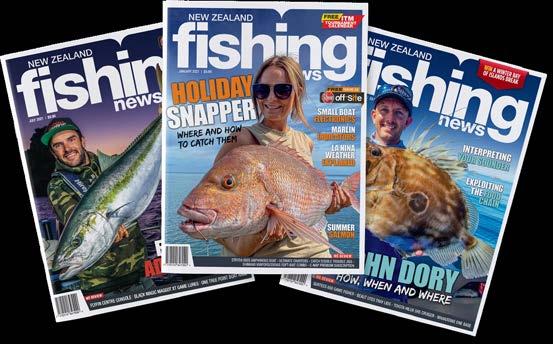









50 Aaron Styles: Mixing business with pleasure

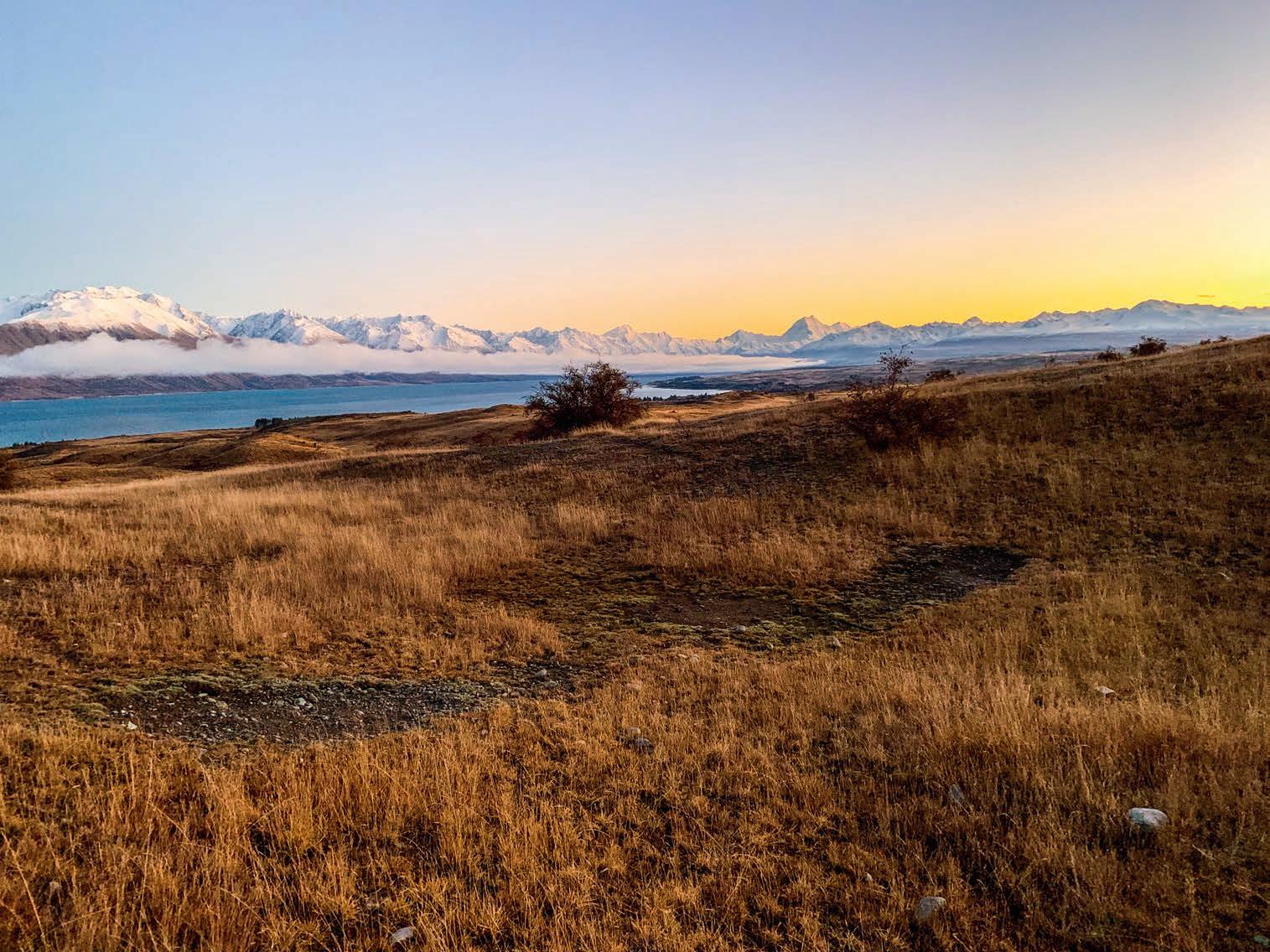
























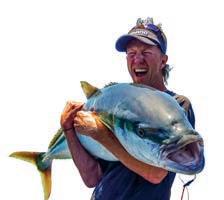

75-115hp FourStrokes offer 2.1 litre displacement providing superior mid-range fuel economy, quick acceleration with smooth overall operation and sound quality... along with the lightest weight 115hp available.
• Unbelievable Power and Torque
• Lightweight and Compact Design
• Outstanding Reliability
• Low Maintenance
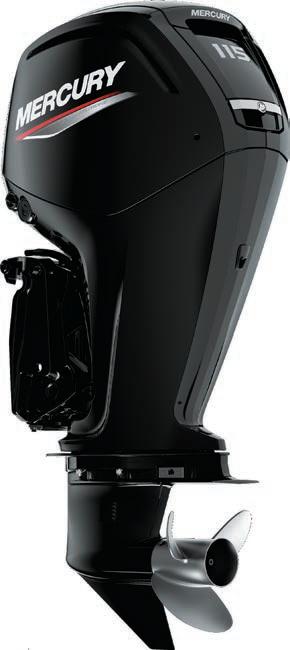




Welcome to the August edition. While the weather may be cooler, the recreational fishing political scene is certainly warming up if social media postings are anything to go by.
Firstly, the much-debated Motiti closure under the Resource Management Act has many stakeholders’ blood boiling, and among these is a strong Maori element who claim they were railroaded by Messrs Sayers and Co.
The closed court proceedings that led to these closures were nothing short of a mockery. Poorly publicised, the deal was done and dusted with little or no public consultation, and before you could say marine reserves, we had one – just under another name and set of laws.
Unfortunately, it has set an ugly precedent for other areas to follow, and it will be 10 years, so I am told, before any review of the marine protected areas’ boundaries are made.
Then came the Hauraki Gulf plan which intends – it is not quite a done deal yet – to create no less than 11 no-take reserves within the great Hauraki Gulf areas.
We have had little or no input into this, but the fishing industry did, and at the top level with Seafood NZ’s CEO involved as an advisor. He’s a skilled negotiator who has served his masters well – all except the cray fishers who must be spewing at the proposal.
If you go back to Ethan Neville’s interesting feature on Hauraki Gulf crayfish earlier this year, his commercial hosts on a three-day trip clearly demonstrated there
was plenty of stock there for everyone to have a share – you just had to know where to look.
Trawl ‘corridors’ will be set up throughout the area, but in effect there is little change from the status quo. The group that has probably had the greatest effect on fish stocks has been able to limit the damage, whereas recreational fishers who have undertaken bag reductions and size increases in recent times to do their part for the stocks, have once again been left swinging on the hind tit.
Little or no thought has gone into the placement of the no-take reserves. The eastern seaboard of the gulf is prime small-boat territory. The proposed areas are in the main protected from the prevailing westerly conditions, making them ideal for kayakers and land-based anglers.
Wider out, the Mokohinau Islands are in part included in the no-take zone. These are 31 nautical miles from the nearest launching spots, so their remoteness and the weather help reduce the fishing effort considerably. They are a bucket list destination for many anglers and some of the best grounds will be closed to fishing.
The changes only go a small way to dealing with the problems. Cutting recreational fishers out of areas only puts pressure on the grounds outside of those boundaries. And the no-take areas do nothing to prevent pollution from land run-off which does more to degrade the fishery than recreational fishers alone.
And then there is the scallop fishery and bottom dredging. The plan proposes to ban recreational

dredging, allowing handgathering of the delicacy only. I don’t know how many readers have seen what the bottom looks like after commercial scallop fishers have hammered a bed with their heavy box dredges? I have. I saw the destruction – and that is not putting too much of an emotional spin on it – of the Bream Bay bed a few seasons ago. You had up to a dozen boats working grid fashion over the area for several weeks. A bed that was very productive from a recreational diver’s perspective ended up looking as though the Silver Plough competition had been held over it.
Even when the crews were telling the companies the ground was no longer economically viable, they were told to keep ploughing. It still hasn’t recovered today.
I have been very restrained in my comments – you should have read the first draft! – but when the chance comes to have your say, take the opportunity to make your voice heard.
Tight lines, Grant

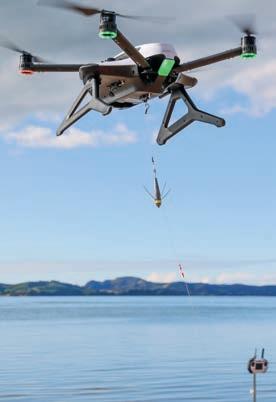
Rippton drones are the new sponsors of the Landbased & Surfcasting forum on The Fishing Website. The forum is the new home for Kiwi drone anglers to share fishing reports, locations, catches, tips and tricks, whether you prefer to cast your line from the rocks, launch a longline with a kontiki, or fly your rig with a drone.
The Rippton Mobula drone is one of the largest on the market, with an impressive 2.5kg payload, autopilot flight range up to 1.5km and is fully automatic with its simple to use app. Rippton representative Shawn Sangster regularly shares updates on the forum, alongside details of the latest Rippton Mobula demonstration days around the country.

Scan the QR code with your smartphone to visit the Landbased & Surfcasting Forum on The Fishing Website.

After four years of waiting, the muchanticipated plan for the future of the Hauraki Gulf Marine Park/Tikapa Moana/Te Moananui-ā-Toi (the Gulf) was announced in mid-June.
Over the next three years, the Government will create 18 new marine protected areas, confine bottom trawling to established “corridors” and freeze the footprint of commercial scallop dredging in existing areas, as well as ban recreational scallop dredging altogether.

Of the 18 proposed marine protected areas, 11 are what have been called “high protection areas.” The exact restrictions in these areas are yet to be confirmed, but the Sea Change Plan Type 1 protected areas they correspond to proposed a complete ban on fishing. To many angler’s dismay, the protection areas are around some of the most popular and accessible fishing destinations in the Gulf, including the Mokohinaus, Tiritiri Matangi, Kawau Bay, Rangitoto and Motutapu, and
the Aldermen Islands.
The 144-page proposal also includes strategies to develop the aquaculture industry, better manage marine biosecurity and endangered species, improve governance arrangements in the Gulf, and work with mana whenua and local communities to establish Ahu Moana pilots (manu whenua and community co-managed areas).
Minister for Fisheries and Oceans David Parker believes this plan will build on the “good work already being done to restore the health of the Gulf.”

The

“We are also taking the long view, recognising that sustained action is necessary to ensure that the Gulf and its economic, environmental, cultural and social benefits can continue to be enjoyed.”
Acting Conservation Minister Ayesha Verrall, who released the report along with Parker, emphasised that this package “works for all.”
“We’ll be seeking further input from mana whenua and engaging with key stakeholders to make sure it’s done right.”
“We know we’ve got a lot of work to do to ensure the vision of a revitalised Gulf comes to fruition, but by working together we can achieve it.”
The Government’s Strategy comes as a response to the 180
recommendations made by the 2017 Sea Change Marine Spatial Plan, which itself was another four years in the making. The 14-person stakeholder group was formed in 2013 in response to the substantial decline in the Gulf’s health, and now in 2021 we have a path forward.
So, what does everyone make of it?
For most conservation groups, the Government’s strategy represents a step in the right direction.
“It’s encouraging to see this Government finally turning the tide on ocean protection, both with the anti-dumping rule last week and now this to help the Gulf thrive again,” Jessica Desmond from Greenpeace Aotearoa commented.

“We know that bottom trawling is hugely damaging to ocean health and biodiversity. It’s great to see that this practice will be restricted in more areas of the Gulf to allow marine life to recover.”
Livia Esterhazy from WWF NZ was equally positive, but also believes that more radical change will be needed in the future.
“While we applaud this crucial step forward, more action is needed. For Tikapa Moana to recover and thrive, our government and other key stakeholders must work to protect at least 30% of the Gulf in true partnership with tangata whenua.”
Hauraki Gulf Forum Co-Chair Tangata Whenua Nicola MacDonald agrees, remarking
that “this is an important first step toward the Forum’s ambition for at least 30 per cent marine protection to restore the mauri of Te Moananui-ā-Toi, Tikapa Moana.”
However, a plan like this can never be met without some controversy, and the dissenting voices have so far come from one sizeable group: recreational anglers. The Hauraki Gulf Marine Park is one of the most popular playgrounds for the everyday fishers, divers and boaties, and is also a major source of kaimoana for coastal communities in the area – but some of their hotspots are about to become off-limits.
According to LegaSea spokesperson Sam Woolford, recreational fishers are willing to make sacrifices to see the Gulf


restored to health, but there are a few elements of this plan that are concerning.
“I thought it was quite shocking that the minister had the tenacity to give a free pass to the commercial industry for scallop fishing but ban recreational dredging. They’re talking about a freeze on commercial dredging – but that existing footprint is the Coromandel area. The Government has not listened to the local communities.”
Many recreational fishers, on the other hand, have already voluntarily given up recreational dredging, and popular retailers Hunting & Fishing and Burnsco haven’t sold recreational dredges for years.
For Sam, the same logic is true of the “trawl corridors”.
“If we’ve established that bottom trawling is not okay, then how is it acceptable to move the current area to a fixed corridors without reducing the
quota? These trawl corridors will never recover. Where are the conversations around the stock limits and quota limits? They’re still purse seining and there’s no reduction in quota.”
These sentiments are shared in part by the Hauraki Gulf Form’s co-chair Pippa Coom.
“The forum’s position is clear: bottomimpact fishing methods like dredging and trawling should be removed from the entire Marine Park.”
“It is important that the Government’s Sea Change response creates a mechanism by which existing proposals can be upgraded, and new proposals considered.”
Thankfully, it does appear that this will be the case. The plan is to be implemented over the next three years, and there will be opportunity for the public to submit feedback on the proposals.
– Ethan Neville
The Dunedin coroner A.M. Cunninghame found that a combination of alcohol, an inability to back a trailer and an unstable riverbank were all factors that lead to the accidental drowning of an experienced whitebaiter at Waimakariri River in September 2017.
The victim, who had been drinking alcohol, was setting up her whitebait trailer at the edge of the Waimakariri River at Kairaki Beach, alone and in the dark. Her judgement and perception were impaired due to intoxication.
The woman could not back the trailer to the water’s edge, so to position it, she drove her vehicle so close to the edge that its bonnet was over the water. At this point the river dropped off steeply – 20 degrees at its worst. After uncoupling the trailer, the victim returned to her vehicle and started it. It then began to slide forward, and she was unable to stop the vehicle going into the river where it filled with water, and she could not escape.
Having made the above conclusions about Ms Wood’s death, the Coroner made several recommendations around two key issues – (a) The risks that arise from the combination of drinking alcohol, and/or using vehicles while fishing; and (b) The placement of warning signs at the Kairaki Beach carpark.
“If whitebaiters need to use vehicles to get their gear close to the water, they must ensure that they can do so safely. Driving off-road near water, and in particular, on sand or on unstable lake edges or riverbanks, can be dangerous. The speed at which the victim’s vehicle sank into the river after the bank collapsed illustrates how quickly even a minor misjudgement in the positioning of a vehicle can result in tragic consequences,” Coroner Cunninghame stated.
“I do not need to repeat what is known about the risks of driving while intoxicated in these findings. The victim was significantly over the legal blood alcohol limit. She should not have been using her vehicle. However, because using vehicles near water is risky at the best of times, recreational fishers and whitebaiters should avoid drinking alcohol at all if they are intending to use their vehicles near sandy or otherwise unstable water edges.”
The Coroner also contacted the Waimakariri District Council who agreed to amend signage at Kairaki Beach to highlight the dangers that existed in the area.
– Grant Dixon
Trawlers will be confined to “corridors” in the Hauraki Gulf.

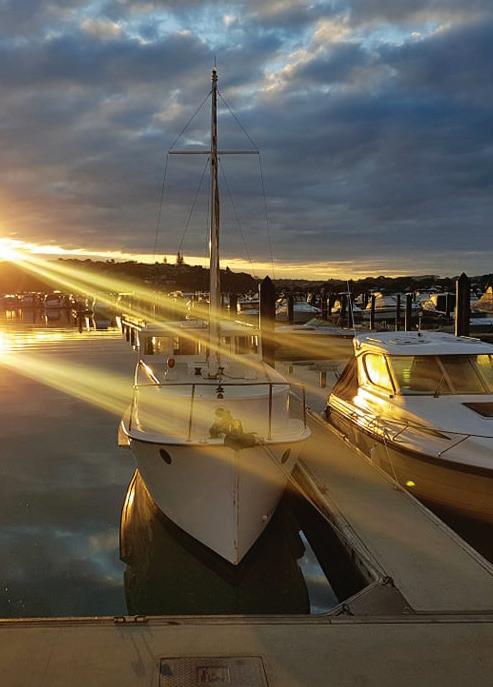


Earlier in the year, the magazine, with assistance from some great operators, put together a ‘Bay of Islands Winter Getaway subscription prize’. It was won by Te Awamutu agricultural contractor/farmer Lance Gower who, along with wife Melissa and friends Craig and Paula Foote, ventured to the ‘winterless’ north for an elongated Queen’s Birthday weekend break. Melissa tells their story…
We drove through intermittent torrential rain for five hours heading north; I was convinced it was a scam. There is no way we could have won seven nights’ accommodation at Club Paihia with two double parasailing passes, boating excursions, a fishing tackle goodie bag and a chartered fishing trip! But when we arrived, we were handed a key to a gorgeous two-bedroom hilltop apartment nestled among the trees for us and our Wharepapa South neighbours. The kitchen was bigger than ours at home and there was a bubbling spa just waiting to be enjoyed. It then rained for three days,
but we didn’t mind. It was warm here in the Winterless North and we were excited to have escaped the farm and spend time relaxing, reading books, playing card games and chilling in the spa. We squeezed in bush walks between the showers, which involved hugging kauri trees and getting lost staring up at them in awe of the simplicity and beauty of nature. In Karikari, we found perfect empty beaches and strolled along, scrunching the wet sand between our toes. We even spent an afternoon sheltering from the rain at a local brewery experimenting with a range of craft beers, ales and cider.
We became tourists, exploring Paihia and loving the novelty of

walking to town. We checked out the cool nightlife and the little quirky shops hiding amongst the bustle of Queen’s Birthday tourists, offering Ugg boots, raincoats, the usual Kiwiana memorabilia and sweet fudge.
We hopped on the ferry to Russell where the sun was shining, but the rain followed us throughout our self-guided history tour. We joined in a quiz night at the local club and took out second place – not enough to score a $70 bar tab, but a fun night nevertheless.
Then the weather broke, the sun exploded and the sea calmed, so we went parasailing. Our nerves were on edge as we floated high above the everything and saw another side to Paihia. It was beautiful, tranquil, quiet and peaceful.
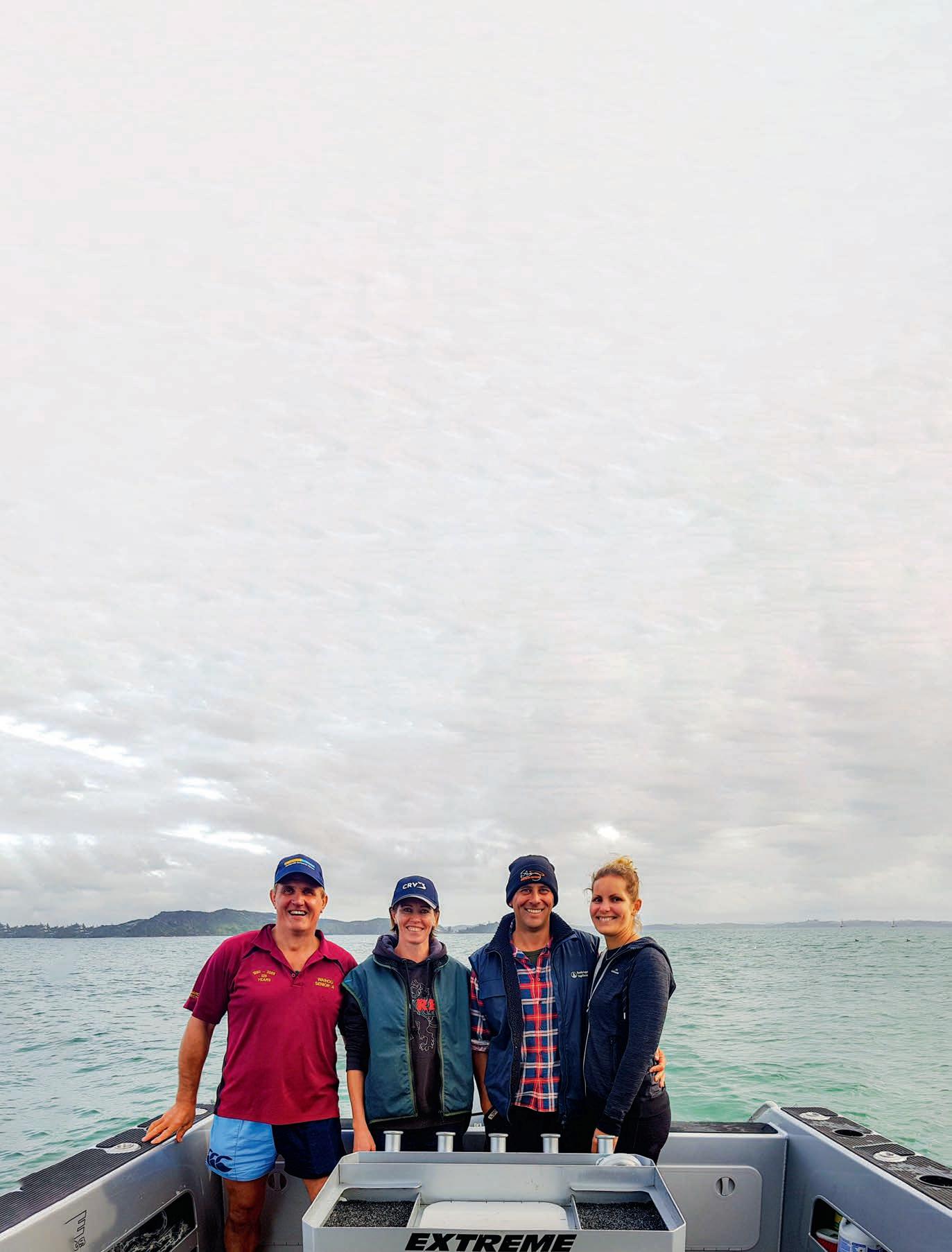
The following day, our last day, we finally got out fishing. We caught our own bait, and watched the sun rise spectacularly. Our awesome captain Darren shared history and gossip with us as he baited our hooks, filleted our fish and served us ‘homemade’ white chocolate mud cake. We may not have caught the largest fish out there due to the weather conditions, but we had enough
NZ Fishing News would like to acknowledge and thank…
• Bill O’Meara and Friends of Club Paihia for arranging the accommodation.
• Darren and Sheryl Knapping of Fishing Days Out Charters for providing the fishing and helping pull the package together – www.fishingdaysout. co.nz
• Eddie Warehou of Explore Group for putting up the excursions – www. exploregroup.co.nz/ destinations/bay-ofislands
• The team at Flying Kiwi Parasail for the airborne adrenaline – www. bayofislandsparasail.com
• John Donald at Catch! Fishing for providing the tackle bag loaded with Catch! lures and product – www.catchfishing.pro/ catch-products/
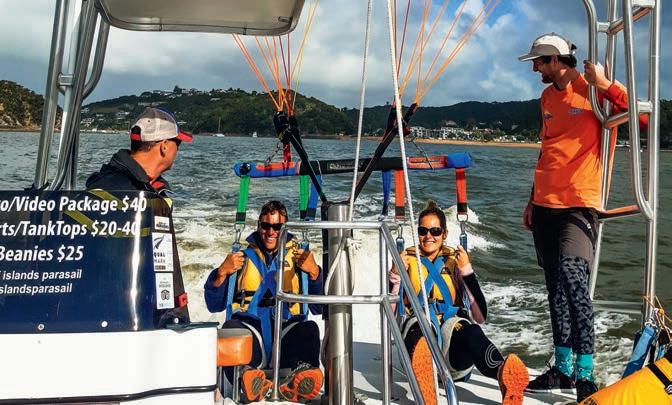
snapper and kahawai to share with our kids and had a blast.
A final dinner out and a drink with Grant and Faith Dixon spent swapping boat engine nightmares and fishing stories finished off our trip beautifully.
Sadly, our ‘dolphin sightseeing’ and ‘hole in the rock’ trips were unavailable due to the weather,
out again – you have a special place in our memories.
Thank you so much to NZ Fishing News for giving us this treat – we never would have allowed ourselves to have a holiday like this, and we really do appreciate it.
– Melissa Gower, on behalf of prizewinner Lance Gower, and

Why not consider Bill Hohepa as your next guest speaker at your function, or perhaps as your guest speaker for your fundraising effort.
To book Bill you can email him at: Billhohepa@xtra.co.nz





AHigh Court decision made in mid-June will force the Government to reconsider their 2019 tarakihi catch limit decisions.
Forest & Bird took the Government to High Court over their decision to reduce the tarakihi rebuild plan period below the default length, and on June 16, the court ruled in their favour. The court even agreed that the Industry’s Rebuild Plan was a key factor influencing Minister Stuart Nash’s decision.
The drama started in 2017 when the first fully quantitative assessment of the tarakihi east coast stock was undertaken – and the results were a little frightening. The stock was sitting around 17% of its original unfished biomass, and the news only got worse in 2018. The commercial fishing industry funded another comprehensive study, and 17% turned into 15.9%. This meant that 84% of all tarakihi had been removed from our east coast
waters. 15.9% is also below the Government’s “soft limit” for fish stocks, which means, in their own words, the “fish stock is considered to be overfished or depleted and needs to be actively rebuilt.”
Their response was to cut the commercial quota by 20% in 2018 to “minimise the risk of reducing the stock below the hard limit” and they also noted that “substantially larger reductions in catch are required to rebuild the stock to the 40% SB0 default target level within a 10-year period.”
After liaising with industry, the default plan changed considerably. The quota was cut by only a further 10% in 2019 and MPI also accepted industry’s 2019 Eastern Tarakihi Management Strategy Plan. This set out a 20 year plan to build the stock back to 35% of unfished biomass.
That’s a 5% lower goal over double the period of time.
Forest & Bird recognised this was problematic and consequently
took the Government to High Court over their decisions.
The recent High Court decision confirmed Forest and Bird were right to question the Government’s strategy. The then Minister of Fisheries set the tarakihi commercial catch limit inappropriately in 2019 by factoring a voluntary industry fishing plan into the decision while ignoring his Ministry’s own policies.
“The High Court has confirmed fishing decisions must put sustainability before the commercial interests of the fishing industry,” says Forest & Bird Chief Executive Kevin Hague.
“This is a victory for everyone who wants to bring back healthy ecosystems, and end inappropriate decision-making that favours commercial fishing industry interests at the expense of nature.”
“The Industry Rebuild Plan shouldn’t have been allowed to replace an appropriate catch limit. There is no way to determine what
impact the industry plan will have, because the plan is voluntary.
Fisheries NZ’s own advice was they weren’t sure whether the Industry Rebuild Plan would deliver an accelerated rate of rebuild.”
The current Minister will now be forced to reconsider the tarakihi rebuild strategy and find a new path forward so this species can recover.
“The Government must now use a scientific, legal approach to managing fish stocks, rather than relying on voluntary plans, and uncertain outcomes offered by the industry,” Hague continues.
“It’s a disgrace the tarakihi stock of the entire eastern coast of the country has been fished down to just 15% of their natural population.
“The Fisheries Act is far from perfect, and it needs a significant overhaul to bring fisheries management into the 21st century, but even under the current system, fish stocks should be managed sustainably.”
– Ethan Neville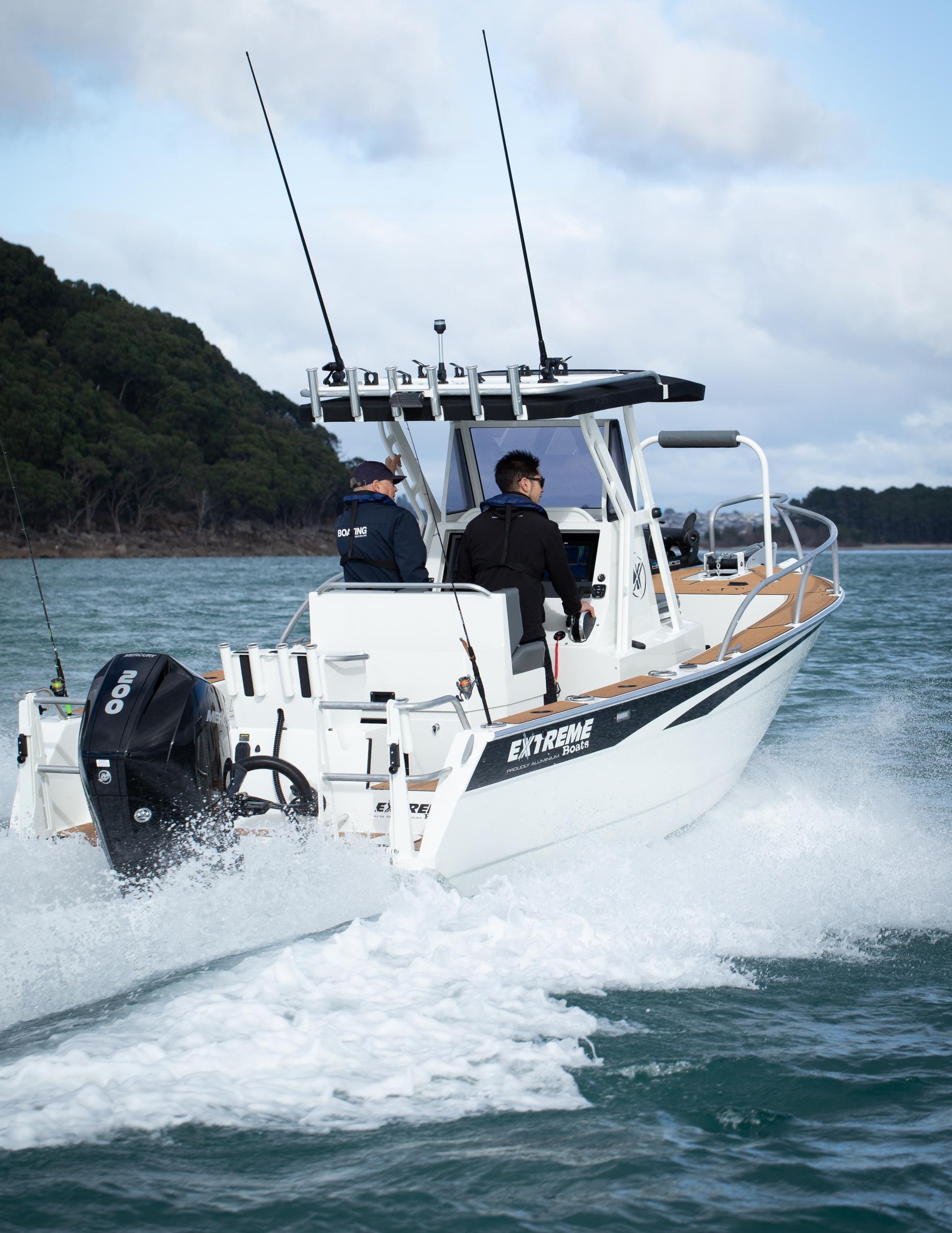




Greenpeace is welcoming the recent Government announcement to end fish dumping and discarding but says cameras on the full commercial fishing fleet is essential to ensure this regulation is followed.
Russel Norman, executive director of Greenpeace Aotearoa, says the move requiring all fish caught to be landed shows the Government is serious about increasing ocean protection, but that more must be done.
“Over the years we’ve seen repeated scandals with illegal widespread fish dumping by the industry. Every year hundreds of tonnes of fish are dumped dead or dying back into the ocean. This new measure is a step in the right direction to tackling that.
“But without a more comprehensive cameras on boats programme the industry can continue to operate out of sight, out of mind. Quite simply, we need cameras across the board to ensure compliance.
“30,000 New Zealanders have signed a Greenpeace petition calling for cameras across the commercial fleet. It’s time the Government listened to them.
“To ensure this measure is effective the fishing industry must not receive any increases to quota. Otherwise the benefits of the no dumping policy will be entirely negated.
“We know that to protect the health of the ocean, we need to change the way commercial fishing operates. The no dumping policy is a great step towards that, but more is needed.
“The waters of Aotearoa are home to an estimated 80% of our biodiversity, and to species that are found nowhere else. It is essential we protect them for the future.
“For a healthy planet we need a healthy ocean. It regulates the climate and provides the oxygen we breathe. The Government must continue to increase their ambition around ocean protection if we’re to protect it for us and future generations.” – Greenpeace
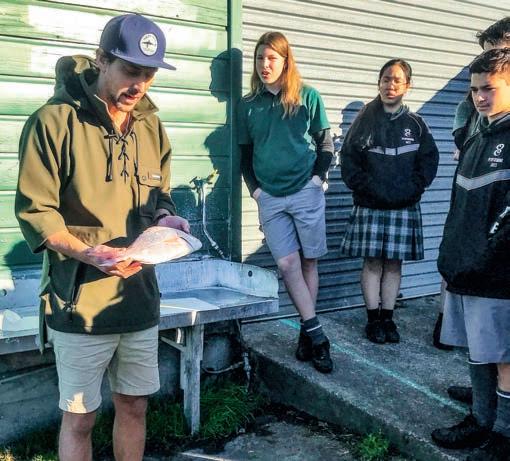
Conservation is part of the programme where students learn about sustainably fishing for popular stocks like snapper.

Orewa College on the Hibiscus Coast, just north of Auckland, has a natural synergy with the coastline and the sea. They have capitalised on their location, with students learning to sail, paddleboard, kayak, surf lifesave and now fish.
At this stage they have not incorporated the actual ‘catching’ of fish into their curriculum but intend to expand into that region shortly. A year 10 class called 10PBL (project-based learning) of about 40 students is doing a programme called ‘Love your Coastline’. The class was organised by Joel Dickinson
(Outdoor Education) and Matthew Harrison (Geography) and is currently running for one term.
Sustainable fishing is a large part of the focus as it is seen as part of the community culture.
“We look into what lives in our area, from eels in the streams and flounder in the estuary to snapper in the deeper water. We look at the laws around fishing and students make additional laws that could prolong recreational fishing. We focus on the ‘how to fish,’ not on the ‘not to fish’,” Joel Dickinson says. The school has been supported by the local fish
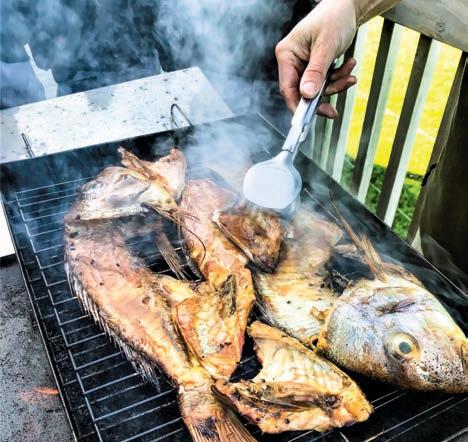
store Oceanz Seafood in Silverdale who supplied fresh snapper for the class, so they had a close look at the anatomy of the fish while learning how to fillet.
“But mostly we are looking at why we catch them (and eat them) and how to get the most out of a fish and not waste them. We made sashimi, we fried fillets and then we smoked some as well.”
The students were involved in every step of the process from scaling to eating. There was little more than a handful of waste left over, which was then used as fertiliser.
“The level of enthusiasm, engagement and simple high



interest of the students has given the staff the idea to expand the fishing model even further.
“The success of the fishing component of this unit has given us the motivation to branch out to subjects like hard tech (woodwork, metal
work) where we can create a full unit completely around fishing and the different sustainable techniques. Students will build things like Hawaiian slings, lures and smokers.”
Watch this space.
– Steve DickinsonOne of the first things students learned was that fish makes for tasty kai and is a healthy
“Sustainable fishing is a large part of the focus…”

 The Orewa College students enjoying the fruits of their labour.
option!
The Orewa College students enjoying the fruits of their labour.
option!


Under the dome – winter high pressure systems can make for glass calm early morning conditions.
After a mild start to the winter, the cold weather is finally here. Sam Mossman offers some tips for catching that fishing favourite, the snapper, during the cooler months.
Fishing for snapper in winter is usually slower than in the warmer months and most fishermen are happy with modest catches at this time of year. But winter fishing is also more challenging and interesting, and the sense of achievement is greater when you are successful and can put a feed of fresh fish on the table at this time of year.
I enjoy winter snapper fishing. With shorter days I don’t have to get up so early to fish the dawn and the same applies in the evening – I can fish the change
of light and still be home and cleaned up at a reasonable hour. A lot of people stop fishing in winter too, making it easy to get a park at any ramp, any time, and there are no queues to launch and retrieve either. (Yes, OK, while this article is encouraging winter fishing, I’d actually prefer it if not too many anglers take up the challenge!)
When water temperatures drop over the winter months, it affects snapper in several ways. The first is in distribution: the shallower inshore regions have more of their mass exposed to the surface, so chill down (and warm up) more quickly. When the water cools down the majority of snapper move from shallow out to deeper waters, where the greater water mass holds the temperature up a bit better. For example, the following are some ballpark figures for annual temperature variations in different regions of
the Hauraki Gulf:
• Inshore variation: 12 degrees
• Central area variation: 7 degrees
• Outer region variation: 5 degrees
So, you can see that water temperatures are much more stable in the deeper water than in close to the coast. Generally, snapper in the north do not move so far or for so long as in the colder southern parts of their range.
The degree of movement seems to vary a bit depending on the severity of any given winter, too.
I can remember some very cold winters when I first moved to the Hauraki region 40 years ago when the inshore water temperature dropped to around 11°C. Then, the snapper seemed to be nonexistent in inshore waters during the core mid-winter months. Recent milder winters have seen better numbers of snapper lingering in inshore grounds.
A second variable affecting snapper distribution in the colder months is the size of the individual snapper. The law of thermal mass means that the bigger a fish’s body is, the more heat it can conserve and the colder the water it can stand. Consequently, more smaller snapper move out to deeper water than big fish when the water gets cold. Although there are still some small fish about inshore in winter (mainly in the medium depth channels (15-25m), this thermal sorting-sieve will help you catch a better size of fish, on average, in winter.
There are several places to concentrate your search for inshore winter snapper in the north.
• The biggest fish will often be tucked up in areas of shallow foul (say 2-12m) with plenty of rocks and weed.
• ‘Funnel’ areas where there is good tidal water movement (e.g. channel edges) in 12-25m can hold reasonable numbers of snapper in winter as there is always plenty of food to be had.

• Fish sometimes hold in shallow reef country near river mouths and in harbours in winter. They can feed well just after a winter flood has flushed out a lot of food and the water salinity is starting to return to normal. A couple of tidal sequences after the rain stops can be a good time.
• A storm smashing into a rocky coast will break up and disturb lots of food items. Try for big fish in close right on the heels of a storm. Don’t risk dangerous conditions, though.
Colder winter water temperatures slow the metabolism of snapper, making them much less interested in feeding at this time. They may only come on the bite for short periods (the length of the ‘bite time’ is much reduced) and even then, they seldom feed very aggressively, often toying and picking at baits. These fish can be frustrating to fish for, and a change of tactics may be required.
• Berley can help get fish interested in feeding and tempt them out of the heavy foul to where fishing for them is more
Sometimes the weather is not that flash but if you dress for it, the fish are still there.


practical. However, if there is likely to be a barracouta presence in the area you are fishing, berley can be counterproductive. If you do decide to use it, release it hard on the bottom for minimum snake attraction.
• In winter, snapper often play with the bait for a long time before they take properly and move off. This means that tough baits that can take a bit of a mauling and still stay on the hooks are required. Favourites that have produced the goods for me are salted skipjack or cut baits from freshly caught whole jack mackerel.
• In inshore shallow waters, use a strayline rig with the least sinker weight and lightest line and leader that you think is practical. Monofilament can be an advantage over braid as the stretch means fish are less likely to feel the line. Likewise, smaller baits can be more effective as they are more easily taken by picky fish. A halfmatchbox size is about right.
• Let the fish run – resist the temptation to strike until the fish has finally taken the bait firmly and started to move off.
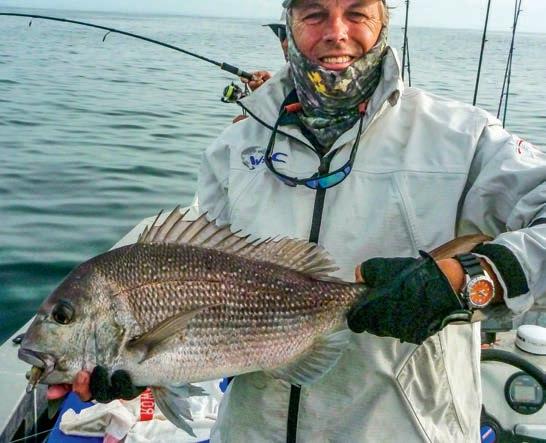
• Use sensitive tackle and treat every tiny nibble as a decent fish. Regularly, the very lightest bites are from the biggest snapper.
• Often the fish will only bite for a very short period of time and you must take advantage of this. Check the advertised bite times (try www.fishing.net.nz/ bite-times), change of light, and appropriate tide periods and plan to be on your spot and ready to go at the right time. You must make maximum use of the short feeding time, so have back-up tackle ready to go should you get snagged or
• There are big fish in the shallows, but they are not in great numbers and they are not feeding aggressively. Wrap up warm, take a thermos flask and be prepared for a long wait between bites if bait fishing in skinny water. Keep noise and vibration to a minimum.
The weedy, rocky inshore zone ordinarily gets little pressure –most boats won’t go right into the shallows, often preferring to use berley to try and entice the fish
bitten off. Grub tails have plenty of action at low speeds and are a good choice for inshore winter snapper.Sensitive rods will help detect subtle bites from winter fish.

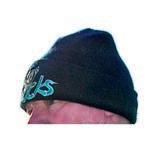


that has dipped into the weed. A sharp jerk will usually tip the jig up and it will pull free.
• A ‘Texas-style’ rig with a worm hook and sliding head weight can be rigged ‘weedless’ too, with the hook point skimmed just under the surface of the tail and popping up under the bite of a fish.
• At this time of year, sluggish fish require slower retrieves. I prefer smaller tails that fussy fish can inhale easily (4” is a favourite) and one with lots of action at the slow retrieve speeds required, such as a grub tail. Natural colours such as greens and browns work better for me than some of the eyewateringly bright models.
out of the inshore foul.
Fish tucked up in this heavy country in winter are often not really in a feeding mood for much of the time but will snap at a well-presented soft-plastic lure. In these shallow areas, the fish feel exposed and are more comfortable in times of low visibility such as first and last light, or when there is a heavy shadow cast by the land (or a heavy overcast sky). A decent white-water wash for the fish to hunt under can offer cover and this usually means turbulence that will expose food for snapper as well. For these wary fish, approach quietly and cast well away from boat.
• Standard soft-plastic tackle includes a spin rod and reel loaded with braid rated around 4-6kg (although it may well break at considerably more than this). Braid copes well with weed, often cutting itself free if snagged. In gnarly terrain, working the lure a little above the bottom helps reduce tackle losses (lighter heads come into their own here, as they don’t sink so fast), and lead-head jigs ride hook point up, reducing snagging further.
• Often, if you do hang up, it is just the nose of the lead-head
To prevent too much angler suffering, dress for the weather. Early mornings can be damn cold, especially when you add the wind-rush factor of travelling in an open boat or a sea breeze. Layer up with multiple levels of winter clothing, with the top layer being a windproof garment, such as a parka. This way you can stay comfortable by shedding layers as the day warms up.
Gloves will help keep the hands warm while traveling (you will probably have to take them off when you start fishing) and sunnies and a neck gaiter will help cut the wind-rush on your face and stop your eyeballs freezing. East-coast fishermen are often heading directly into the rising sun and will need sunnies anyway. A hot drink in a thermos can be a life saver, too.
If you can bear the pre-dawn cold, get out there early and you can be home, usually with a feed, by midday. This leaves plenty of time to wash the gear and process the catch. If you prefer to fish the other end of the day, the good news is that in winter night comes early, so when the bite stops or darkness comes, you can knock off and be home at a reasonable hour to warm your feet by the fire and hopefully work your way through a feed of freshly caught winter snapper!
 White knuckle fishing. In winter, sometimes the lightest bites can be from the biggest fish.
White knuckle fishing. In winter, sometimes the lightest bites can be from the biggest fish.

WHERE SOME SEE FLOCKS, YOU SEE FISHFINDERS.



If you’re looking for a trophy trout, there’s no better place to go than the Tekapo-Twizel hydro canals. But as experienced angler John Eichelsheim found out the hard way, catching them requires overcoming the freezing conditions and having near-perfect technique. He shares the story of his trip down south…
An old fishing buddy, Mark Kitteridge, had a very significant birthday last year. Amazingly, he managed to convince both our wives that allowing the two of us a few days at the hydro canals of the Mackenzie Country chasing
trophy trout would be a good way to celebrate.
Unfortunately, Covid-19 got in the way and a subsequent attempt a few months later was stymied when Mark broke his foot! But fast-forward to late June 2021 and the pair of us belatedly boarded a plane for the South
Island, almost one year after our first attempt. Happy birthday Mark!
The Tekapo-Twizel hydro canal complex has become perhaps the most publicised freshwater fishery in New Zealand. Containing huge brown and rainbow trout, as well as lots of
salmon, it is recognised as the best place in the country, maybe the world, to catch trophy trout. Fish over 10kg are commonly caught and 15kg-plus specimens are sometimes landed. Trout estimated to weigh in excess of 20kg can be seen swimming below the hydro dam tailraces.
Ten or 12 years ago, when this phenomenal canal fishery was being ‘discovered’, the fishing was by all accounts considerably easier. Angling pressure was light and fish were relatively naïve, which made them susceptible to a wide range of lures, baits and fishing techniques, especially the escaped salmon hanging around the salmon farm cages.
These days the fishing is quite a bit tougher, with educated fish that have seen plenty of lures and baits and many, many more anglers on the water.
We’d talked about fishing the canals for years. Once upon a time we’d done a lot of trout fishing together, but for the last 20 years trout have barely featured. We are fly-fishers, but fishing the hydro canals is predominantly a spin-fishing gig. That didn’t faze us too much,

especially since we both have extensive soft-baiting experience and fishing soft-baits was reportedly very effective. We fancied our chances.
The primary method, however, is a technique called egg rolling – trotting trout egg patterns downstream on lightweight braid with fine diameter leaders and slip-sinkers weighing just enough to allow the eggs to drift naturally with the current.
It sounded simple enough, and quite similar in principle to indicator nymphing with globugs on the Tongariro, with which we were familiar. Although a bit rusty, Mark and I felt up for it. How wrong could we be!
Joined for the weekend by another old fishing mate who now resides in Central Otago, we started fishing bright and early on Saturday morning, choosing a stretch of canal beside one of the salmon farms. Anticipation was high and we Aucklanders barely found time to complain about the cold, though braided lines freezing to bail arm rollers was a
nuisance at first.
We spent the morning softbaiting and fish weren’t long in coming: two very small salmon for me and a fish lost, much bigger, to Mark. We’d been told about the importance of casting lures as close as possible to the salmon cages, but the slightest misjudgment would hang the lure on the cage structure. The tackle attrition rate was high, but we’d been assured short casts would get no bites.
Not that the bites came with any urgency. On the contrary, they were few and far between. But late in the morning, working my last three-inch translucent pink Z-Man curly tail grub, I hooked a decent fish. It showed itself immediately and I called it for a modest rainbow, but it gave me quite a battle in the swift current and for a while I struggled to keep it away from the cages. I reminded myself to get downcurrent so the fish couldn’t make use of the canal’s strong flow. The tactic worked and I was able to bring what I initially thought was a rainbow of around five pounds to the bank. As it turned out, while the fish was about the
right length to weigh five pounds, it was so deep through the belly and wide across the shoulders it was easily eight pounds. Not a Tekapo Canal trophy, but a nice fish nonetheless.
Sadly, I hung the lucky lure on a salmon cage the very next cast and afterwards, no matter what I used, I failed to contact another fish. The other guys fared no better. Mark and I were also a little surprised at how short the winter days are – arriving at 6:30am on the first morning meant struggling with unknown water in the dark for the first hour. And it was already too dark for us old fellas to tie on new lures by 5pm, not to mention bloody cold!
Another old fishing buddy joined us that afternoon. Fishing a slowly retrieved three-inch pink soft-bait, Peter Langlands was rewarded with a nice salmon, which joined him for dinner, along with another he caught later that evening after we parted ways.
Day two dawned foggy but a little less cold. We explored some of the other canals and fished different stretches of the canals we knew. We also tried

egg-rolling, which had sounded simple enough, but proved to require considerable skill.
I think it’s fair to say that in two and a half days of fishing eggs, neither Mark or I mastered the technique. It was only in the last couple of hours, after some pointers from local guide and hydro canal legend Ben Booth, that we finally began rolling eggs effectively. By then it was too late to save the trip.
But I digress. On day two we believed we were doing things
right and our morale was high. I hooked and landed a rainbow weighing a bit over a kilo on the egg-rolling gear, which encouraged me to stick with it for the rest of the day. Mark, too, managed a couple of small salmon, both well under legal size.
The other anglers around us (and there were plenty!) weren’t catching either – even the bait fishers soaking prawns or drifting pilchards under floats – so we weren’t alone. Poor Ian left for

home on Sunday afternoon having caught nothing…
The highlight of the trip was witnessing a huge trout landed from the tailrace at Glenbrook on Sunday. Justin had been fishing the tailrace pretty much non-stop for four days, swinging weighted homemade flies on spinning gear from the spillway wall.
He had his first and only decent bite just as we pulled up. As we exited our vehicle, what was
clearly a huge fish led Justin on a merry chase downstream, forcing him to clamber over concrete walls and wire fences to keep pace with the charging fish.
After maybe 20 minutes of seesaw battle in the strong current, Justin managed to bring the fish to the bank. It was the biggest, fattest rainbow any of us have ever seen. We guessed it weighed over 15kg, a guess later confirmed by Ben and others more familiar with such giant hydro canal fish. It was the fish of a lifetime for


“We woke up on the final morning feeling despondent and a little desperate…”
 Peter Langlands with a small but legal salmon. Tasty fare.
Peter Langlands plays his salmon.
The writer’s favourite canal.
The guys fished dawn to dusk, but the days were short.
Peter Langlands with a small but legal salmon. Tasty fare.
Peter Langlands plays his salmon.
The writer’s favourite canal.
The guys fished dawn to dusk, but the days were short.




10000PGA
RATIO: 4.9:1
CAPACITY: 50lb/ 350m
DRAG: 12kg
RETRIEVE: 94cm
WEIGHT: 675g
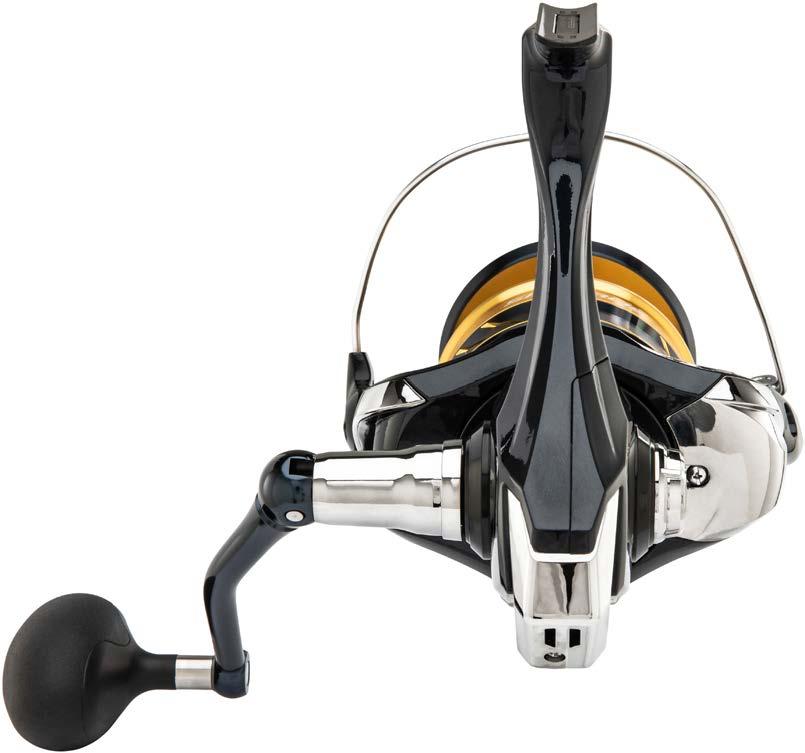

14000XGA
RATIO: 6.2:1
CAPACITY: 50lb/ 350m
DRAG: 12kg
RETRIEVE: 135cm
WEIGHT: 680g
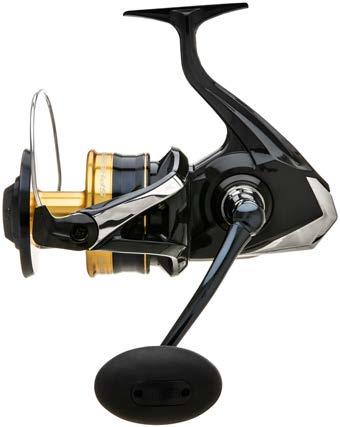
20000PGA
RATIO: 4.4:1
CAPACITY: 80lb/ 400m
DRAG: 18kg
RETRIEVE: 104cm
WEIGHT: 930g



“We can’t wait to go back, especially with our new egg-rolling knowledge.”
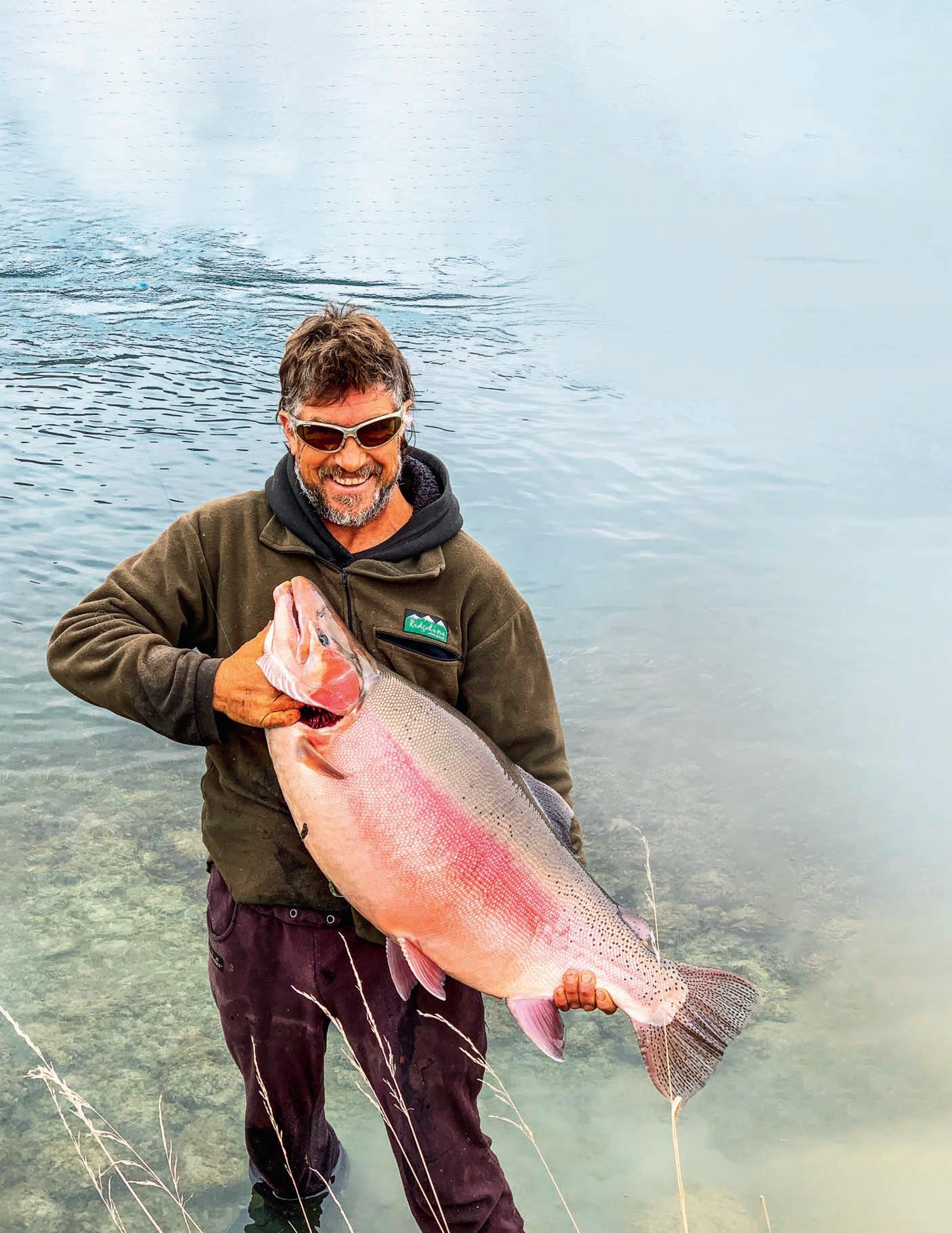
Alas, it was not to be. Days three and four were worse in terms of fish caught: a few undersize salmon for Mark and a couple for me, a couple of missed bites each and a bust-off on a soft-plastic. Note to self: don’t strike at bites as though you are snapper fishing when using sixpound leader.
We woke up on the final morning feeling despondent and a little desperate, aware we’d have to leave by 11:30am to catch our plane. But the morning was gorgeous – cold and clear –giving us unobstructed views of the surrounding mountains. It was hard to feel anything but gratitude for the privilege of fishing in such a lovely place.
Justin, well worth four days’ effort, and exactly the sort of birthday trout Mark and I were after. Justin with his 15kg trophy rainbow trout. Justin’s 15kg-plus of rainbow trout nears the bank, creating a huge bow wave as it attempts to escape. Others managed to catch fish.
The morning slipped away in the same fashion as all the others. I hooked a fish on an egg but dropped it early in the fight, Mark reported a bite or two and we walked for kilometres up and down the bank, trotting our imitation salmon eggs (we reckon we walked 12-15km per day), with nothing to show for it.
You are doing it wrong!
It was only when we came across Ben Booth and his clients and had a chat that the penny dropped: we’d missed the finer nuances of egg rolling. After three days of walking the bank, neither of us had the technique right.
Ben was generous with his advice: my fly was too big, the wrong colour and the wrong yarn, and apparently single eggs were the only way to go. Our rods, reels and rigs were fine (thanks YouTube), but our sinkers were too heavy; there was too much bow in our lines, creating induced drag, and we were allowing the terminal tackle to get ahead of or behind us as we walked – both were bad.
We were also casting too far, which meant the faster midstream current inevitably created a bow in the line.
The key, explained Ben, was to always keep the line taut and at right angles to the current.

Always keep a finger on the line to feel bites and if there is too much feedback from the bottom through the line, you are using too much weight.
The very first drift after Ben’s advice, I got a bite but missed the hook-up – I was so surprised I was slow to respond. It proved a point though, and explained why Ben’s clients were catching fish when we weren’t.
There is no happy ending to Mark’s birthday expedition. Time was up. He didn’t catch a single legal-sized fish and I probably didn’t catch any trout – of the two halfway decent fish I’d caught, the pictures show the big one was really a salmon and I now suspect the smaller one was too!
Although we lucked out on trophies, we agreed it had been a brilliant few days spent on an amazing fishery – a great way to celebrate one of life’s significant milestones. We can’t wait to go back, especially with our new egg-rolling knowledge. But next time we’ll go when it’s a bit warmer. I’m also told that softbaits work much better in spring and summer when trout are less preoccupied with spawning.
I’m sure there’s a big rainbow or brown still waiting for us in one of those canals.
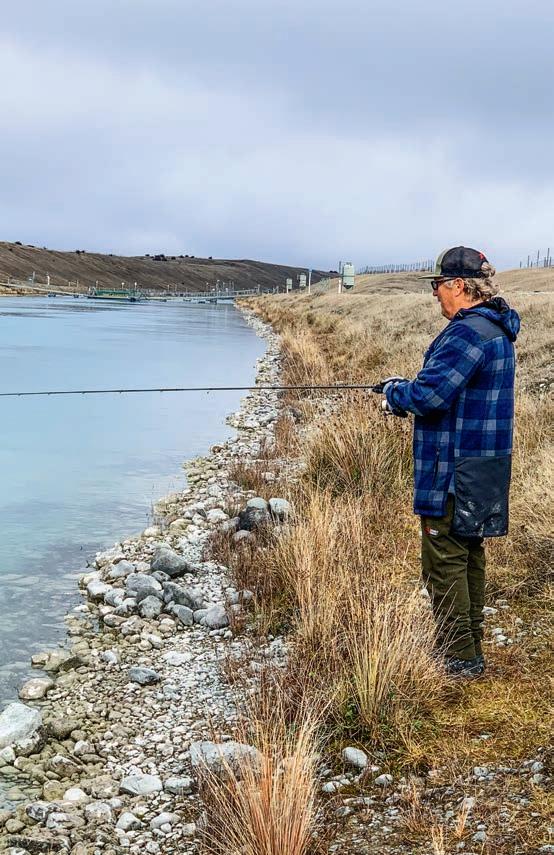
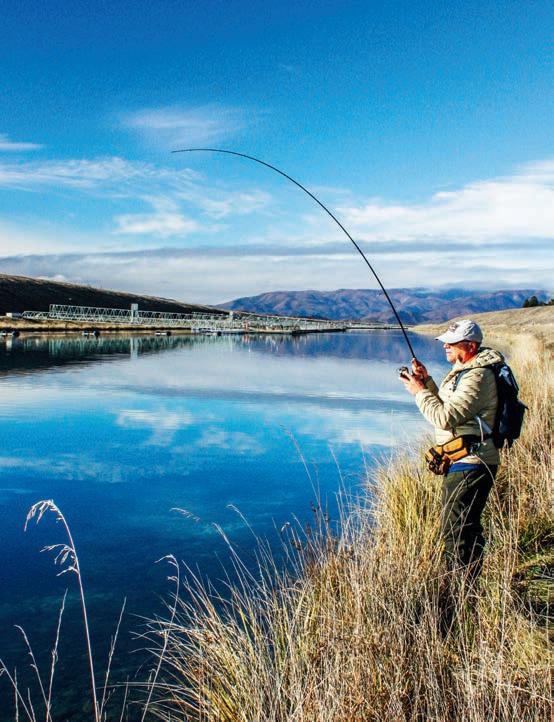
“Note to self: don’t strike at bites as though you are snapper fishing when using six-pound leader.”The writer hooked up to a 4kg salmon. The writer’s 4kg ‘rainbow’ which, upon examining the photo, is definitely a salmon. Mark and the writer fished long and hard for four and a half days. Unfortunately, they weren’t fishing the right techniques.


Keen soft-baiter and east coast fisherman Josh Darby recently took on the Kaipara for the first time and was absolutely blown away with what he found lurking in its shallows…
Iwas born in Dargaville and spent my formative years in Kaihu before our family relocated to the Whangaparaoa Peninsula. As a young boy, I enjoyed spending time attempting to catch freshwater eels and trout in some of the rivers and lakes that surrounded us. However, I never had the opportunity to venture slightly further afield and fish a little harbour close by known as the Kaipara. Okay, it’s not so little! At almost 1000 square kilometres, the Kaipara is one of the largest harbours in the world. Its channels and flats offer a truly diverse fishing landscape, where exceptional fishing can be experienced in knee-deep water, down to 50 metres. There are also a number of ‘arms’ that split off from the main body of water and stretch for many kilometres inland, ensuring you can find shelter no matter the wind direction. However, you will have to contest with incredibly powerful currents as water enters and exits the harbour
at an astonishing rate. At the entrance to the Kaipara is an area known as the ‘Graveyard’, which encompasses a treacherous body of water where over 40 vessels, with some estimates over 100, have met their end. Intimidating to say the least!
My Kaipara initiation began with a plan to fish the Far North for a few days in June this year. However, the forecast turned sour, and an alternative destination was needed. As fate would have it, a decent weather window on the west coast appeared and my cousin Eli, who lives in Tinopai, suggested I tow the boat there and we spend a few days fishing the Kaipara instead. I was a little hesitant at first, as I knew these fishing grounds were quite different than those I was familiar with on the east coast. I also knew that most people fishing the Kaipara, and indeed the west coast, used bait. That was a problem for me, as I’m a lure fisherman through and through. In fact, I don’t think I’ve had a true bait and berley session
for almost a decade. Luckily, I remembered reading on fishing. net of a gentleman by the name of Darren Faber who often shared stories of soft-baiting success on the Kaipara. More recently, I had noticed that a well-known fisherman, Damo, had also had great success using soft-baits on the Kaipara. A couple of phone calls later and I’d been convinced to give it a go, though it was suggested I might want to do the unthinkable and bring some bait and berley along.
With that, a Kaipara adventure was afoot, and I arrived at Eli’s place around midday to my first full view of the Kaipara from his deck. Both excited, we hurriedly loaded the boat before launching at a nearby ramp. We had only made it 200 metres from the ramp before I noticed a group of terns feverously working the water. A well-placed cast landed my softbait in the middle of the feeding frenzy and within seconds I was hooked up. Not long after a nice
sized kahawai appeared; quickly dispatched, my first Kaipara fish was earmarked for Eli’s newly built smoker.
“Not a bad start,” I said to Eli. My second cast was aimed at the edge of the workup as I sought to get my soft-bait past the kahawai to see what might be feeding below. Making it to the bottom, the soft-bait was picked up once again and upon striking I knew that this was a much, much, larger fish. Unfortunately, the continuous unstoppable pull which followed told me that it was likely I had just encountered a species the Kaipara is well known for – a shark. A short time later the line broke, and an inspection of the frayed leader confirmed my suspicions.
The wind had started to really pick up by then, so we decided to head up one of the many ‘arms’ of water that snaked inland, in search of calmer waters.
Unfortunately, the wind strength and direction combined with a ripping current meant softbaiting was going to be out of
the question. Instead, we sought out an area of sheltered water protected by a headland. The only problem was that the area of shelter was incredibly shallow –only around two metres.
Encouraged by Damo’s stories of success in this depth we decided to give it a go, deploying a berley before trying to figure out how to strayline again!
A little disappointed that we weren’t soft-baiting and disheartened that the area we were anchored in was so shallow, I was surprised when Eli’s bait was suddenly picked up. Unluckily, a premature strike meant it did not stick; it was going to take us a while to figure out straylining with our soft-baiting gear! Still, we were both surprised and encouraged, though somewhat dubious as to if any more snapper would be present.
Our suspicions were allayed soon after as Eli allowed line to run off his spool before flicking over his bail arm and coming up tight on a good fish. “It’s nodding mate!” he said, as I watched the tip of his rod act in a way that indicated a nice size snapper was attached.
This was soon confirmed when a snapper of around five pounds emerged from the murky two-metre depths. We burst into laughter at the absurdity of what had just occurred. I would have been ready to call it an absolute fluke when my line began to exit from the spool at a great rate of knots. Bail arm over and I was connected, though this fish lacked the distinctive nods of a snapper. As the fish got closer to the boat, I noted a confusing combination of shape and colour. I could just make out a golden red colour, yet it was long and narrow shape. Getting closer, it became clear that another Kaipara classic, the gurnard, had fallen prey to a straylined pilchard. It was a PB gurnard for me and I couldn’t get over the size of it. The next few hours produced a steady procession of well-conditioned snapper ranging in size from 35cm to 50cm. With a good feed

 The Kaipara can produce fish like these in very shallow water in winter.
The Kaipara can produce fish like these in very shallow water in winter.
secured we set off home ecstatic with our first Kaipara experience, not knowing just how much better things were about to get.
Buoyed by our day one success, we decided to drive well up one of the ‘arms’ of water in search of calm conditions on day two. A fair way inland, we rounded a long bend to be met by a sublime setting – rolling green hills, covered in a light fog, framing a large segment of still water. We silenced the engine to enjoy the wonderful sounds of an array of bird and animal life, and the appearance of a rainbow indicated that today might be a special day.
Taking in the idyllic surroundings, we noticed the ripples of baitfish escaping predators, while the odd bird pierced the water to take advantage of the fray. Despite being in less than a metre of water, we decided to give it ago. With our last salmon berley deployed, we set about utilising the fillets of kahawai we had caught the day before, using an unweighted single-hook strayline rig with a half-hitch to hold everything in place. To our surprise, it wasn’t long before Eli was hooked up, this time to a weightier fish. It was certainly fitting as it was his birthday, and as he attempted to control his fish, a mutual friend called on Facetime to wish him happy birthday just as I also hooked up; said friend couldn’t quite believe the scenes! After both fish were landed, Eli’s a snapper of around seven pounds, we cast our lines back out and enjoyed another hour or so of excellent fishing before a change in conditions forced a move.
We then identified our last spot for the day: a disturbed piece of water, around two to three meters in depth, where a back eddy had formed behind a small headland that the current was ripping past – a perfect ambush position for predators. Almost immediately we were on to the fish again, this time deploying whole squid and large slabs of kahawai in


search of larger fish. Down to our last baits, and with the berley almost exhausted, I cast a whole squid into an area where the current appeared to be hitting a sandbank, creating an upwelling. A couple of small runs followed but I resisted the urge to strike, wanting to ensure the fish really committed to the bait; then, the run I had been waiting for – hard, fast, and unapologetic. I slammed the bail arm over and my rod doubled over instantaneously.

Unweighted slabs of kahawai proved to be a very effective bait in the shallows.

Before I had too much time to gloat, my attention was drawn to Eli on the other side of the boat as my ears picked up the distinctive sound of a screaming drag; he too was hooked up. Again, in spurts of laughter, we landed two fish between seven and 10lb. I then deployed one last bait before taking the time to grab a few pics of Eli’s fish, though I barely had a chance to snap a picture before Eli yelled, “Grab your rod!” It was doubled
Fish prepped and in Eli’s newly built smoker.
over with another hefty snapper attempting to make its escape. In the space of a few minutes, we had three considerable snapper onboard in an area that I never thought would hold fish! With that, we headed for Eli’s home and began the process of preparing the fish for the smoker, all the while reminding ourselves of the absolutely magic few days we’d just had. What a truly superb place the Kaipara is!
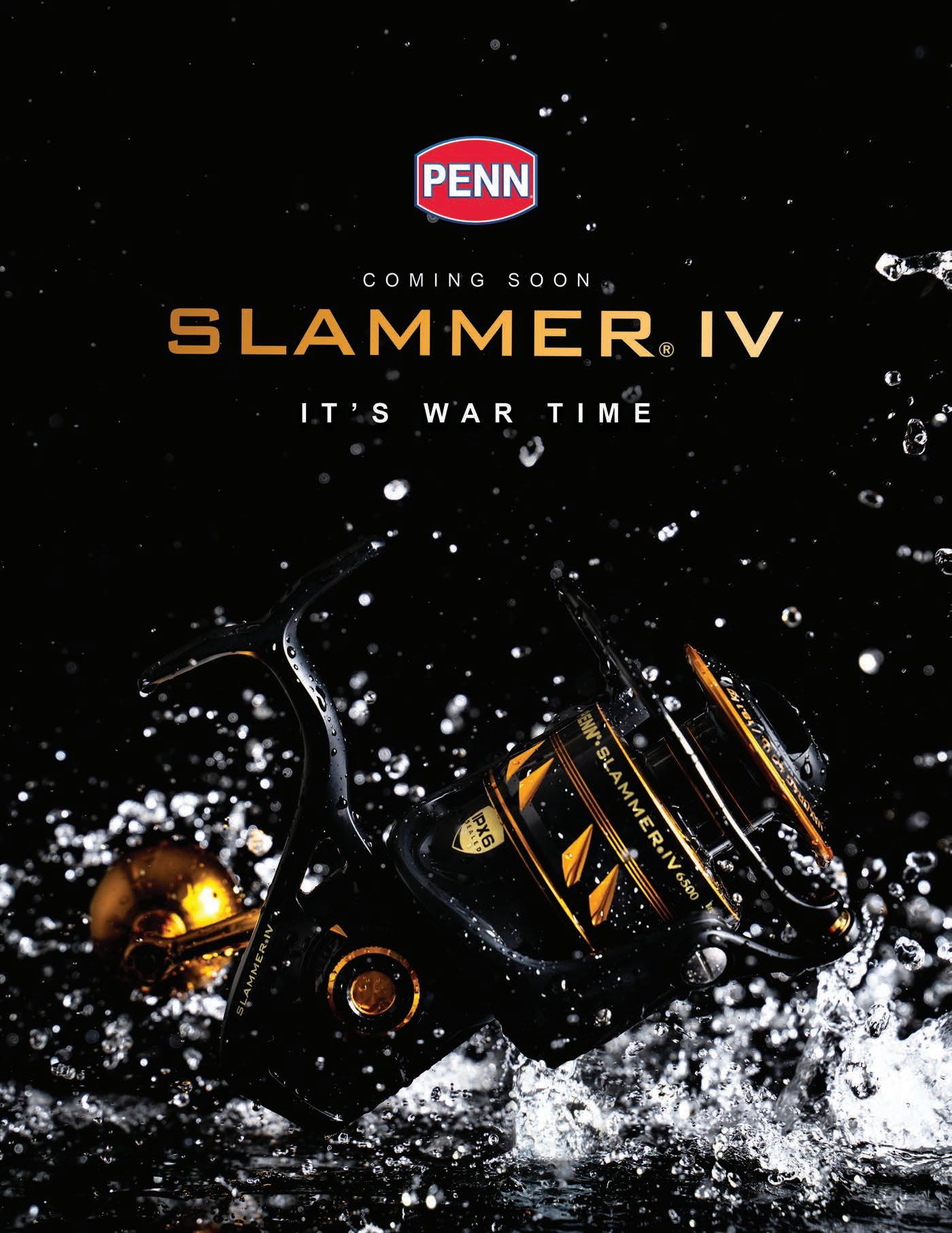 The humble gurnard, a Kaipara classic and a PB for the writer.
The humble gurnard, a Kaipara classic and a PB for the writer.


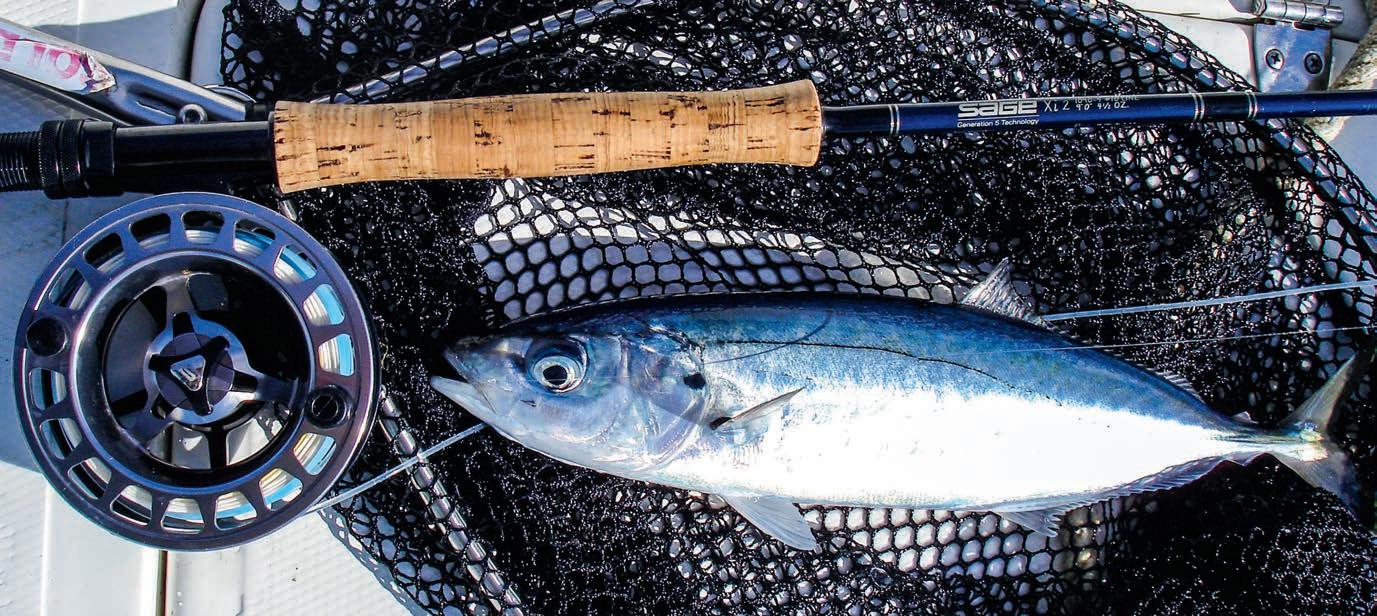
Despite being regarded as little more than a baitfish by many, the streamlined and fatbodied koheru is an exciting little sportfish that does get up to a size where it can put a real bend in a rod. Unexpectedly though, it also sits right up there with some of our hardest species to catch, writes Craig Worthington.
There are literally tonnes of koheru out there along our northern coasts. They are found in abundance along ‘blue water’ stretches of coastline, favouring areas of strong current where deep reefs and offshore up-wellings push masses of planktonic animals up towards the surface. But they’re also found inshore, being encountered anywhere outside of harbour green waters.
With so many about you would think that they are caught all the time. But they’re not. These fish
infrequently break the surface and spend most of their time somewhere in mid-water moving fast and feeding on little shrimps and fish larvae. You’ll see them on your sounder as a layer of fish anywhere between five to fifty metres depth and they’ll be spread out horizontally rather than vertically. The loose nature of their school means you may not recognise them for what they are. Very often, sounder read-outs will not give you a true understanding of how many koheru are actually down there beneath the boat.
I learnt this lesson many years
ago. Having become more and more annoyed by huge mutton bird and seagull ‘work-ups’ that seemed to have no visible fish working with them, I eventually put my dive gear on and jumped in to see what was causing all the commotion. I was confronted with a fast moving mass of large koheru directly beneath me – all swimming at around a metre apart from each other and spread out for as far as the eye could see. There were a lot of fish there, but none of them were swimming in formations that were tight enough to show up strongly on
any top side depth sounder.
Consequently, I came to realise that these koheru represented a huge and relatively untapped fishing resource that were not being caught in great numbers by anyone. You see, you can’t just throw a string of sabikis into a koheru school like this. You can, but they will rarely bite. I have had some limited success on the strings of tan/pink rubber-tailed shrimpy looking sabikis, but most of the time I have caught nothing. It would appear that when they are schooling hard and feeding intensely on zooplankton they are extremely difficult to catch.
Even when they do break the surface as tight ‘trevally like’ krill feeding schools near some of our offshore rocks and reefs (like Bird Rock in the Bay of Islands) they still refuse to bite. You can catch them in this situation, but it is essentially a case of “jagging them in the mouth”. They come to the surface as a thick layer of fish that simply move forward gulping up planktonic shrimps. I’m sure they don’t look at the prey they’re feeding on. It’s more a case of
“A fired-up session on big koheru can be a real hoot!”

swim and eat. They aren’t going to move sideways to eat any fly or lure you cast their way, but swing a tiny krill fly into the school or rip a small lure right over the top of them and you will accidentally hook some of them in the mouth.
Luckily there is another way of catching them that doesn’t involve this ‘mouth jagging’ or such infrequent surface schooling activity around hard-to-get-to offshore rocks. Rather, it involves berley and anchoring your boat a bit closer inshore.
Essentially, you need to tie up
in a likely spot in against coastal cliffs and lay out a fine and carefully controlled berley trail. A steady trickle of finely crushed berley will eventually attract koheru near your boat and, once they are feeding, will put them in a frame of mind where they are actually are catchable. The trick it seems is to switch them over from their zooplankton mind-set.
Tiny bits of bait on well concealed hooks will catch koheru in this situation, but small flies or small jigs work even better.
The lightest fish-shaped jigs
Koheru typically have seagulls or muttonbirds feeding above them. They rarely break the surface in these situations and are very difficult to catch by any means. It is better to target them along the inshore cliffs.
you can buy are typically known in the Bay of Islands as ‘koheru jigs’ and are the go-to lure for anyone wanting to catch these exceptional kingfish and marlin livebaits. Basically, if you can catch “blue koheru” (as they often referred to locally), you’re in with a chance of catching bigger fish. A considerable amount of time, effort and skill is therefore frequently directed toward the important business of catching koheru. Those that do it well win contests and weigh-in the biggest fish at the dock at the end of the

day. The value and usefulness of a fresh, healthy koheru as livebait simply can’t be understated.
As a cut bait, they are equally amazing and they can also be turned into some of the best sashimi you will ever try. Boneless fillets of koheru seared quickly in a hot pan are delicious too and are one of my personal favourites.
For these reasons, I like them as a sportfish. They fight hard and are as fast as their streamlined form suggests. Gearing down your tackle to account for their smallish size means you are in for a lot of fun. A big one of a kilo or more can be a real handful, and will fly around the boat in rapid tail beating arcs. When you have several people hooked up at once there is lots of ducking in and around each other and lots of running around the boat – and lots of laughter. A fired up session on big koheru can be a real hoot!
Finding them may be your trickiest obstacle. The big, fast moving, offshore schools are just about impossible so the best place to find smaller groups of koheru that are willing to switch on to berley are around prominent headlands and over shallow reefs with current. Many of the steep sided bays along Cape Brett will produce good koheru schools, and – for reasons I have yet to fully figure out – these are most commonly found in autumn and winter.
As mentioned, they do show up over inshore reefs and some

A koheru hooked on a small ‘koheru jig’ erupts on the surface as it gets pulled to the boat.
A young James Brown hooked up on a hard fighting koheru. This deep bay at the end of Cape Brett has all the characteristics of a koheru hot spot.

The simple answer to this is when it’s a jack mackerel!
Sometimes jack mackerel are also referred to as koheru, and this can lead to some species confusion. There are not many wharves in New Zealand where you can regularly catch true koheru (Decapterus koheru), so if you’re catching ‘koheru’ off a wharf, what you are probably catching are jack mackerel, of which Trachurus novaezelandiae is the most common inshore species.
Koheru don’t have those awful body spikes running up their lateral line like jack macks do, making them easy to distinguish. Koheru are quite smooth and slippery to hold whereas jack mackerel are prickly bastards that will flick their tail from side to side and put spines in your hand. I hate them!
In colour, jack mackerel are generally brown/grey on their backs with gold hues on their flanks and a distinctly yellow tail. Koheru can also have a yellow tail, but in a boat on a hook their body colour is usually a standard ‘sea-blue’ all over. They may have a golden sheen running down their backs, but this is more noticeable when they are swimming in the water or are dead in the chilly bin.
There are other Decapterus ‘scad’ species that you may catch in New Zealand, but they are rare and most people would struggle to tell them apart from koheru.
Koheru have lots of Decapterus cousins all around the world, but the koheru version of Decapterus is endemic to New Zealand and a very special part of our fish fauna. We are lucky to have these chunky hard fighting little speedsters as a native sportfish species.
deepwater harbours like Whangarei Harbour (they used to be catchable off the old Marsden Point Wharf), but the issue with catching them over inshore reefs is that any finely mashed berley mix distributed in this environment will often attract a whole lot of other fish that will get to the hook first. Out in some of the steep sided bays further out to sea you may only have koheru and a few blue maomao in the berley trail, while inshore you will have kahawai, jack mackerel, sweep, spotties and baby snapper as well. The koheru jigs will be nailed by kahawai so I like to fish a small fly in this situation and pull it away from any fish I don’t want.
Up at the Three Kings Islands there are some absolute monster koheru. Some of them are fifty centimetres long and easily two kilograms in weight. They will eat surprisingly large jigs and fight hard. To fish a berley trail at the Three Kings for monster trevally and giant koheru is one of life’s great pleasures.
On the mainland, the biggest fish are generally between thirty and forty centimetres, but you can berley up a whole school that are all of similar size. You won’t get them all, but any day spent getting a few of these little speedsters in the boat is a day well spent.
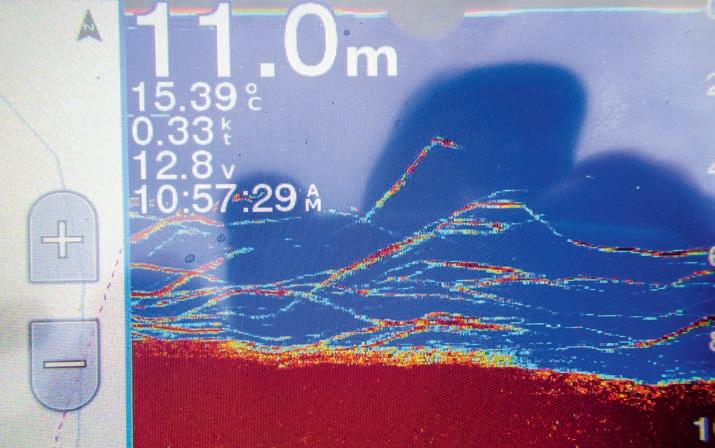

 Jack mackerel are sometimes confused with koheru, which are much bluer in colour.
A bunch of well used ‘koheru jigs’.
Koheru schooling above a shallow reef. The streaks of red on the sounder give some idea of the speed at which koheru typically move.
Jack mackerel are sometimes confused with koheru, which are much bluer in colour.
A bunch of well used ‘koheru jigs’.
Koheru schooling above a shallow reef. The streaks of red on the sounder give some idea of the speed at which koheru typically move.
15” Model

Choose your weapon and take fishing to a whole new level. Whether it’s an APEX, Solix G3 or Helix G4N, you’ll seize the day with more technology and more control than ever before.
Humminbird’s top of the range APEX series provides the clearest sonar imaging available, with industry leading direct 2kW Airmar plug and play. The Solix G3 series is now upgraded with lighting fast dual core processing speed and the Helix G4N series now boasts a giant 15.4” high definition display in its arsenal. All models have everything you need to view their every move underwater, with MEGA Imaging+™, Dual Spectrum CHIRP, AutoChart® Live and One-Boat Network compatibility.

Now you know our secret weapons. Choose yours, and show us what you’ve got.

*Shown with optional CHIRP Radar.





Writer Mark Kitteridge discusses some hook options when using bait to target table fish.
One only has to walk into the various fishing-tackle shops and see the huge array of bait-fishing hooks to be reminded we have plenty of choice!
It’s a sight that can be somewhat overwhelming for relatively new fishers, but it needn’t be, especially if we get rid of all those styles that aren’t circles/recurves!
After all, J-type hooks can be easily swallowed by our quarry (with some positive acknowledgement to those anglers using very big hooks to
make the problem less likely, especially to undersize fish) and they then often catch hold in the guts or gills. This makes survival less likely for any fish subsequently released or which manage to break free. Contrast that with circle hooks, which are super effective and cause much less injury to hooked fish as they nearly always hook in the front of the mouth. That’s why I firmly believe they are the way of the future.
While there are almost as many bait-fishing rigs as there are different hook types, let’s concentrate on the recommended
1) When tying on your circle hooks, ensure the trace material is fed through the front of the hook’s eye to then be looped or snooded on, as the case may be. This makes the most of the hook’s circular design so it’s especially deadly. Many anglers get this wrong when tying up their own rigs (yes, I know the angle looks unlikely to work, but trust me!).
2) Ensure the gap between the hook’s point and the shank is not choked/covered with bait, especially if the bait is relatively tough. The hook’s clever design can only work if the point and barb remain clear of bait (slim strips of bait hooked at one end do a good job, as do squid tentacles or even whole tentacle clumps, depending on the size of the squid).
3) Do not strike in response to bites as this usually causes the hook to bounce out! Instead, a steady lift of the rod sees the hook slide nicely into place around the jaw hinge.

hooks for our three most popular: the ledger/dropper rig; the sliding-sinker rig; and the straylining rig. Let’s start with the ledger rig in this article...
Whenever I think about the dropper rig, I think of the original Black Magic ‘Snapper Snatcher’, even though other companies came up with some pretty good offerings soon after (most notably Gamakatsu). This rig has been around for many years now and it repeatedly reminds me how incredibly effective this setup can be in deeper waters, even in the hands of complete novices. Let’s look at why it has been so successful, as this gives insights into how to make more effective rigs ourselves.
• The dropper-looped baits

hanging off the trace backbone are presented up off the bottom, making them very visible to nearby fish. It’s then up to the re-curved hook – the enduring Black Magic KL – and its adornments to further entice the fish into actually biting.
• The relatively short, stiff droppers mean the hooks/ baits stand out from the rig backbone, making them less likely to twist around the
backbone and also ensuring easy access so fish can get their mouth right around the offerings. Nor can they catch on each other, and the lower one is still tied high enough on the backbone so snagging is less likely.
• The KL 5/0 hook used is a winner. It is the right size for hooking all sizes of snapper, from legal to trophies, and can even handle the odd bigger
surprise that comes along, such as a decent kingfish.
• The hook’s re-curve shape means it doesn’t come into play until fish try to move off with the bait (or the rod is steadily lifted by the angler), with the hook typically sliding up and into place around the jaw hinge. (Even the weight of a decent sinker can help set this type of hook, which is why I recommend overweighting the
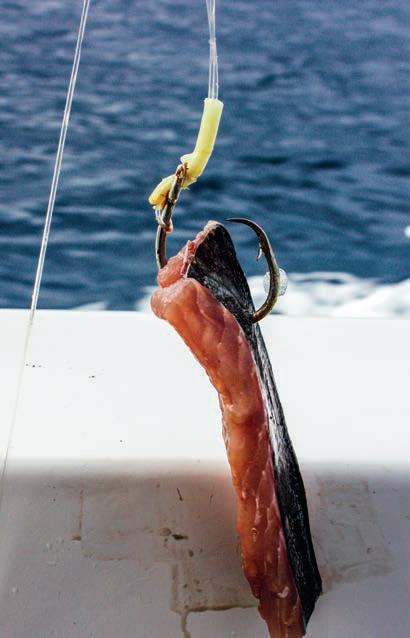

sinker to make this more likely.)
• A wide variety of attractants have been incorporated or added to enhance the rig’s effectiveness. These include:
1) Strands of Krystalflash-type material are tied to the top of the hook’s shank; they sparkle and waft around when moved or some current is present. The product comes in several different vibrant
Although equipped with a relatively big mouth, the gurnard’s lighter body weight means it’s better suited to hooking up on 2/0-4/0 hooks.
colours, with certain conditions, locations, fish species and scenarios potentially making one of these options work significantly better than the others. Better still, it incorporates fluorescent and UV-reflective qualities, which are attractive to fish.
2) A sliding luminous bead is placed on the droppers – a worthwhile addition for those

situations when anglers are fishing deep down or low light is present.
3) Each hook has a ‘fish skin’ wing covering the strands; this adds to the overall look and keeps the fibres tidily contained. Such is the success of this rig it’s led to several others that target some of the more popular table-fish species (i.e. gurnard,

cod, tarakihi and hapuku) incorporating smaller or bigger hooks tied to heavier or lighter trace material as required.
As a general guide, these recurve hook sizes are recommended for the following species, with some consideration given to where they are to be used and the relative size of the species you hope to catch!
• Snapper: 4/0 - 8/0
• Gurnard: 2/0 - 4/0
• Blue cod: 4/0 - 5/0
• Tarakihi: 1/0 - 3/0
• Hapuku/bass/bluenose: 11/0 - 15/0
The last rig, for hapuku/ bass etc, is the only one worth discussing further, as it is obviously significantly bigger!
Typically tied with 200-400lb trace, the large hooks and often aggressive, fearless fish involved mean much bigger baits can be placed on the hooks, but it’s important to do this correctly so hook-ups occur. No one likes to wind back up 300-400 metres with bare hooks after missing their chances!
Some options include: large squid hooked just once or twice about two inches down the mantle; live or dead mackerel nose hooked through the front of the eyes; fresh (if possible), slim strip baits of barracouta, kahawai or skipjack/albacore, hooked once or twice at one end.
Traditionally, 15/0 hooks have been used for hapuku and bass – and even the generally smaller bluenose – but as the average size of these species has fallen dramatically in recent years, 11/0 is becoming the wiser option.
Whatever the size choice though, recurve hooks serve another role while the big fish are wound up from deep down: as the ‘puka and bass embolise and fill with air, causing them to rise increasingly rapidly as they near the surface, the circle hooks help to keep them on the line, unlike J hooks, which can lose their grip.
Next month: The right hooks for sliding-sinker rigs and stray-lined baits.
 Hook long, slim baits just once or twice at one end to avoid choking the circle-hook gape. These are about to be dropped down for hapuku or bass.
Hook long, slim baits just once or twice at one end to avoid choking the circle-hook gape. These are about to be dropped down for hapuku or bass.
It doesn’t matter where you are heading or why, there is a
Buccaneer for you…
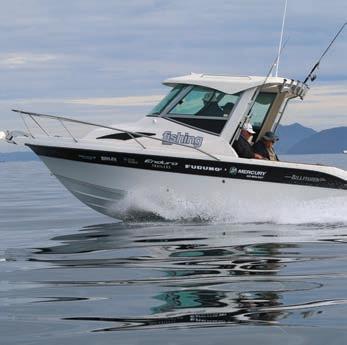
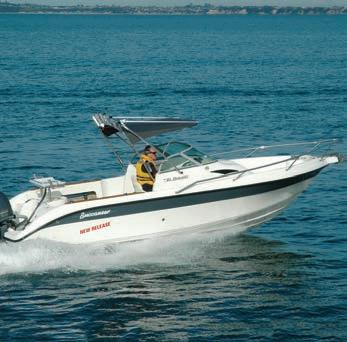


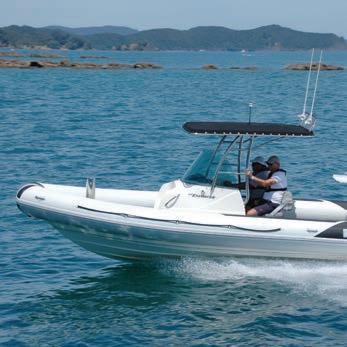


Buccaneer create superbly designed, exceptionally well-built and finished boats in 21 designs across six different ranges, there is a model to suit everyone.
VISIT US FOR MORE INFORMATION AND TO FIND A DEALER NEAR YOU www.buccaneer.co.nz
Crown copyright © LINZ

 Tony Orton recently took a well-deserved breather from his saltwater fishing in Mangawhai and headed to the Rotorua lakes for three days of chasing trout. He shares the story of the trip…
Tony Orton recently took a well-deserved breather from his saltwater fishing in Mangawhai and headed to the Rotorua lakes for three days of chasing trout. He shares the story of the trip…

They say a change is as good as a holiday. A few months back, I felt myself walking around with what felt like a big dark cloud over my head. With a couple of big projects going on that were sucking up all my time and energy and a long run of bad weather stopping me doing charters and filming, a little bit of the winter blues started to set in.
I then got a phone call at what seemed like the perfect time from Mike Davis (one of the owners of the Rotorua Hunting & Fishing New Zealand store), who too was maxed out at work and in a similar space to me, so we both needed a break and a recharge. Mike said the fishing was good on the Rotorua lakes and there was a good
weather window in the next few days. When he then said to come down for a few days of trout fishing, my immediate thought was, “Screw it, everything that’s going on right now can wait – I am going fishing.”
Now, I can safely say I am no trout specialist, so I was a little nervous to be fishing for trout in a way I have not done before alongside a bunch of guys that do this style of fishing day in day out. To make it worse, there was also the possibility of meeting and fishing beside local legend Pat Swift.
After talking to Mike about how they jig for trout and the tackle they use, we decided to use our saltwater Engetsu rods. With the super sensitive nibble tips these rods have, it seemed they would
do the job, and this also meant we could utilise the rods we already owned.
For a reel, I decided to use my Shimano Curado DC. It is a bait caster style reel that, when spooled with Kairiki 10lb multi colour braid, we thought would be a great fit for our planned style of fishing. If this gear worked well, my Engetsu gear would suddenly become a multipurpose saltwater and freshwater setup. Mike had all the rigs/flies and weights, so I decided to stock up on these at his store once I got to Rotorua.
It did not take long to pack all the gear into the 4.5m Extreme, hook it up to the back of the Ford Ranger and set tracks for Rotorua.
With all the excitement of fishing in a new way and planning what

tackle to use, I was already feeling a bit better. After another check of the forecast on the way down, which was still showing variable winds on the lake for the next three days, my excitement levels rose even further.
Arriving in Rotorua, I met up with Mike at the store. He rung around a few of the local guides so we could get an idea of where the fish were biting. We then went over the gear and stocked up on a good selection of Pat Swift’s jigging flies. These jigging flies are a work of art and as with all tackle, they come in a range of colour patterns and sizes. The rig is made up of a three-metre fluorocarbon leader with one of Pat’s flies tied to droppers at one metre intervals.
After talking with Mike about how to rig these up, he recommended having a light seven metre fluorocarbon leader tied to the braid, which connects to the swivel at the top of the jigging fly rig, making the total length exactly 10m (a very important part of the system as I would learn later). At the bottom end of the rig, we clipped a 2oz to 3oz sinker (the type with a swivel attached to the top of the sinker).
We now had the rods and reels ready and a tackle box full of jigging fly rigs ready to go, but it was not quite time to hit the water. I just needed to get my trout fishing
 Peaceful sunrises were just what the writer needed after a busy month. Photo: Mike Davis. Right: The flies the writer used and the Shimano Curado Baitcaster reel were all well-suited for catching trout.
Peaceful sunrises were just what the writer needed after a busy month. Photo: Mike Davis. Right: The flies the writer used and the Shimano Curado Baitcaster reel were all well-suited for catching trout.


The trout were in such great condition – it would have been a sin not to take a few home to smoke. Right: The sounder showing trout, the sinker below the fish and if you look closely, you can even see the three flies.
license for the next three days (the friendly staff at the store helped me with this), and then we were off!
The launching and run out to the area we would be fishing was stressless. There were no tides or swells to worry about and as it was midweek, I think we were the only boat at the ramp. I was liking this more and more and feeling even more chilled out. After arriving at our first spot, the reality of fishing a new way set in and I felt like a student arriving at a new school.
At our first spot, we cruised around the general area scanning the sounder looking for structure, bait and fish (just as I do when hunting kingfish). Once we found schools of smelt on the sounder, we deployed the Minn Kota to
hold us on the spot. It was already becoming apparent that the Garmin sounder was going to play a big part in our success over the next few days.
Instantly, we started marking trout at different heights in the water column. It was now time to drop our rigs to the depths below. I then realised why we had our total leader length at exactly 10 metres long. If the trout were holding at 30 metres, it was easy to drop to that depth – just let out the leader plus two colours of multi-colour braid (this changes colour every 10 metres).
The nice light Engetsu-style rods and reels were great to fish with. The baitcaster style reel allowed me to have all the controls in the
These fully-guided international fishing adventures cater for either groups or individuals. All trips are fished on top boats with world-class crews in some of the world’s best locations at an affordable price. We
palm of my hand, making it easy to adjust the height of my rig, and the sensitive nibble tip on the rods made it easy to subtly work the lure and detect bites.
The next three days pretty much consisted of this: two guys standing on a small boat on a flat calm lake, both staring at the sounder looking for trout, discussing what depth they were at and adjusting the depth of their jigging flies.
The Minn Kota also proved to be a great asset when targeting these trout as it enabled us to hold on the fish, bait or drop offs. If we were not marking fish, it would then allow us to quietly move around looking for better areas. Another
have been guiding internationally for over 16 years and have personally fished all these destinations, ensuring a memorable adventure for our guests.
For more information on these trips or local
advantage is that it gives you the option to control your speed. We would slowly move between spots and leave our rigs in the water, so we were fishing while we prospected.
Mike sure did teach me a lot about the techniques in those three days – a lot of finesse was required to hook up. Sometimes the fish would bite when the lures were sitting stationary, and at other times we would get more bites when the sinker was hard on the bottom. A little movement even worked better at points and a lot of fish bit when the lure/fly was moved up or dropped down slightly away from them. It sure was great to watch how Mike fished and this shortened my learning curve
charters to the Mokohinau Islands please contact Bea on 022 306 5743 or Tony on 021 208 0797 or email us at: info@offshoreadventures.net
• For latest videos, tips/tricks, giveaways and to subscribe, visit www.journeyofafisherman.com
• Follow us on Facebook: https://www.facebook.com/journeyofafisherman/


dramatically. We even got to spend some time sitting beside Pat Swift’s boat and watch first-hand how a true expert in this style of fishing goes about his trade.
Over the next three days, we boated and released a huge amount of fat rainbow trout. I was amazed as to the condition these plump fish were in. The trout in the Rotorua lakes are certainly well fed and with the massive amount of feed and bait these lakes have, you can understand how this style of fishing is so productive. I even managed to put a bunch of fish on ice to take back to Mangawhai to smoke up for the family, which was a true reward for a great few days on the water.
All in all, this trip was perfect in so many ways. I got to learn a new way of fishing, I got to fish in a new area in one of the most stunning parts of New Zealand, and I got to hang out with a good mate. But most importantly, I got a chance to clear my head, do something different and take some time out for me. It is important to sometimes self-check, be a little selfish and look after your brain. Thanks Mike for the phone call and inviting me into your part of New Zealand for three super chilled out days! And if you want to check out the videos of this trip, you can find them on my Journey of a Fisherman YouTube channel.
Adios, Tony

One of German tackle manufacturer Balzer’s premium offerings, the Adrenalin Inline Medium 400, would make a great gift for a fishing-mad dad. The rod is constructed from 40 ton carbon fibre which is then wrapped in carbon tape, resulting in an incredibly strong blank. It is rated to cast 120-400g weighted lures, making this rod a great allrounder for most New Zealand fish species. The force is distributed evenly throughout the internal length of the rod (no eyes) minimising unnecessary line tangles and putting less strain on the angler.
All rods come with a thread lining aid and a padded bag. RRP $342
Check them and more Balzer options out at www.balzer.nz

Keep your father warm and toasty with the latest Just Another Fisherman Anglers Underlays. Built from super soft merino, Anglers Underlays are the perfect companion piece. These base layers are designed to keep you warm and cool, and because merino breathes, you will have excellent anti-odour and moisturewicking benefits when wearing. Check them out in-store or on online at www. justanotherfisherman.co.nz
The Stoney Creek’s Chilly Bag is perfect for keeping your food and drink fresh for up to 100 hours, so you will be ready for a day out with your dad. These chilly bags are light to carry and easy to store, and they’re also made with Defender 840D TPU construction which is super durable and ideal for the rough and tumble boat life! RRP $379.99


Stoney Creek’s Deck Boots are crafted with foot protection, comfort and safety features which make them purpose built to maximise your experience. They also feature non-marking and razor-siped gum soles for traction on wet surfaces. Your dad can wear these booties on the boat, around the marina and for BBQs too! Grab your dad a pair and treat him to a day of fishing this Father’s Day! RRP $129.99


With summer just around the corner, never run out of power with REDARC’s portable folding solar panels. They’re the ultralightweight solution to portable power, quick to set and easy to pack down, and available in 120w and 200w options. They’re up to 50% lighter than other popular models so you can easily move them around to make the most of patchy sunlight. For more information, visit redarc.co.nz/solar
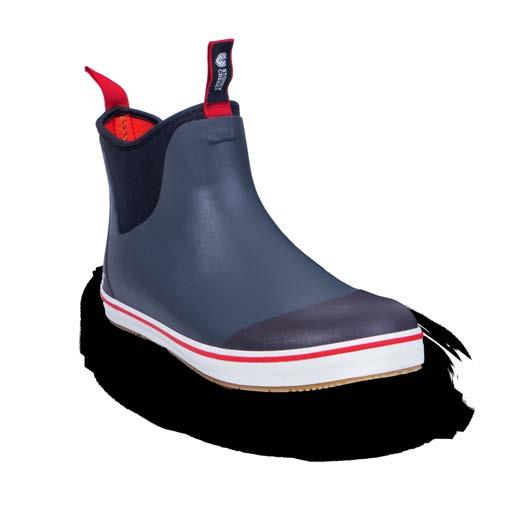
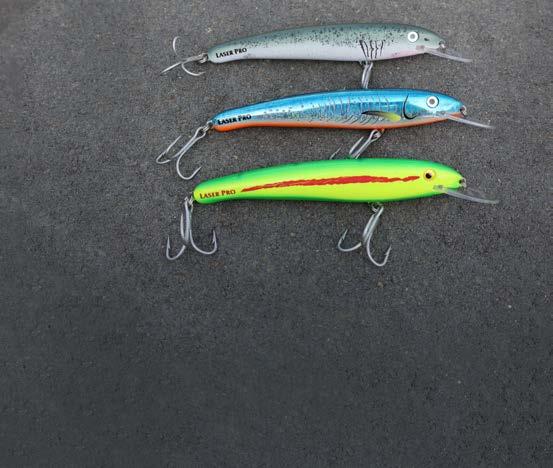
Halco makes a range of lures to suit a variety of New Zealand fishing conditions and species, and they recently added three new colours to one of their most popular ranges – the Laser Pro. In particular, the Laser Pro 190 Deep Diver runs deep and fast, and is a favourite among Kiwi anglers. The Halco range would be a great addition to any dad’s tackle box. They are available from tackle stores nationwide.
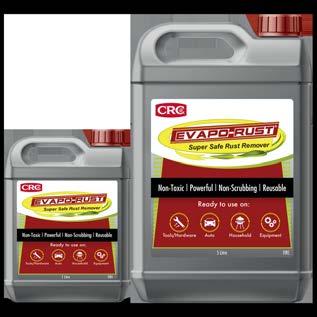
CRC Evapo-Rust® is a non-toxic rust remover for fast and effective restoration. The formula is specifically designed to remove rust, with no scrubbing or sanding required. It is safe, simple, and easy to use. There’s also no need for mixing – the solution is ready to use.
Available in hardware, engineering, chandlery and automotive stores nationwide.
The Innovation Vac&Seal packer features a double seal, built in roll storage and fold up cutter for your convenience. It keeps your food, fillets and even bait fresh and safe in the fridge or freezer with no risk of freezer burn, drying out, or contamination. This is the perfect companion to your Bradley Smoker, and is ideal for preserving and protecting your food and belongings when boating, camping or hiking.
Check them out at www.gourmet-innovation.co.nz

Daiwa Bait Junkie soft lures are constructed from a proprietary material Elastomax, an incredibly durable and stretchy non-toxic elastomer which allows for thinner body designs with improved swimming actions. Amino-X is impregnated into the elastomer during the manufacturing process and acts as a bite trigger. Available in tackle stores in a range of proven colours and sizes. RRP $12.99.
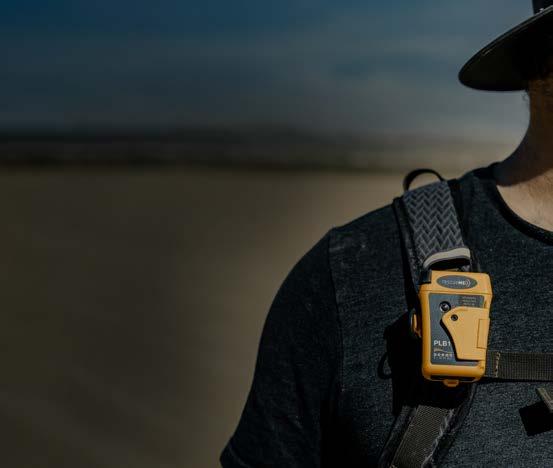
Wherever your dad ventures – at sea or on land – the rescueME PLB1 provides the reassurance that global emergency services can be alerted by the press of a button. When activated, the rescueME PLB1 transmits the user’s position and ID so that rescue services near them are promptly notified. There are no charges to use this service. Available from leading sports and recreation outlets across New Zealand.
Find out more at www.lusty-blundell.co.nz


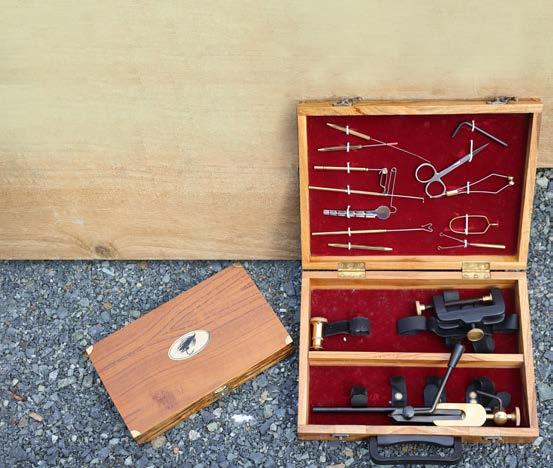
The Deluxe Fly-Tying Kit is an ideal gift for that freshwater angler in your life. This nicely finished flytying kit comes in a smart wooden carry case with all of the tools you need to get started. The Deluxe Fly-Tying kits are available from selected tackle stores nationwide.

Dad will love quality craft beer for Fathers Day. Not sure which one he might like? Why not buy him a mixed pack?
Enter FISH21 for 10% off your online order.
www.colabbrewing.co.nz
Three Wise Birds are big on premium ingredients, real flavours and good times. They believe in making cider from only the best Hawke’s Bay apples, which results in a clean, crisp, and refreshingly dry product – characteristics they believe fit the Kiwi lifestyle, whether they’re enjoyed in the backyard, at the beach or on the boat.
Available in all good New Worlds and Pak’nSaves or check them out online at www.threewisebirds.co.nz.



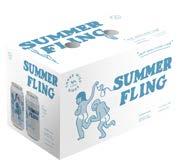
The secret to getting a perfect knife-edge is to maintain a constant angle between the blade and the sharpener. Warthog Sharpeners patented system ensures that your knives get the same fine edge every time. It also has adjustable angles –20, 25 and 30 degrees.
RRP $154.99

For more information go to www.knifesharpners.nz or check them out at Hunting & Fishing NZ stores nationwide.

The all-new marine engine flush by SALT-ATTACK is NZ made from the best ingredients, including the latest surfactants which quickly eliminate surface tension. SALT-ATTACK’s superconcentrated and environmentally friendly biodegradable formula has been designed to be mixed in the SALT-ATTACK mixer or made up at a rate of one part product to 500 parts freshwater.

For more information, head to www.salt-attack.com or freephone 0800 272 589


Hauraki Gulf Fishing Hot Spots by Bruce Duncan
New Zealand fishing legend Bruce Duncan lets you in on all his secrets in his new book Hauraki Gulf Fishing Hot Spots – the perfect Father’s Day gift for that Auckland angler in your life. Over 150 spots are profiled, with Bruce outlining the best methods, tides and times to fish each area.
Available online at www.nzfishingnews.co.nz RRP $39.99





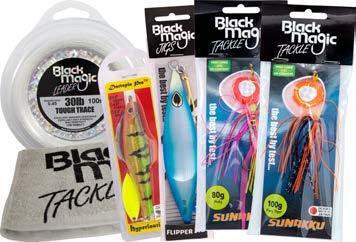
German-born local distributor Daniel Eisenhut says Balzer Inline rods are proving popular.

German brand Balzer GmbH is available for the first time in New Zealand, and German-born local distributor Daniel Eisenhut says their innovative Inline rods are proving popular.
“I love Balzer gear. The feeling of adventure and freedom, being outdoors, exploring nature and catching a good fish – that’s what it is all about, and I am excited to bring the Balzer brand to the New Zealand market.”
Developed by Hanns Balzer in 1949, Balzer GmbH was a product of post-war Germany after the US army said they were enjoying the diverse German rivers and lakes but noted there was no fishing tackle available.
With reels incorporating duraluminium and carbon brake discs, and rods made of high end carbon fibre, titanium, and ergonomic cork, Balzer’s products are not only fun to use but also long lasting.
“I used Balzer fishing gear growing up and have very fond memories of walking along the local river fishing for trout or carp,” says Eisenhut. “I used the same Balzer rod and reels for years and years. I really loved them.”
This year Balzer NZ has attended the Twizel Salmon and Wine
Festival and the Hutchwilco NZ Boat Show in Auckland. Balzer NZ has received overwhelmingly positive feedback at these events as well as from customers from Balzer NZ’s own online store –particularly with regard to their inline ranges.
“While inline rods might not be completely unfamiliar to some anglers, Balzer’s Adrenalin Inliner series is as good as it gets, with only the best and strongest materials used,” says Eisenhut.
The Adrenalin Inline rods are Balzer’s most elite product and are the best German engineered fishing rods available on the market. Constructed from 40ton carbon fibre and wrapped in carbon tape, this range is ultrarobust and about 20% stronger than comparable rods.
The 71° North Inliners are super light and compact. Also made from 40ton high-modulus carbon fibre, this range is now distinctively lighter and slimmer than its predecessors. The 71° North range are available in both two and three section travel versions, as well as in different rating classes for a variety of fish species, meaning there is something for everyone.

All rods come with a thread lining aid and either a padded bag or neoprene sleeve.



Navico, parent company to the Lowrance®, Simrad Yachting, B&G® and C-MAP® brands, announced the appointment of two sales people already well known in the industry – Adrian Hogg and Ben Maule – to join the team in New Zealand.
Adrian will join Navico as the Key Account and Retail Manager (New Zealand) responsible for all large and local retail customers.
Adrian has over 20 years of experience in the New Zealand marine industry. For the last nine years, he’s worked for Mares Asia Pacific Ltd as their Subsidiary Manager. Prior to that, he worked at Douglas Johnson and Co Ltd (Shimano NZ) for nine years in the sales team and as their Sales and Marketing Manager. Adrian was awarded honorary life membership of Coastguard North Shore for his volunteer services spanning 15 years.
The Balzer 71° North Inliner rods are a great compact option for travelling anglers.
Ben will join Navico as the Territory Manager – Boat Builders & Technical Dealers, responsible for all boat builders and custom dealers in New Zealand. Ben has previously worked for Navico from 2013 to 2017 as National Sales Manager before leaving to travel abroad. Ben travelled extensively through Europe while based in Germany and finished his travels in Brazil conducting volunteer work.
Both will be based out of Navico’s Auckland office.
Adrian HoggBen Maule

“The marlin was Natalie’s first oil effort… and now she just can’t stop painting.”

NZ Fishing News contributor Ben Francis was recently contacted by Artist Natalie Gelder’s partner Cam Owers, who requested a good gurnard image that would illustrate the unique colours and unusual features gurnard are well known for. Ben obliged with an image of a west coast “carrot” and a few months later he was blown away by the lifelike artwork that Natalie had produced. After a positive response on social media channels, it seems others were equally impressed. Ben decided to get Natalie’s story and understand where her interest in marine subjects stemmed from.
Natalie started moving her drawing hobby towards being a career about two years ago after having her first child Carter, who became a regular subject of her drawings.
Natalie described these pieces as therapeutic, and not long after, other people started to ask if she could draw their children, pets, and so on. It soon became apparent that contributing to the household income without having to sacrifice any time with Carter was a possibility, or at the very least, Natalie could cover her costs of buying equipment as she set up as a professional artist. She also realised there was an opportunity to have a shot
at making what she loved her full-time occupation (something I’m sure many readers aspire to with fishing!). Moreover, Natalie wanted to show her children that sticking at something and running a marathon to do what you love will pay off in the end.
Natalie’s partner Cam initially had ideas to create a fishing t-shirt brand using her hand drawn designs, which we are told is still on the to-do list. But the marlin (see image) was Natalie’s first oil painting which was finished during lockdown, and now she just can’t stop painting.
Portraits have always been a favourite, usually with people as the subject, but Natalie thought it would be a missed opportunity
to not do portraits of the beautiful wildlife/sea life in New Zealand.
Natalie recalls that during kayak fishing trips with Cam to the Coromandel and Russell, she was dazzled by the beautiful iridescent colours of the fish, and now she wants to eventually paint them all. However, it was the stunning colours on a gurnard that made it top of Natalie’s list after finishing the marlin.
Natalie says that oil painting is a long process, with around 50 to 180 hours spent on each piece, and taking around six months to dry properly. So in between looking after her boys, and sometimes only getting an hour at a time, producing these pieces has started at a steady pace.
Natalie has recently been taking on commissions and has also been entering into competitions, while building up her marine prints collection. The gurnard and marlin originals were recently exhibited and up for sale at the annual Riversdale art exhibition.
If you are interested in commissioning Natalie to produce one of her pieces for you, or if you’d like to acquire one of the marlin or gurnard prints for your home, please contact Natalie via email at nataliegelderart@ outlook.co.nz or visit her online store: https://chooice.co.nz/ store/natalie-gelder-art/.
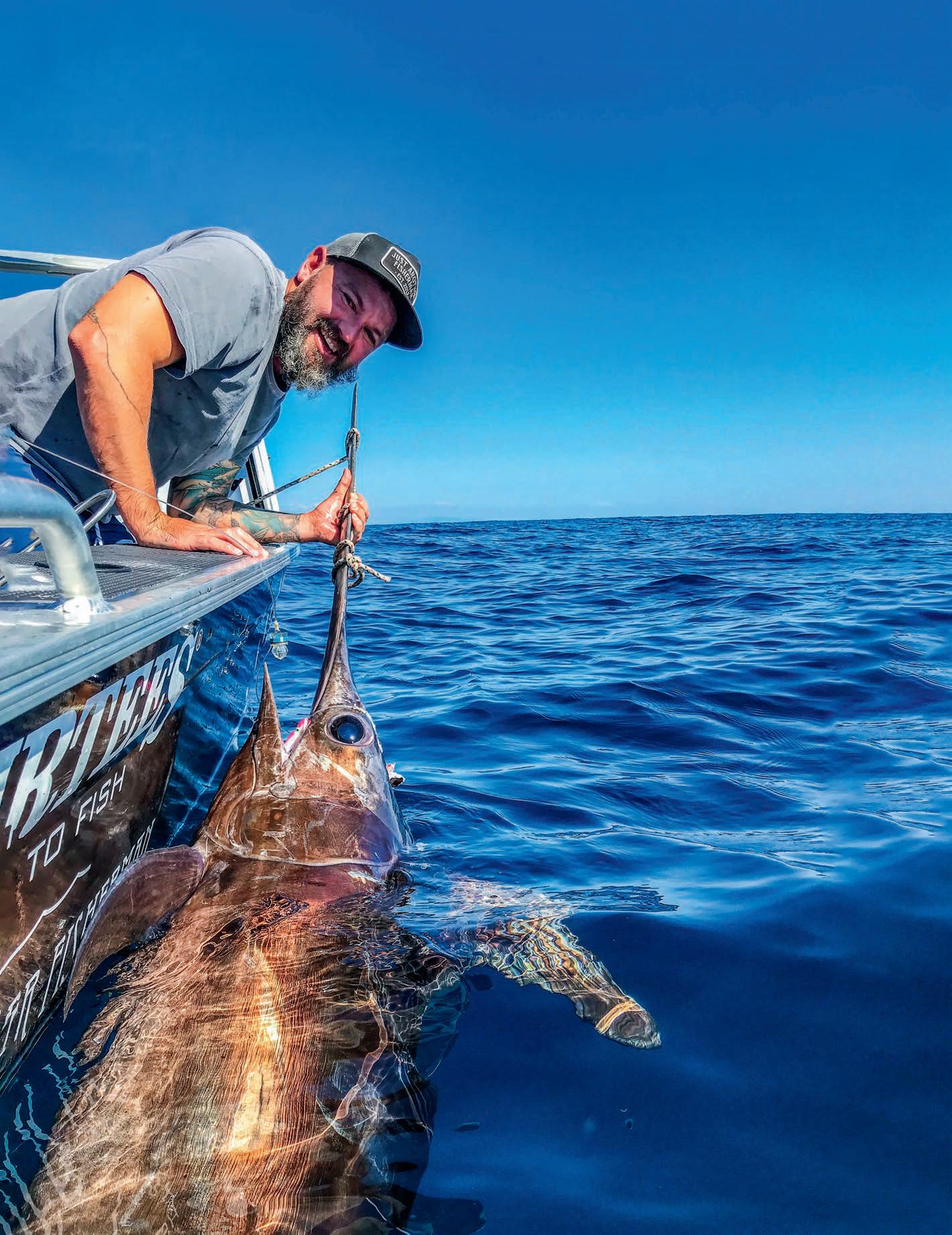


Aaron Styles isn’t your average fashion designer – sure he has a fitting last name for the game, but there aren’t many fashionistas who have an equally serious interest in fishing suggests contributor Nick Jones. With such an eclectic mix of work and play merged into a successful clothing label, Nick sniffed out a good story, not to mention a chance for a day on the water…


Shallow-water catch-and-release soft-baiting is one of Aaron’s favourite fishing styles.
Aaron
Just Another Fisherman is a menswear brand which is based around a lifestyle of fishing and outdoor adventures. With around 30 stockists in NZ and Australia, a busy online shop, and two physical stores in Auckland, it seems Aaron has taken advantage of what some might consider a relatively niche gap in the market. I’d enjoyed fishing with Aaron on a variety of trips and rate his clothing – especially the ‘crewman shorts’ which are an incredibly practical product that feature four-way stretch, plier holders and magnetised pockets (very handy for when you’ve had a few too many at Swashbucklers!). However, I was keen to learn more about the guy, and a winter’s morning trip to his local waters around Kawau Island would provide the perfect setting to talk shop.
We arrived at a very chilly Martins Bay before sunrise and loaded up his Surtees 495. The boat’s called Critter Collector, and that was exactly what Aaron had in mind for us. Being a good cook, Aaron regularly treats his staff to fresh kaimoana, and on his shopping list for this trip was calamari and snapper. Aaron is an organised fisherman – the Critter Collector was thoughtfully set-up, his tackle was neatly arranged, and he had a very clear game plan for the morning. With a sunrise high-tide, we arrived at Aaron’s squid spot in the dark and he deployed the MinnKota in spot-lock over a large weed bed in about 4m of water. I barely had the chance to ask Aaron any questions before he found himself attached to the target species – a solid cephalod that even managed
to pull some string. We enjoyed an entertaining hour of squid action that left the poor Critter Collector covered in ink and culminated in Aaron landing an XL specimen on the final cast.
The next target was snapper, and we headed to a different part of the coast where the MinnKota was once again utilised – this time slowly moving us past a wealth of shallow nooks and crannies where we were sure a few winter reds would be mooching about. The first hour of fishing was good but not spectacular, which allowed us to have a good chat about his background, his philosophy, and Just Another Fisherman.
Aaron grew up in the Bay of Plenty and studied graphic design before moving into the menswear industry. After a stint with Huffer, he teamed up with his lovely wife Penny and co-founded Mr and Mrs Styles – a boutique design, production and merchandising company that produces apparel for some of NZ’s top fashion labels. During this period of his life, Aaron and his fishing mates were super keen on kayak fishing, which led them on many adventures around the Hauraki Gulf and the Coromandel. Aaron says he began Just Another Fisherman because they struggled to find functional fishing clothes they could relate to. It started off as a sidehobby making a few hats and t-shirts for mates, with clear instruction from wife Penny to do it in his own time!
Nevertheless, he continued working hard to bridge the gap between comfortable outdoors attire and classic streetwear to create what is now a well-recognised label. Having designed

by a huge Three Kings bass.
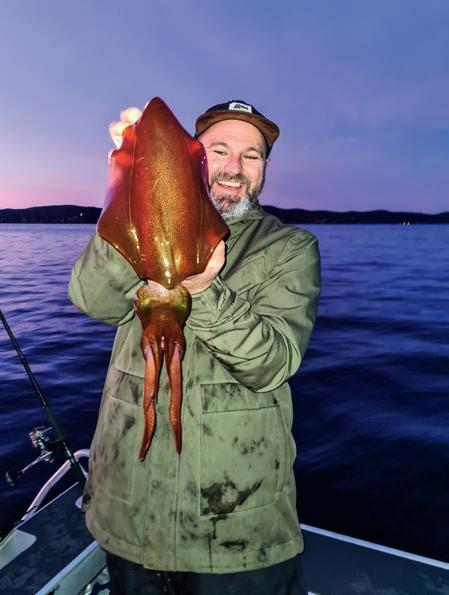
The writer was well and truly out-fished by Aaron on their trip to Kawau, as this large squid proves!
Aaron is passionate about on-the-water catering. dwarfedclothing for many years, Aaron says he’s able to do much of the work for Just Another Fisherman before getting it manufactured in China. Lines are released seasonally to match the different fishing options in NZ, and he gets local artists to design content. He utilises a team of ambassadors, all good mates with Aaron, who are given free products in exchange for write-ups, photos and videos that are used to promote the company through various channels.
Our chat was interrupted as we approached a very shallow bouldery bay. Casting into less than a metre of water, we enjoyed strike after strike of 40-60cm fish and even watched one snapper breach the surface as it chased down my soft-bait! It’s obvious when you fish with Aaron that he is all about the experience and the adventure rather than the catch.
This insight is substantiated
when you go to the front page of the Just Another Fisherman website and see the classic quote from Zane Grey – “If I fished only to capture fish, my fishing trips would have ended long ago.” He also seems to derive equal enjoyment whether it is him or his crew that catches the fish of a trip – a great trait in my book!
Aaron enjoys all styles of fishing and has caught an impressive list of species from his little boat – including broadbill and striped marlin. He uses Just Another Fisherman as the vehicle to bring like-minded people together and go on some epic ‘business’ trips. For the last few years, he has organised seasonal photo or video campaigns where a bunch of his angling mates get together at a cool destination such as the Far North or Aitutaki, don some new season clothes, and go fishing for a few days. Recently, he also organised an ‘Angler’s Escape’ at Rangiputa for
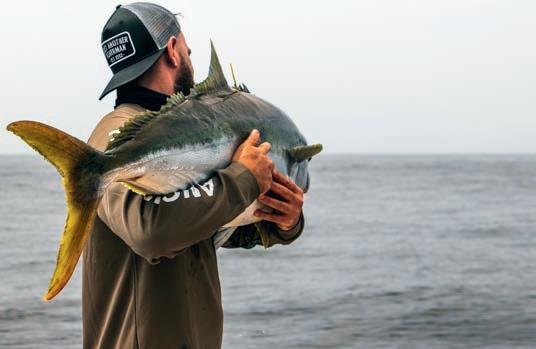
On Just Another Fisherman’s last trip on Pursuit before Rick Pollock retired, the boys found themselves amid a hot kingfish bite in glassy conditions at the Ranfurly Banks.


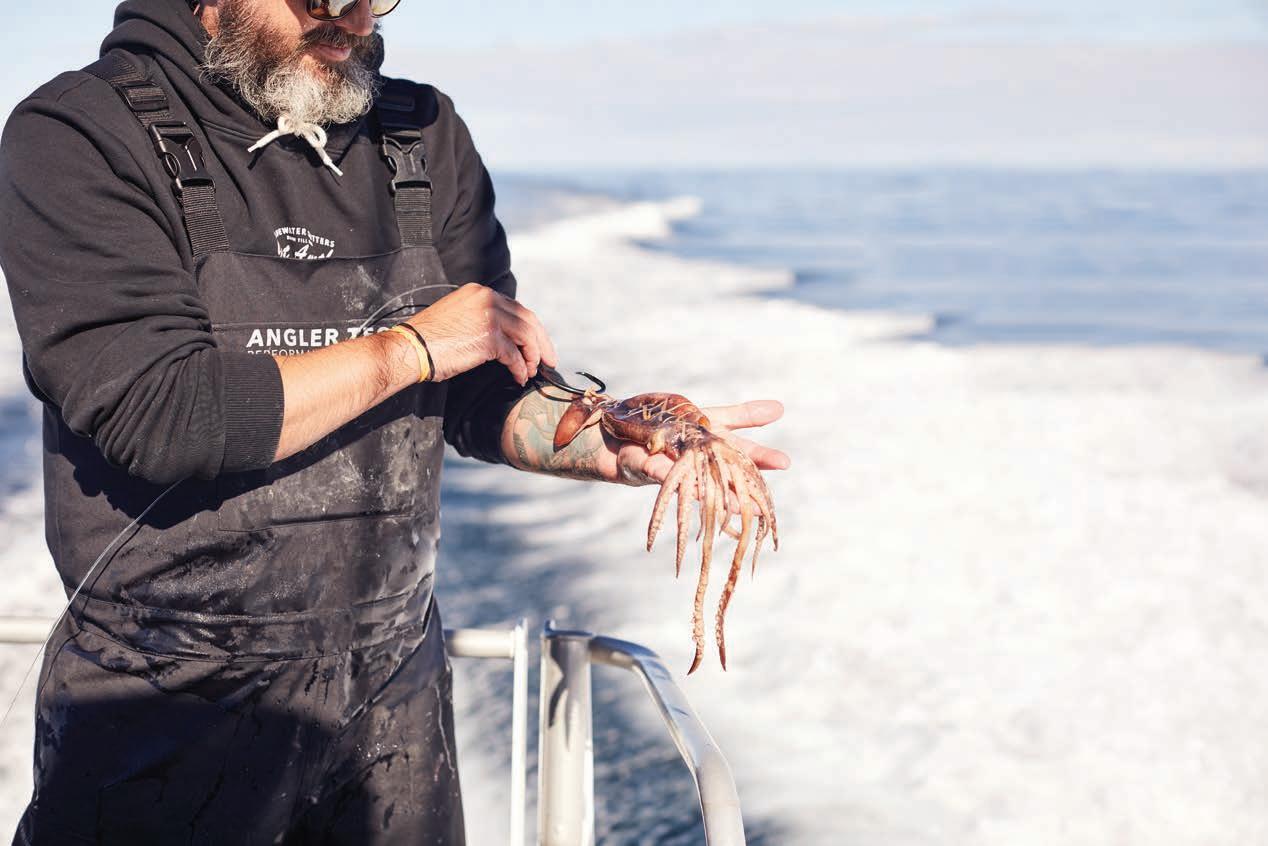
a bigger group of keen anglers from around the country – the lads raised money for charity, took part in a casual fishing competition, and by all accounts had a bloody good time.
So, what does the future hold for Aaron and Just Another
Fisherman? He says he wants to keep designing functional products, continue building great fishing relationships, and never forget the lifestyle and adventure roots of the business. Go well, Aaron!

“..the lads raised money for charity, took part in a casual fishing competition, and by all accounts had a bloody good time.”

Just
 Another Fisherman is Aaron’s platform to get likeminded fishos together.
Another Fisherman is Aaron’s platform to get likeminded fishos together.



I’ve been asked a few times for my dry aging method for fish. I grew up hearing from everybody that “fresh is best” and “you can’t beat fresh fish”, but as I got older and began to understand the science behind dry aged fish, I am 100% converted and I believe fresh is not best.
Don’t get me wrong, leaving a fillet in the fridge for a week and then frying it up is not going to be better than cooking it the night of catching it, but if you can get a few
small things right during the aging process, you are in for a treat.
My technique is in no way the “proper way”, but through study and lots of trial and error, I have found a foolproof way to do it.
First, you need to understand how this works. Dry aging fish is in essence removing the moisture to create a more tender and flavourful taste. This is what’s known in Japan as umami. To give it a go, you are going to need paper towels. Lots of paper towels.
1) Place your fillet/s on some towels and pat dry as much surface moisture as possible.
2) Lay down a few sheets of new paper towels, place the fish on them and fold the towels over so the fillet is encased.
3) Cover on a plate with a plastic kitchen wrap or put into a snap lock bag and squeeze out the air. Refrigerate.
4) Repeat steps 1-3 the following day.
5) After changing the wrap once, repeat after four days and it should be good for a further three days.
6) I like to eat the fish at somewhere between 7-10 days into the process. If you want to go longer you can. Just keep checking the paper and if it becomes soaked, change it.
This is a great way to keep fish for longer without having to freeze it. When you freeze fish, you may notice it becomes a bit soft once it defrosts. This is because the flesh is made up of roughly 60% water and when water freezes, it expands and tears the flesh.
– Joel Hodgson, Natures KaiCheck out more from Joel and Nature’s Kai on Facebook and Instagram – @Natureskai

Dry aging your fish will require plenty of paper towels and a bit of effort, but it is a great way to keep the catch for up to 10 days or more without freezing it.

paper towels. It kept for many days in pristine condition. When trying the method on four good-sized snapper fillets, the results were the same. We were still eating the fish a week later and the taste was superb. Give it a shot! – GD


Like many of us, our From Sea to Sizzle columnist Bea Bagnall developed a taste for cooking kaimoana via opportunity and necessity.
She and partner Tony Orton have travelled the world together, crewing on several vessels where Tony ran the bridge and Bea the galley.
Bea developed a great range of recipes as they globe-trotted about. Although an accomplished
angler in her own right, Bea likes nothing more than experimenting with the catch in the galley, specialising in simple recipes with commonly-available ingredients.
With her and Tony’s home base now firmly established in Mangawhai, where they run a charter operation and a lodge, fresh ingredients from both the land and sea are never far away.
Bea’s recipes reflect this…

• 4 snapper fillets
• 1Tbsp self-raising flour
• Salt and pepper
• 30g butter
• 3 cloves garlic, finely chopped
• 1 ½ tsp whole grain mustard
• ½ lemon, squeezed
• 1 ¼ cups chicken stock
• ¾ cup cream
• ½ tsp fresh thyme, chopped
• ½ tsp flat leaf parsley, chopped plus extra for garnish
• ¾ cup grated parmesan cheese
• 1 packet of fettuccine pasta
1) Bring a large pot of water to the boil for the pasta.
2) Pat dry the fish fillets, season with salt and pepper, then lightly dust with self-raising flour.
3) Add your fettuccine to the boiling water and cook for 10 minutes or until al dente. Drain and set aside.
4) In a large saucepan, melt the butter over medium heat. Add the garlic while stirring for 10 seconds, then add the remaining ingredients except for the parmesan cheese.
5) Bring the sauce to a simmer, then add the parmesan cheese and let it simmer for 2-3 minutes until the sauce starts to
thicken. Add salt and pepper to taste and adjust with lemon juice to your liking.
6) Add ¼ - ½ of your fettuccine to the creamy lemon sauce and toss to coat.
7) Heat 1Tbsp of butter in a large saucepan on high heat. When the butter just starts to brown, add your fish fillets and cook for two minutes or until golden in colour, then turn, and leave until the fish is cooked through.
8) Place your creamy lemon fettuccine in a bowl and place your fish fillet on top. Drizzle a Tbsp or two over the fish and sprinkle with any left-over parsley. ENJOY!




Series 18 of ITM Fishing starts on August 8, and it’s the first series to be filmed entirely in New Zealand.
Most years we embark on an international adventure or two, usually involving an exotic location, or hunt for a super-cool fish not found in New Zealand waters. But we all know what Covid has done to international travel, and honestly a part of me was relieved to have the international travel wiped from my schedule. I saw this as an opportunity to seek out some of the more ambitious fishing challenges in New Zealand, like spearing a swordfish in the South Island, and also to get back to
my grassroots, like fishing in the Hauraki Gulf with some newbies and showing them, and our viewers, that there’s plenty of good snapper and kingfish to be caught there still.
As in every series, we mix it up with different locations, boats, anglers, techniques and challenges, but looking back over the series there is a common thread – catching a feed and utilising the catch. With the exception of a couple of wild swordfish and marlin encounters, every episode sees us target fish that are good to eat. We demonstrate how to catch them,
including some techniques I’ve only just learned myself, and sometimes we show you how to prepare them and use the whole fish.
Respecting the fish we catch and conservation of the resource have always been important to me, but more so now I’m getting a bit older, and there is no better way to conserve and show respect than by ensuring the whole fish gets eaten. Eat more of the fish, so we take less of them.
In a couple of the episodes, the main theme is mixing up some adventure with catching a feed. The adventure comes from
Matt regularly breaks up the fishing with some free-diving and spearfishing.
fishing in new areas in both my big boat and also in my little 1450 Stabicraft. In one of the small boat episodes, I fish for the day on a single 25L tote tank of petrol to show what can be achieved on a tank of gas. I encountered everything from dozens of marlin feeding and tearing up the mirrorcalm sea to packs of surface feeding kingfish chasing flying fish.
In keeping with our popular theme of taking a guest fishing to chase the fish of their dreams that came to prominence in our ITM Hook Me Up! series, a range of great Kiwi characters feature

The first drop in 500 metres saw a double header of bluenose.
in this series. They catch everything from their first big kingfish to world-record sized swordfish. And more filming in New Zealand means more time filming with Kiwis – my kinda people. So, do I miss not travelling overseas? Nope, not one little bit.
To the right is a sample of the first few episodes screening on THREE, and if you want to stay up with the very latest videos and more, follow ITM Fishing on Facebook, and follow me, Matt Watson, on Facebook and Instagram.
Till next time, keep ‘em tight.
– Matt Watson
August 8 – Episode 1: The Fight Club
A trio of boxers from Auckland, including brothers Joseph and John Parker, visit Matt in the hopes of taking some fish home. They came to the right guy to get fish, but after going 12 rounds with some big kingfish, you can hear cries of “no more, please no more!” So, they mix it up, catching a variety of quality eating fish and a dive has them leaving with enough fresh seafood to feed them all.
August 15 – Episode 2: Trailer Boat Expedition – Part 1.
Matt sets out in his new 2750 Stabicraft on a three-day expedition on the West Coast where fishing is on the agenda 24/7. There is enough fishing tackle on board to target everything from squid and snapper to marlin and swordfish, and the dive gear allows Matt to explore and hunt underwater too. With the forecast good, the first location is an offshore seamount, but the journey is interrupted by marlin.
August 22 – Episode 3: Trailer Boat Expedition – Part 2.
After an eventful night at a seamount with not a lot of sleep, Matt and his mate Ben rig up to fish deeper than they have ever fished before. Baits and jigs get dropped over 500 metres and everything works! As they move between spots, lures are set out, and the two-man crew have some frantic marlin action, before they turn the boat back toward the coast to fish, dive and explore shallower waters.
August 29 – Episode 4: Trailer Boat Expedition – Part 3.
Matt and his mate Ben, along with the pivotal team member ‘Camera man Dan’, have spent two nights eating, sleeping and fishing all in the confines of an 8.3 metre trailerboat. But they’ve hardly been roughing it, with hot meals and live sport to fill in the time between some crazy fishing action. Matt gets a break from the boat (and Ben and Dan get a break from Matt!) when he jumps in the water and grabs some paua and crayfish to be cooked fresh onboard. The fishing continues, from right in the shallows to out deeper where an automatic jigging rod is set up to help prospect new ground.
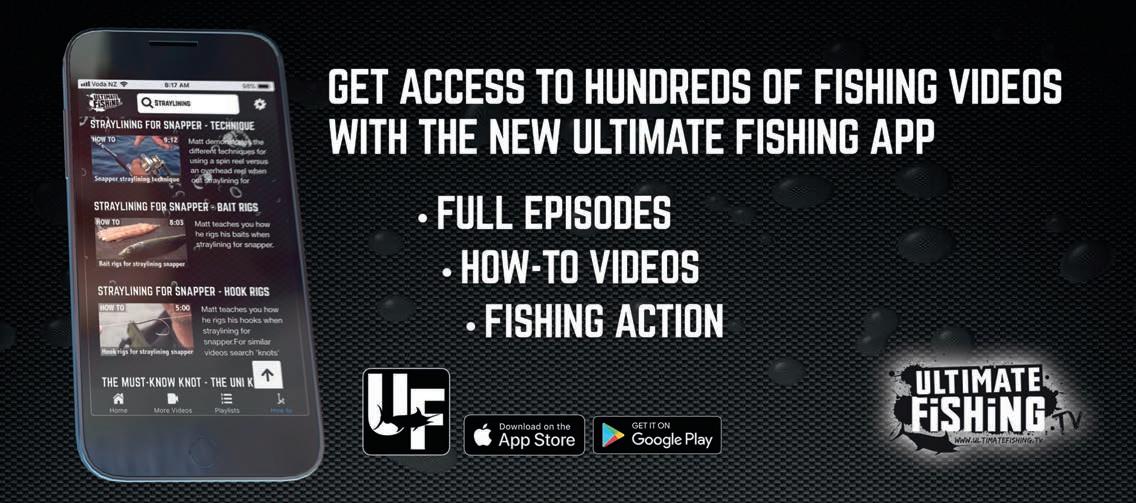



For Mainland contributor
Peter Langlands, freshwater perch are far more than just a pest. He regularly targets them in one of his local lakes and says they’re both great eating and a heap of fun. Peter explains…
The freshwater perch at Lake Forsyth, which is only 45 minutes from my home, offer a fun late winter and early spring fishery. Perch thrive in this lake, averaging about 1.5 kilograms. As the lake’s waters warm up, the fish become a lot more active and shoals can be encountered along the rock wall on the lake’s easily accessible western side where a walking track runs the lake’s length.
Casting out soft-baits is generally the most effective way to catch them, although I will put on a
small spinner, which can be cast further out, to cover extra water. Perch will often hit the lures hard, as they open their mouths and create a vacuum that violently sucks the soft-bait in. A few solid head shakes and then a characteristic run or two are the hallmarks of fighting perch. They can be stubborn fighters and I like to target them on ultra-light tackle using a 4lb braid mainline and a 5lb mono trace. The key with perch fishing is to realise that they are often in shoals, especially in early spring, and working the water more
intensively once you have hooked one up is often a successful strategy. For me, fishing locally at Lake Forsyth (Wairewa) is always fun as the lake is often uncrowded. It sits in a large valley with native forest and gives a feeling of escape from the city, despite being so close to home.
Perch are, in fact, widespread throughout NZ and are present in many suburban settings, notably around Invercargill, Dunedin, Hokitika, Christchurch, Wellington and Hamilton, as well as Auckland. They are very widespread in lowland areas and can often survive in small gravel pits, lakes, reservoirs and in slow flowing streams and backwater.
In many ways, your local perch fishery is a good gateway for getting young anglers into fishing as they are certainly a manageable fish. As mentioned, they give a decent strike, but are also a very attractive fish to look at with their bright orange fins, vertical stripes and cryptic olively green colour, along with some dramatic spikes on their dorsal


fins. Your local Fish and Game office will be able to tell you where the nearest perch fishery is and its season as all the perch fisheries in NZ are recorded on a database.
Minimal gear is required for perch fishing but a lightweight and sensitive spin rod with light braid is best and will allow maximum enjoyment when you hook up. Perch love soft-baits and a slow retrieve, and jigging along a steep bank will also often produce a strike. Unlike trout, perch are quite bold and if you miss them on the first strike, they will often have a second go at the lure. Keep soft-baits as light as possible so that they slowly flutter in the water and provoke a strike. It is worth having heavier jig heads for getting long casts out on lakes and to cover the water, and also for when you’re fishing the edges of larger rivers such as the Clutha and the Waikato. Covering the water with a kayak is also a fun way to target perch and allows you to fish over more water. A soft-bait cast from

a slowly drifting kayak is highly effective.
Perch love structure such as steep banks, overhanging trees and deep scour holes in rivers, but are also happy out in the open over weed beds, so taking some time to prospect is important. They also love the deep water along the edge of raupo and reed beds.
Freshwater perch are also a top eating fish and yield a firm and tasty white fillet (they’re nicknamed “freshwater tarakihi”). Generally, fish over 0.5kg are worth keeping. In New Zealand perch have been known to grow
1) Perch are a fun fish for kids to target and an attractive fish to catch – just watch those spines! 2) Perch are highly predatory and will nail bibbed lures.
3) Perfect perch territory. 4) Freshwater perch have firm white flesh and fry up well. Perch fillets are served here with some wild foraged herbs.
over 3kg. The fish at Lake Forsyth, averaging around 1.5kg, are an ideal size to fillet. Good sized perch also thrive in other large shallow lakes such as Lake Waihola just south of Dunedin. In some areas there are no limits on the number of perch that can be taken, such as on the South Island’s West Coast and catching and filleting large numbers of fish is encouraged (perch are highly predatory on a range of native fish such as whitebait and also

juvenile trout). Freshwater perch also freeze very well and are great for grilling and deep frying. Perch are certainly one of the fish I love targeting in the spring when the fish are most active, and are definitely an underrated fish in our spectrum of freshwater fishing opportunities.



After the successful 2020 Grady White Boats Tairua Boat Show, there has been a huge appetite from current and new exhibitors to repeat the effort in 2021.
Consequently, organiser Stuart Arnold is repeating the exercise this August 13-15, and promises that it will be ‘bigger and better’ with more exhibitors and an on-the-water aspect.
Another of the key changes is the introduction of a gate prize draw, open for all patrons who purchase the $10 entry ticket. Rather than having one big gate prize, there is a variety of sponsored product that patrons can win, headed up by the Maxxom RIB powered by a Parsun four stroke outboard. Other products to be drawn include a Lowrance GPS, ICOM VHF, Kilwell outriggers, Pacific spearfishing combo, and a Yamaha four-stroke outboard. All patrons coming through the gate will receive a digital subscription to Pacific Powerboat magazine.
A pleasing aspect for the
The 2020 show was considered a success by all, and this year promises to be even “bigger and better”.

organiser is that all exhibition space is sold, with others waiting to get in. Some of the biggest names in the New Zealand marine and recreational fishing and diving scene will have a presence, including this magazine.
“There will be over 100 boats on display from both established and emerging manufacturers,” Stuart says.
Included in the line-up are Surtees, Extreme, Makaira, FC Boats, Haines Hunter, Black Dog Cat, Grady-White Boats USA, Sportcraft Marine, Senator, Sealegs, Fusion Boats, DNA Boats, Circa, Offshore Boats, Takacat, Mac Boats, Jeanneau, HMD Purekraft, OceanPro, Brig, Southern, Innovision, Sports Marine, Princess Yachts, and Searay. Retailers such as Family Boats, Rollos Marine and Sportscraft Boats are supporting the show, some with multiple marques.
One of the highlights of this year’s show will be the on-thewater component. Weather permitting, there will be several craft available for test runs including those from Grady White, Jeanneau, Blackdog Cat, Brig and more.
For the big boat brigade there will be some luxury vessels on display, the biggest being a Princess 55ft luxury launch.
Specific engine displays from Yamaha, Honda Marine and Yanmar will be present, with other distributors supporting their retailers.
For the fishing fraternity there are great displays from Shimano NZ, Dutchy’s Fishing Tackle, CD Rods, Okuma, Smart Marine, Kilwell, Custom Lures, IceyTek and a great interactive stand from Catch Fishing Tackle with their Fight a Fish simulator. NZ Fishing News and the Export Fishing Competiton, a nationwide measure-based contest, will be exhibiting for the first time.
Divers are catered for with exhibits from Pacific Blue Sports, Beuchat, Splash Dive, Dive Zone and Rob Allen Spearfishing, and dive compressors from MONZ will also be on display.
The marine industry is well presented with huge stands from Smart Marine, Hi-Tech Plastics, Ultralon U-Deck, Narva, Griffiths Equipment and others.
The very latest marine electronics from Advance Trident, Simrad, Lowrance, Garmin,
Raymarine, Lusty & Blundell, Furuno, Fusion, Humminbird, Minn Kota, Icom and Baymarine Electronics Tauranga will be on display, giving patrons an opportunity to compare product side-by-side.
For art lovers wanting to decorate their home, there will be some fabulous artwork from Gary Longley Fishart; a fish woodcarving active display from local artist Tim Aldrich; and some great signage for the boatshed, home and boat from Give Us a Sign.
There will be the usual warm Coromandel welcome at the on-site Tairua and Pauanui Fishing Club, where drinks and refreshments will be served. You’ll also find a variety of cafes and restaurants close at hand in the main Tairua business hub.
Parking for the show is at the nearby Tairua Rugby Club facilities and is free.
Entry this year is just $10 for adults (children under 16 are free) with profits going to St John, Tairua Rugby Club and Tairua School.
This year, the event has enjoyed huge prize draw sponsorship from Destination Coromandel, Smart Marine, Advance Trident, Shimano Fishing Tackle New Zealand, Baymarine Electronics, Lowrance, Kilwell and Pacific Powerboat Magazine. There are some awesome prizes to win with every entry ticket, including a Maxxon Rib with Parsun Motor, Yamaha Outboard 4 stroke, Lowrance GPS package, ICOM VHF, Kilwell Outriggers and a Pacific Blue Sports spearfishing combo. Every entry at the gate will also get a 12-month free digital subscription to Pacific Powerboat Magazine.

U-DEK® is a great alternative to carpet, moulded non-skid or teak flooring on all types of marine craft.
Made from lightweight closed-cell foam, U-DEK® offers a high level of comfort underfoot, excellent traction in all conditions, whilst being durable, low maintenance and easy to clean.
Come along to the U-Dek® stand to meet with the authorised Installers for the local area.
Even if you have travelled far, we can put you in touch with the correct installer for your home patch.


Wettie will be at this year’s Tairua Boat Show! Come and see us to chat all things spearfishing and freediving. We will have a huge range of gear on display to check out as well. Whether you are a novice diver or an experienced old hand, there will be something of interest for you at this year’s stand.
Hella Marine, the lighting experts, will be on hand to enhance your vessel and visibility on the water. Showcased by the latest LED bar lights for forward illumination, Hella Marine floodlight technology is purpose engineered for illuminating cockpits, docking, or landing the big ones.
Also on display in Tairua will be Hella Marine’s durable LED navigation lamps and stylish LED interior lighting. Hella Marine is the professional’s choice for energy efficiency, elegant design and proven durability.

Vesper’s Cortex has redefined VHF by offering high speed, advanced monitoring in a simple, easy to use package. It’s combination of modern features can set any trailer boat up to be managed at the push of a button. GeoFence tracking allows users to keep tabs on the vessel’s whereabouts, while remote monitoring gives the ability to check fuel, water and batteries from a smartphone. For more equipped vessels, the system also gives the ability to turn equipment on and off (e.g. fridges) remotely. Cortex is also now available nationwide and will be on display in the Raymarine Caravan, Area D.

Be sure to visit Catch! Fishing Tackle at the 2021 Tairua Boat Show to check out their recently released Catch Black Label Livies soft-baits. They are manufactured from super tough recyclable TPR (thermoplastic rubber) material to resist bite offs and designed to swim like real fish. These lures feature a superior swim action; are PVC and phthalates free; nontoxic; UV infused; and very good at catching fish. You’ll also find lots of other new releases, hot deals, regular seminars, and all of Catch! Tackle’s experienced team will be on hand with advice or to listen to your fishing yarns.

For the second year in a row, Advance Trident is exhibiting at the Tairua Boat Show August 13-15. Come down and see us in the Electronics Hall to check out the latest Simrad, Lowrance, Fusion, Zipwake products and more. You can also get yourself in the draw to win a Lowrance Elite 7 FS Bundle valued at $1800. We look forward to seeing you there!


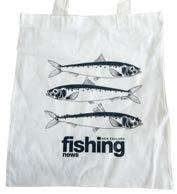

NZ Fishing News is offering show patrons a special premium subscription package. Not only will they get a 12-month print and bonus digital subscription to New Zealand’s premium fishing magazine, they will also receive:
A Vintage NZ Fishing News cap, Custom made NZ Fishing News Victory Knives filleting knife + sheath, NZ Fishing News cooler/tackle bag, NZ Fishing News tote bag (choice of three designs), NZ Fishing News bonus issue (September edition before it hits shelves!), CRC Tackle Guard and MPI shellfish measure. These will make a great gift for the angler in your life!
- $149
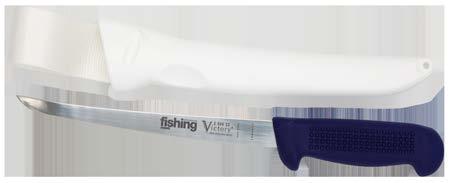


Mastertech Marine will have a large display of Extreme Boats on display at this year’s Tairua Boat Show with a range of models and sizes. There will be something for everyone from the smaller 605 Game King right up to the 915 Game King, so be sure to pop in and see the team.

Surtees Boats are known for their legendary smooth ride and the outstanding build quality on their full range – from the little 495 Workmate up until the latest 8m Game Fisher. Surtees will be showcasing our latest updates on the 495, including the new dash design, transom, and canopy/rocket launcher, as well as the workhorse 575 Workmate, the more offshore capable 610 Game Fisher and two different set ups of 750s –enclosed for the extended family trips and open for the keen offshore anglers and divers. The Surtees team will be on deck to answer all your questions and show you around the boats. See you there!
Catch up with Team Shimano at the main fishing tackle marquee in Area J at the Tairua Boat Show and check out all of Shimano’s newly released products for 2021. Now is the time to sort some great new gear for the coming season!


Bay Marine Electronics are a premium marine electronics specialist, with over 15 years of experience. Their knowledgeable team will be on site to offer advice and the latest gear to fit everything from the smallest trailerboat through to the biggest launch.

SURTEES • EXTREME • STABICRAFT • SOUTHERN • LAZERCRAFT BRIG • DNA • BUCCANEER • JEANNEAU • BLACKDOG CAT • MAKAIRA
FC BOATS • CIRCA • PUREKRAFT • ROLLO’S • SENATOR • FUSION
OFFSHORE • INNOVISION • MAC • ZEGO • SPORTS MARINE • SPORTCRAFT
WOODBINE MARINE • MASTERTECH • TAKACAT • SMART MARINE • BLA
HI TECH PLASTICS • ULTRALON UDEK • SEADEK • YAMAHA NZ • SIMRAD
GARMIN • RAYMARINE • FURUNO • HUMMINBIRD • BME • MINN KOTA
SPLASH • BEAUCHAT • ROB ALLEN • DIVE ZONE • SHIMANO • DUTCHY’S
FUSION
CUSTOM TACKLE
FAMILY BOATS
TRAILERS
PACIFIC BLUE
MONZ
SEALEGS
WHITIANGA MARINE
BOATMAGS
RODS
PAEROA MARINE
ADVENTURER
BALEX LEGASEA
COASTGUARD & MORE




With the large gold plinth for Boat of the Show: All Purpose Family Boat 7m standing beside it, Offshore Boats’ 650 HT was hard to miss at the recent Hutchwilco NZ Boat Show. Seeing the way it was laid out for family cruising and overnighting brought back memories of good times spent fishing and overnighting on Lake Taupo for Managing Editor Grant Dixon. So, what better way to put the boat through its paces than to revisit some of his favourite haunts aboard the Offshore?


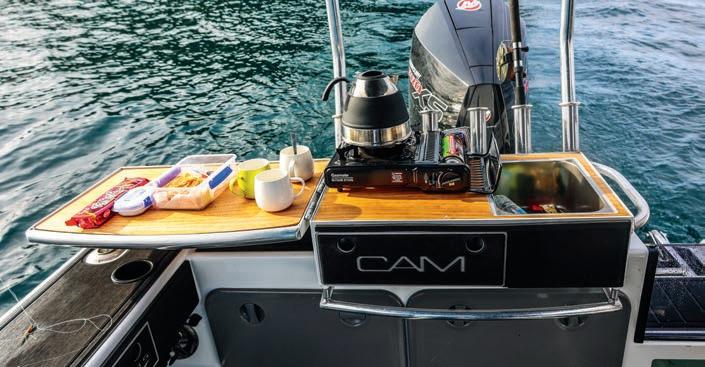
The cockpit on the Offshore 650 HT is fully enclosed with zipped and roll-up sides – perfect for overnighting and those chilly mornings on the lake.
1) The one-piece 6mm glass screen provides excellent vision from the helm.


2) Removeable side curtains help keep the wind and the rain from hitting anyone sitting on the IceyTek seat.
3) One of several innovations on the boat is this multi-function folding bait board. 4) This trout fishing is pretty easy! Jonathon with his first couple of fish caught on the harl.
Arrangements were made for my mate Paul Davies and I to meet Offshore Boats’ Jonathon Barlow early one morning at Kinloch for a day on the great lake.
The Offshore, as the name suggests, has a blue water pedigree and the short chop that greeted us on the lake was hardly a test, the hull handling it with barely a bounce.
We arrived at one of our favourite harling beats and set the lures. We had not finished the task when the first of a dozen fish nailed one fly, and then another was taken straight after – we were on a double. It was a great introduction to trout fishing for Jonathon, this being his first shot at freshwater trolling.
Action was steady throughout the morning, helped by low cloud creating dull conditions that saw the fish stay in the relatively shallow water longer than normal.
Powered with a Mercury 200HP V8 Pro XS, its Troll Control function allowed us to reduce the revs to around 500RPM which produced the slower speed (1.8 to 2.2 knots) perfect for harling flies, negating the need for a second trolling motor.
There is no shortage of innovation on board. The double use of space and function is a common feature, the ‘piece de resistance’ being the custom bait board/sink/six rod holders set into the transom. This provides the usual bait board functionality and when extended by flipping over the top, creates a table useful for preparing a meal when overnighting, boiling the billy on a portable gas stove, or as somewhere to put the snacks when relaxing at anchor in a quiet bay. A set of drawers built into the bait board completes the functionality. There is enough space to get a small gas barbecue under the transom battery and pump lockers where it will be out of the way.
Staying with the cruising theme, the cockpit can be fully enclosed with the sides able to be either zipped up or removed as required. The two rear support poles that fit into the rod holders on the bait board will get in the way when the fish chooses not to stay on the side it was hooked, but this is a very minor issue. We
left the smaller ‘quarter’ side-curtains in place. These offer great protection from the elements in winter without impinging on fishing space.
In the fully-lined cuddy, an infill completes a 1.9m long double-bunk setup with a chemical toilet in the forepeak (there is also an electric toilet option). While the cuddy does not lock up, a curtain provides privacy. The cut-out cuddy entrance creates an extra space for sitting in.
The space normally lost under the gunwales sees drawers included for all those angling essentials you don’t need out all the time but still want close at hand. The same applies in the cuddy under the shelving – drawers have been created for the likes of the first aid kit and flares, which are labelled.
Another feature of the boat is the number of critically placed handholds around the gunwales, under the hardtop, in the cuddy and on the duckboard – everything is there to make life easy in what can at times be a moving platform. If you are open beach launching, there are plenty of handholds to keep the bow pointing into the oncoming waves, something not every boat has.
If you are into a wide range of fishing methods and need to carry plenty of tackle options, fear not, there are 11 spaces in the rocket launcher



1) A zipped section in the bimini gives good access to tackle in the rocket launcher. 2) The wide-angle view showed not only the boat’s good use of space with the under-gunwale drawers, but the cockpit-long shelving and the extensive use of U-Dek throughout. 3) The livebait tank sits under the transom access.
and a further six across the bait board along with more tackle storage under the cockpit floor. And that doesn’t count the eight conventional trolling rod holders in the gunwales. The latter are accompanied by recessed bait/ drink holders.
There are two tuna tubes and an aerated, blue light-illuminated livebait tank included in the walkthrough transom space, as are two electric reel/downrigger power ports – you can tell this vessel has been fitted out by a hardcore fisherman!
U-Dek covers the boat wherever needed, which is not only a safety and comfort feature but helps keep noise to a minimum. Adding to the soundproofing is
upholstery in the underside of the hardtop and the fact the hull is manufactured from 8mm plate helps deaden any noise further.
There is plenty of lighting, mostly Hella. Floods illuminate the cockpit working space, a light bar on the front of the hardtop lights the way forward, and there are also under gunwale strip lights and plenty of lighting under the hardtop and in the cuddy. The cuddy top is covered in black U-Dek, providing not only grip but also reducing the glare from the light bar above, improving night vision when in use. Piranha P3 underwater transom lights complete the setup.
Cleaning up is not a problem with both a conventional
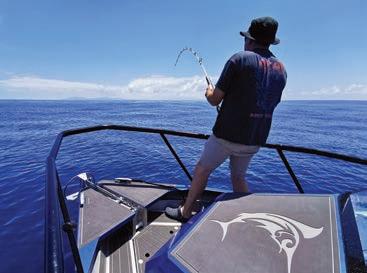
• Durable & light-weight
• Easy maintenance
• Fully customisable with extensive colour range & routering options available
• Full Installation or DIY options available
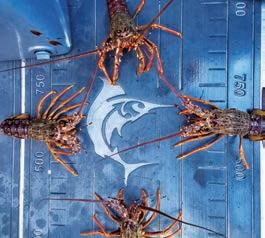
washdown hose and 40 litres of freshwater on board.
Anchoring is at the helmsman’s fingertips, courtesy of the popular Maxwell RC6 electric capstan.
There are lots of little things done well on this boat. A perfect example is the way the floor welds are recessed slightly to improve cockpit drainage towards the stern scuppers.
The bimini top, which can obstruct access to rods in the rocket launcher, has a zip in it to make tackle selection easier. I am not sure how waterproof this would be in a downpour, but its functionality gets the big tick.
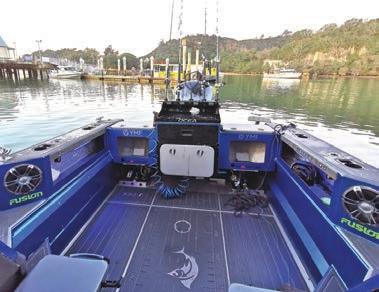
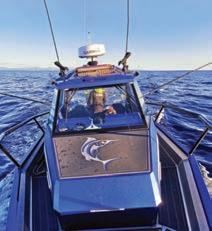

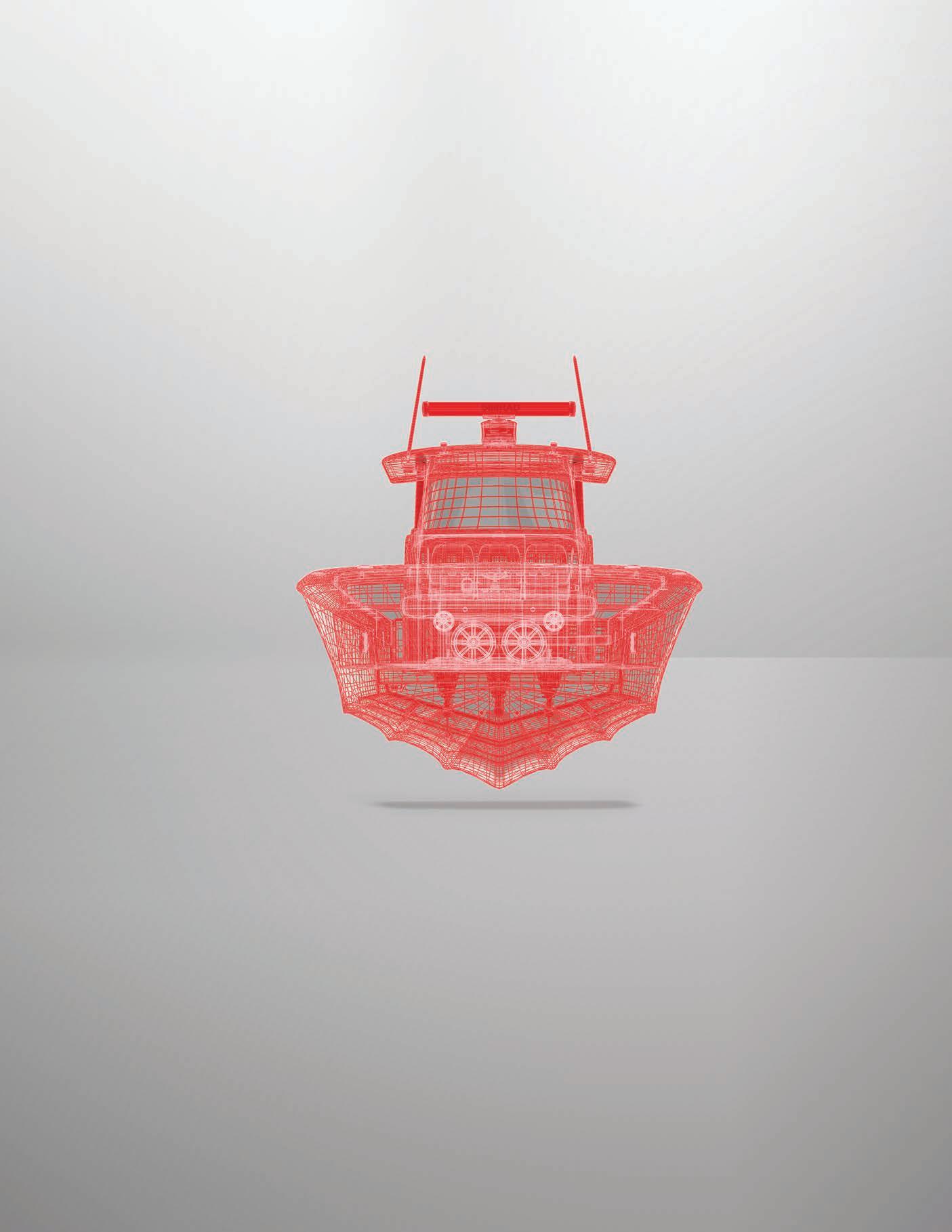









Whatever your activity, we have the ideal setup for you.
Expand your system with Simrad® modules and accessories - advanced fish-finding tools and radio technology, legendary HALO® radar for increased situational awareness, and automated control with a fully integrated autopilot.
With multi-display systems linking all your on-board electronics and real-time data at your fingertips, we have the right technology for you. Intelligent fishfinding systems for complete control.
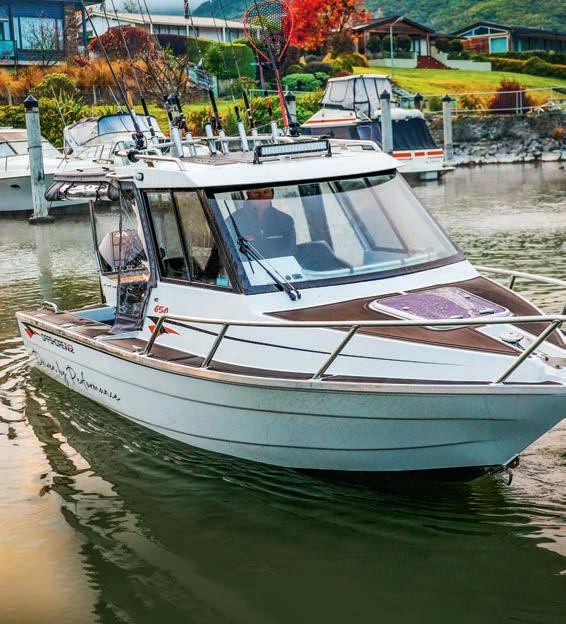



Having gas struts on the underfloor hatches makes retrieving and stowing items easier. The hardtop has U-Dek on it, making it a good place to store dive bags to free up cockpit space.
The cockpit canopy folds up and can be stored up forward for travel or for when you want unimpeded fishing space. Jonathon says it takes around 15 minutes to convert from cruising to full-on fishing mode.
There is plenty of space on the helm station for a decent screen – in this case a Simrad NSS16 Evo 3S – along with the Simrad VHF, Fusion Apollo Stereo, Lenco tabs, Maxwell
RC6 capstan controls, and all the standard switches including USB charging.
Headroom, at 1.95m, is more than adequate for most.
Seating in this boat was cantilevered out, leaving space for two 70-litre IceyTek bins with upholstered squab tops that provide additional rear-facing seating. The helm and navigator seats are Hi Tech Plastics Elite bolstered seats that both swivel and slide.
The pillarless windscreen is a great feature. Manufactured in one piece, the screen offers fantastic vision from the helm through an uninterrupted 180 plus degrees. The sliding side windows are large enough to get your head out if necessary.


 The Offshore 650HT has great performance pedigree and can be customised to suit the sportfishing style of any owner.
The CAM alloy trailer features a 600lb winch for retrieving the vessel when power loading is not permitted, as is the case at the Kinloch Marina.
The Offshore 650HT has great performance pedigree and can be customised to suit the sportfishing style of any owner.
The CAM alloy trailer features a 600lb winch for retrieving the vessel when power loading is not permitted, as is the case at the Kinloch Marina.

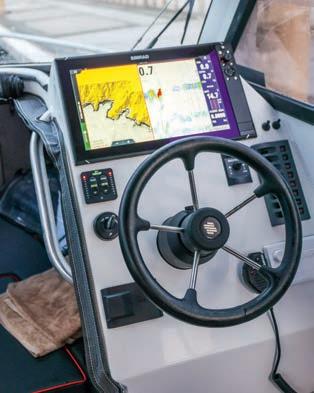
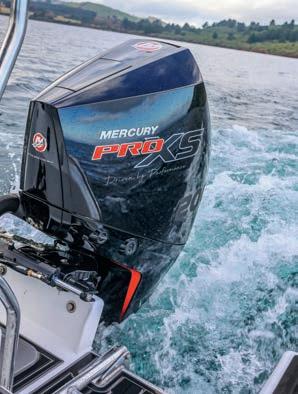
The Offshore 650HT was powered by the Mercury V8 200HP Pro XS which provided more than enough boogie (we tapped out at 46 knots in flat calm conditions) for a hull of this size.
Cruising speed was a stately 23 knots at around 3800RPM, burning just a tad under 30 litres per hour. Given that this is a performance motor, the economy was good and as already mentioned, with Troll Control we could hold the revs steady at 500RPM, which is perfect for trout trolling and livebaiting for kingfish and larger pelagics. In this mode, the motor was noticeably quiet, its previously growl de-tuned to a quiet murmur!
It is difficult to judge this boat’s rough weather capabilities – we didn’t find any on a benign lake! As much of the weight as possible is kept down low which assists with its performance, and stability at rest.
The fine entry and 18-degree deadrise should provide good rough water performance, and there were no stability issues in the calm when all three of us moved to one side – a very stable platform assisted by a reverse chine which also makes for a dry ride. The hull was designed by Alan Walker with input from Jonathon.
The rig is carried on a custombuilt Custom Alloy Marine (CAM) trailer, which is braked on both axles and features a 600lb winch, boat catch, guide poles and stone guard. Launching and retrieving
was what I would expect of a trailer of this calibre and as I didn’t tow the rig on the road very far, I can’t comment on its ride other than to say the product comes with good raps from other users I have spoken to. With a dry towing weight of 1800kg, my Ford Ranger FX4 would be more than a match for it.
From what I experienced on our day on the lake, I was impressed with the Offshore 650 HT for several reasons, namely the quality of the finish, the innovation and the performance. Jonathon has suggested our next outing should be in Hokianga, one of his favourite haunts – I can’t wait.
The boat didn’t display any vices and I was impressed by the innovative design this Whangarei based manufacturer has produced.
Length OA 6.5m
Beam: 2.45m
Deadrise: 18 degrees
Hull thickness: 8mm
Sides: 4mm
Stringers: 6mm
Height on trailer: 3.0m
Width on trailer: 2.5m
Length on trailer: 8.0m
Towing weight: 1800kg
Fuel: 200 litres
Recommended HP: 150-225
Boat as tested: $215,000




 The well-laid out and spacious helm station.
The well-laid out and spacious helm station.



Veteran spearfisher Darren Shields recently took a couple of diving newbies out on the water, which got him thinking about the basic principles of free diving.
Recently, I took out some old friends from another industry I used to be involved in. We hadn’t seen each other for years and they hadn’t been exposed to spearfishermen/free diver hunter gatherer types at all.
First up, they assured me they had experienced rough water boating and a little bit of wind
and waves were no problem! The forecast was for 16 gusting 21 knot south easterlies, and as we emerged from the harbour entrance and launched off the first half a metre swell, I heard “Oh shit” from my friend!
He then said these must be two metre seas! I carefully told him, “No, about half a metre.”
I got the ‘yeah right’ look.
I stopped and made sure they were okay with continuing, and assured them that once we were in the lee of the island all would be flat calm.
The first lesson for these newcomers to our sport was that we do go out when it’s a little choppy at times.
Once we reached a safe anchorage, I told them exactly
what I was doing. My friend’s wife seemed a little confused as to the concept of snorkeling while towing a float boat and putting catch in it. I could see she had scuba diving and freediving confused.
Lesson two: we dive down holding our breath, retrieve our catch, and stay underwater anywhere from two seconds to three minutes depending on ability.


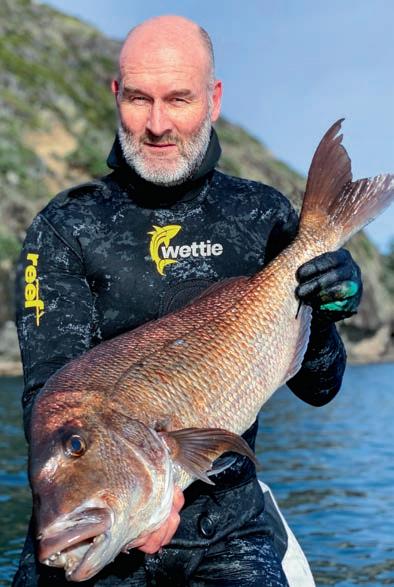
We dive down anywhere from just under the surface to 50 metres, again depending on ability, but there are only a limited few who can truly dive past 30 metres safely. I’m not one of them these days and don’t attempt it (most really successful catches are taken in less than 10 metres of water).
Next up, I let them know I could be gone for over two hours, and jumped over the side. I also told them that I could end up a long way off the coast, so it’s crucial boaties

take note of divers’ flags and floats or float boats. Even if you can’t see a diver, there will be one very close. Slow down to five knots within 200 metres of a dive flag –that’s the law! Yes, the law! Many boaties take absolutely no notice unfortunately.
After being gone for my second stint of the day they asked if I was cold. They couldn’t believe I hadn’t eaten anything as it was around 2pm by now.
Modern suits keep us completely

warm all day and as far as food goes, you do get hungry, but it doesn’t pay to eat too much as our whole bodies continually come under pressure on each dive and depending on depth, it can be very uncomfortable for your stomach if you are wolfing down the food.
Sharks also came up in conversation. Yes, we see them most days now. They aren’t the terror we remember from the Jaws movies or read about in the over hyped reporting by media that is

designed to get you reading their nonsense pieces.
They give us some grief, but it’s generally around taking your catch when you are not looking. In saying all this, I would be a liar if I didn’t admit to at times being concerned, but here I am after years of diving and I still have all my limbs!
One of the reasons we tow a float boat is to get our bleeding catch out of the water and mitigate sharks’ interest in what we are doing. Once the fish is in the float



1) The writer tries not to waste anything. Heads make great soup as well as tasty pickings. 2) The writer eventually found some male crays – all the females had eggs and are illegal to take in this state. 3) The big fins make swimming easy. 4) Crayfish, egg, wild pork bacon, capsicum and balsamic dressing – delicious. 5) Utilising the catch is important to the writer. This snapper bite salad is easy to make and extremely healthy.
boat, the sharks can’t smell it anymore and generally move on.
Our fins are very long and look very hard to swim with, but the opposite is true. To be efficient in the water, we need easy propulsion. Short small fins or split fins don’t allow this.
We as hunters see so much more than someone above could imagine and we can be extremely selective in what we target.
On the day I have talked about, I swam for two hours before I actually pulled the trigger. I did see fish but not the quality fish I was after.


Was I exhausted? No, not really. The gear makes it very easy, plus once you have done the sport for a while, muscle memory makes it easy. Could I run a kilometre nonstop? Not on your life. Running for me is too hard but I guess if I practiced it would become easier.
I also pulled out a few crayfish, but all had eggs so I returned them to their holes. It’s illegal to take them in this state – it’s a shame we don’t have the same rules around fish! Eventually, I found a few male crayfish but I had swum for close to three hours by this time.
Spearfishing/freediving hunter gathering is easy with a little practice and thought. It’s very safe done correctly and it’s a hell of a lot of fun.
So, why not give it a go?




Most anglers have an appreciation of the moon and tide and the effect they have on their catch, but few understand why.
Maori have used moon and tide phases to accurately predict the outcome of fishing ventures for centuries – their survival depended on it. And this understanding was not just vital to fishing, but to planting and harvesting essential crops as well.
The mystique that surrounds maramataka – the traditional Maori lunar calendar where each year has 12 months based on the cycles of the moon – is revealed in Moon Tide Fishing, a 13-episode lifestyle series currently running on Maori Television.
Producer Martin Cleave of 2B Media says there have been attempts at producing shows and calendars based on the wellknown ‘Maori fishing calendar’, but they have never captured the true essence of maramataka
Show host Nore Martin gives the old teaching and traditions, orally handed down over the years, a modern context.
“Fishing with the maramataka has always been at the forefront of my mind, imbedded in my harvesting way of thinking in terms of using the moon, tides, weather and currents,
but I didn’t realise I was actually doing it,” Martin says.
Whether you are a keen angler or a novice participant, Martin suggests that after watching 13 episodes of Moon Tide Fishing, you will approach your fishing from a new and refreshed perspective.
Nore Martin started his work career as a dive instructor and has gone on to work in the public sector, whether it be on a paid or voluntary basis.
With a huge respect for the teachings of his tupuna (ancestors), Nore has set out to share this knowledge with all New Zealanders, drawing on a wide range of experiences and interviews with those who have an intimate knowledge of the subject.
He says that while there may be local influences, as a general guide, maramataka will be accurate in most locations around New Zealand, maximising your chances of a productive day fishing or gathering kaimoana.
“One thing is for certain, I love fishing and diving, and enjoy using maramataka each day. In the series if I can encourage and educate the new generation to engage, then we will have achieved something great,” Nore says.
Moon Tide Fishing screens on Maori Television, 8:00pm on Tuesdays.


Aserial offender will face serious charges after thousands of empty paua shells were discovered at his home recently during a search warrant executed by MPI fishery officers.
Police on patrol in Eastbourne, Lower Hutt, near Wellington, stopped the man and discovered 95 paua in his car.
MPI’s national compliance manager, Steve Ham, says MPI worked with police to establish whether the man had more paua in his possession.
“This man is well known to us and he’s been in front of courts 11 times on fishery offences.
“The rules are there for a reason – to ensure sustainability of the fishing resources so that everyone can have the opportunity to put kaimoana on the table,” Mr Ham says.
“Fishery officers undertook a search warrant at his house and found the shells. He had been burying some in the garden.
“We also found 30 kilograms of paua meat at the house.
“Working with the police provides us with much greater reach and we are grateful for the excellent inter-agency collaboration, good teamwork, and an excellent result.”
The man will face serious charges under the fisheries act.
MPI encourages people to report suspected illegal activity through the Ministry’s 0800 4 POACHER number (0800 47 62 24).


Steve Dickinson spoke to a range of cold weather experts – fishermen, search and rescue, alpine guides and ski patrol –and shares their input on how to stay warm and enjoy winter fishing.
We all do it. The same is true for boat fisherman, rock fisherman and fly fisherman – when it gets chilly, we tend to back off. Fish are no different. Like many people, they tend to be less active in the cold. As cold-blooded creatures, their metabolism dips when temperatures take a dive. But
they still have to eat, maybe a little less, but if they eat, they can still be caught – simple. So, with that in mind, the following is a few tips on how to enjoy your winter fishing.
The simple key to enjoying the cold is staying warm. If it gets cold and you want to stay warm, the first rule is that you need
to keep dry. However, fishing and keeping dry may not be as easy as it sounds. The simplest solution is to have a dry towel to dry your hands with after catching a fish or to dry your legs with after launching a boat. In winter, I keep a dry towel in a dry bag on the boat just for towelling off, and a second towel to dry hands after catching fish. The smallest hole in your waders will let in icy water,

and once your clothes are wet, especially if they are not wool, you will get cold quick.
The second must-do is to keep your head warm. We lose 80% of our body heat via our head. It would be best if you had a woollen beanie, balaclava or buff. Of late, I have been using a buff
because they are versatile; if you get too hot, you can pull it down to your neck and if it gets cold, you can pull it up over your ears and head. But buy a good one. There are loads of cheap synthetic ones on the market that are next to useless. A beanie and a buff can also be a good combo if it is chilly. A word of advice: if you pull the buff up over your neck and mouth, your breath will cause
condensation, which makes the buff wet; remember, keeping dry is the key.
After making sure your head is warm, you then need to look after your other extremities. Starting from the ground up, make sure you have woollen socks; once again, do not buy cheap. Even if
the product says merino, not all merino is created equal. You tend to get what you pay for. Merino is light weight, breathable, and manages moisture by a process called wicking – it will pull moisture away from your body which, if chilled, will make you cold. Merino is also anti-bacterial and odour resistant. Never use synthetic or worse, cotton, as it is quick to suck up water, slow

to dry and should never be worn next to your skin. If, like me, you find wool itchy, there is now a range of synthetic/wool blends and silk/wool blends that are easy to wear. Wool dries quickly and will retain some heat if it gets wet and has excellent thermal qualities – just ask sheep.
Your other extremities are your hands, ears and nose. There is a
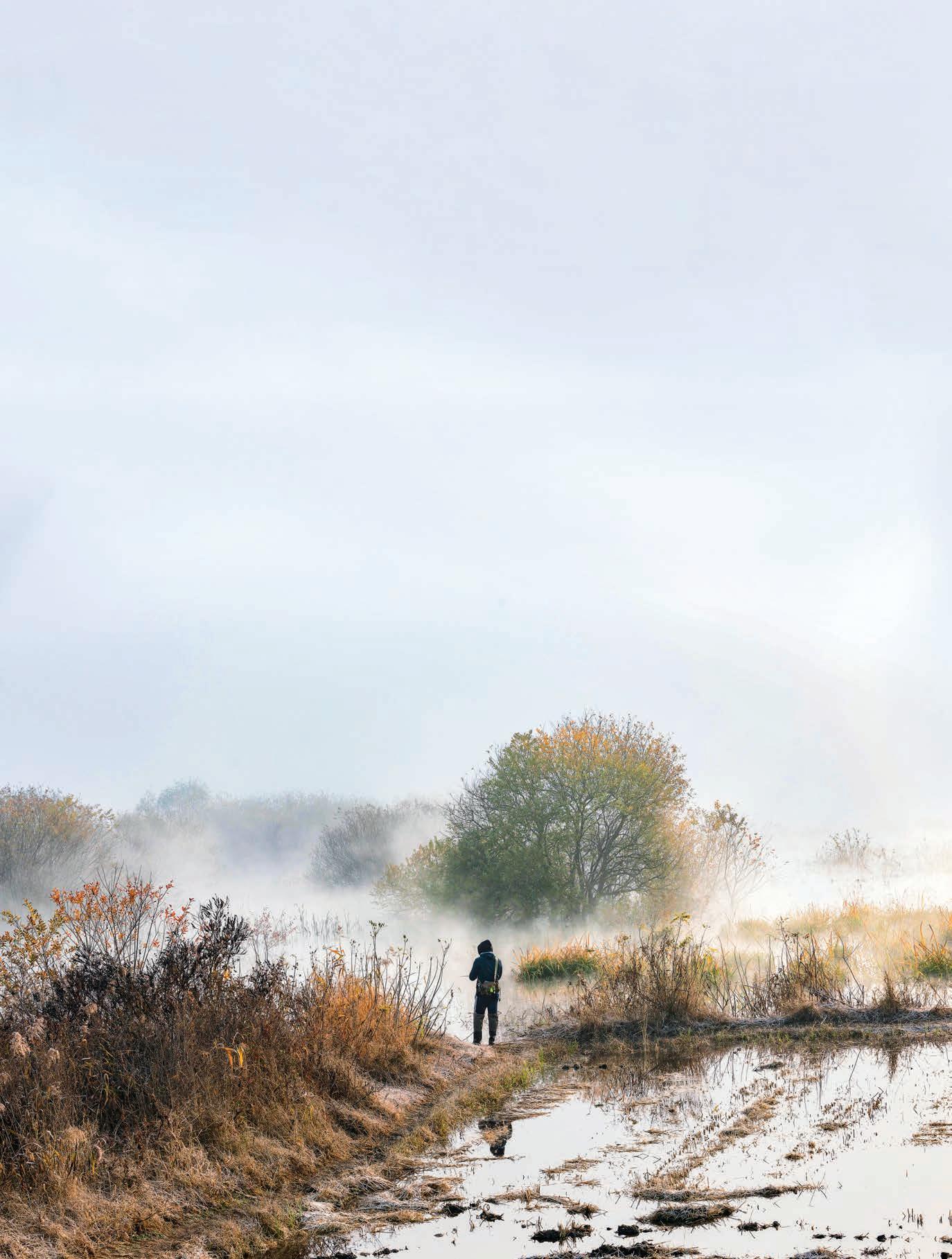
range of fingerless gloves on the market which are great for fishing with. A well-known fishing guide showed me a trick once – he had an additional pair of extra-large woollen gloves that he wore over his fingerless gloves for travelling. Your ears and nose can be looked after by your neck gaiter.
There are a range of commercial hand warmers. They come in
various sizes, and some are reusable. You either snap or mix them, which causes a chemical reaction, and they warm up. Do not put them in your gloves –instead, put them in a pocket so that if your gloves do get wet, you can warm your hands up. I have heard of people putting them in their socks in their waders, but if it is that cold, maybe stay home. If you cannot find them in your local fishing store, look to any ski outlet. Reusable ones are more expensive, but with repeat use they become a far better deal.
There is an art to layering. The essential rules are: no cotton, only wool, and some fleece and microfleece. Over the last ten years, there has been an explosion of quality layering products. There is now a full range of base layers, mid-layers, and top layers. It is simple: when it’s cold, put more on. Unlike tramping where you are constantly moving, you need to be warm from the get-go when
fishing. This usually requires fleece-based legging or pants. I have two different thickness fleece leggings I wear under my waders, depending on how cold it will be. On top, I wear a super lightweight, short-sleeved RAB microfleece; this is my go-to product for winter and summer. As a mid-layer, I wear a long sleeve merino, and if it is going to be cold, I add another layer on top, but I make sure I still have my full range of movement (not too tight for the last layer). A jacket on top finishes my outfit. An obvious observation is that you can always remove a layer, but you can’t always add one. You do not want to be too hot so that you sweat, as sweat can chill off and make you colder. You want to be comfortably warm, and layering is a way to maintain this.
When it’s cold, drink plenty of water. Hot tea and coffee might seem like a good idea, but you will need to pee, which
means exposure to the cold! A good option is hot water or hot chocolate. What is an absolute ‘no no’ is alcohol in any form as it lowers your core body temperature (even if it feels warm to begin with).
New Zealand is renowned for having four seasons in one day so be prepared – check the forecast but do not 100% believe it. Even if it says it’s going to be warm and dry, be prepared for the worst.
In winter, it also pays to fish with a friend. Should you take a tumble into the water, someone is there to help out, and in the worst-case scenario, go for help.
When we think of hypothermia, we think about people trapped on a mountainside in a storm, but it’s far more common than this. Hypothermia can quickly occur when you are exposed to cold air, water, wind, and/ or rain. Your body temperature
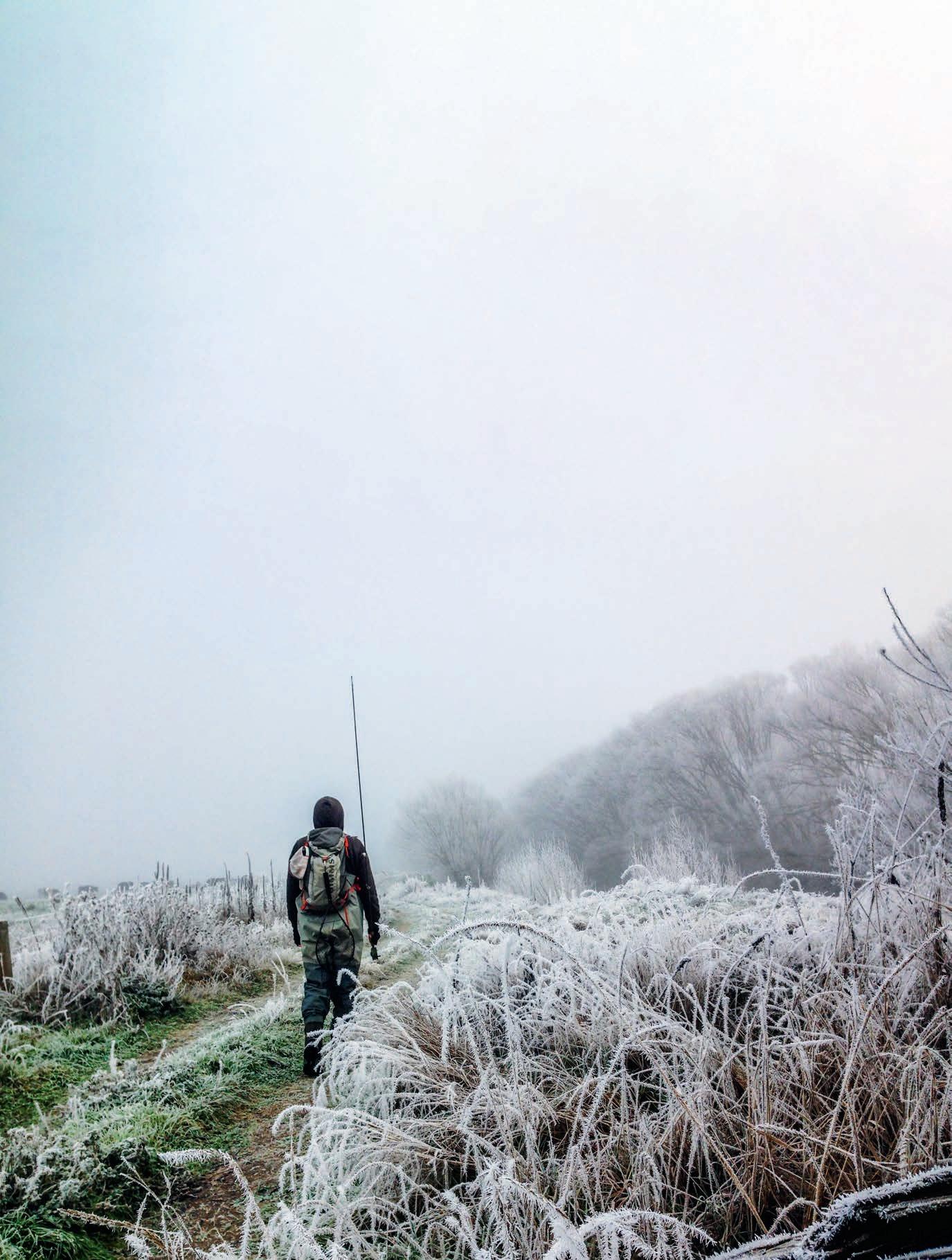
Winter shouldn’t stop you from going fishing – but taking every necessary precaution is essential.
can drop to a dangerously low level at temperatures of only 10° or even higher in wet and windy weather. If you are in 16° to 21° of water, you are also at risk of hypothermia. It can happen quickly – I once got hypothermia waiting for a bus in winter.
The symptoms and signs (not all may be present) are:
• Person feels cold to touch and may be shivering violently
• Tiredness – person may fall behind when walking
• Clumsy, uncoordinated – may fall over and appear drunk
• Changes in mood with irritability, irrational behaviour
• Person may resist help
• Slow to respond to questions
• Shivering may decrease and stop – this is a critical sign
• Loss of consciousness
• Pale or blueish skin colour. What can you do?
The best treatment for hypothermia is prevention. But if you suspect hypothermia, try to stop further heat loss and warm the patient slowly.
Provide immediate shelter out
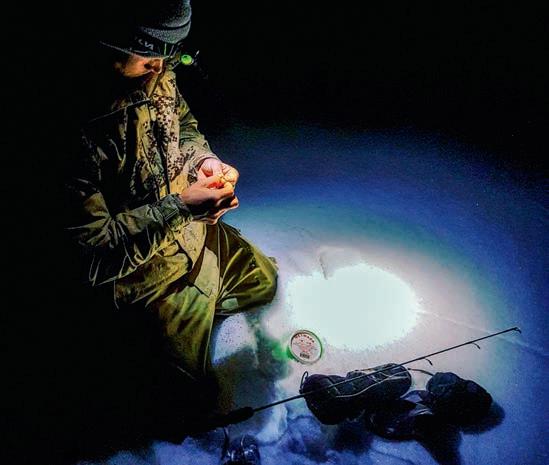
of the wind and dry clothing. If fully conscious, give warm drinks, lollies, chocolate, etc
If isolated, body contact reduces heat loss – e.g. huddle around the patient in a sleeping bag.
Winter fishing is all about comfort and safety. The two should go hand in hand. In most cases, there should be little risk
as long as people are sensible. In winter, it pays not to go too far from your safety access – your vehicle, accommodation etc. However, if you are going further afield, you need to make sure you are prepared.
Prepare for the cold, prepare for the worst, and you will be comfortable, safe, and ready for winter fun.
Overseas ice fishers overseas know how important it is to keep warm at all times.
Soft-baiting from the shore, and in particular off the rocks, is the ‘final frontier’ of snapper fishing, suggests Bay of Islands contributor Jack Worthington.
Using soft-baits on the bricks can be extremely effective. It’s stealthy, with no loud hull slap of a boat spooking fish in shallow water, and the thrilling battles on light gear are hard to beat.
Landbased lure casting hooked me in the summer of 2019. I was out for a routine cast at my local hotspot looking for a feed of pannies when I witnessed a six kilo snapper fly in and smash my soft-bait on the surface. At the time I had never seen anything like it –strong headshakes and blistering runs followed as it weaved through the reef. Landing the fish with
such a light leader was even more difficult.
Over the next few months, I spent hours at this same spot, landing a few similar sized fish and getting dusted by plenty more. Since that day I have put serious time into this method and I truly believe it can compete against the typical straylining approach.
My absolute favourite characteristic of landbased soft-baiting is the sheer amount of options it gives you. Ditching the bait, berley and stationary nature of straylining opens up a wide range of spots many fishermen would never even

consider. The ledges I look for are usually shallow, super reefy and often at times completely submerged at high tide. Straylining at these types of spots can be annoying on the best days, and infuriating on the worst. When you are casting soft-baits, you are not limited to the placement of your berley; instead, a mobile approach is taken. A long stretch of coast that you can walk along is the perfect country to soft-bait. The more different areas you can cover, the better. This offsets the advantage that berley has – rather than bringing the fish to you, you are seeking out the fish. Maybe it is just my inherent preference for

Yet another big kelpy that the writer has landed on light gear from the rocks.


If you’re after a trophy snapper, soft-baiting in the shallows is one of your best options.

predator rather than as a scavenger has a strange satisfaction to it.
It’s very easy to bring the bait and berley as a ‘backup’, and end up using it by the end of the day. When I was starting out, I would often ditch the softies after a couple of casts with no takers, immediately switching back to bait and berley. Having faith in the technique is vital. He who does the casts catches the fish, so leave the bait at home and be prepared to flick hundreds of casts out. It feels like you are wasting your time or doing something wrong until that first good fish comes along and then it’s all worth it.
Regular soft-baiting tackle will usually suffice, but a bit more strength can definitely be helpful. I use PE 2 braid paired with 20
for strength, castability and bite frequency. I have experimented with leaders up to 30lb, but noticed a reduction in bites, so I stick under 25lb now. I know of many anglers who soft-bait with 30lb fluorocarbon exclusively and are very successful, so take that as you will. Use what you are comfortable with and experiment until you find what works best for your area.
A graphite rod slightly longer and heavier than the norm is ideal.
I use an eight foot rod rated for 15 kilos. This is typically heavier than what one would use while soft-baiting from the boat, but off the rocks I have found myself in multiple scenarios where I have been thankful for the extra power. Rods rated as low as 6-8 kilos will suffice; however, I would never go lower than that unless you are not expecting to catch anything bigger than a pannie.
Lastly, soft-bait choice. People
have their theories about lure colour and what to pick when but I am not an expert on this, so I follow a different approach. I look through my soft-baits and pick a colour that looks lucky. I prefer 7” jerk shad tails, but often (especially in winter) downsizing to a 5” can mean the difference between a productive day and walking home empty handed. Curly tails are a must have. I find these baits work best when the fish are shy on the bite. If I don’t catch anything on my first choice of softbait, I switch, and so on. I’m not sure what the best baits are for the corresponding water colour, clarity, tide, and turbulence, but I do know that experimenting with colours/ shapes and having a selection is absolutely vital.
Tight or loose drag?
A mistake I see a lot of people making – and one I made myself at the start – is instinctively and immediately tightening the drag once the line starts hissing out. It
for a cast.


is the reality of light gear that you are not going to be able to stop a big fish in its tracks, and attempting to is almost always going to guarantee failure.
Often a lighter drag can be ideal. I came to this conclusion after getting decimated time and time again by the bigger models. I started to seriously wonder how I was supposed to land these brutes. Following a few suggestions from more experienced fishers than me, along with a healthy dose of internet-scouring, I came to the conclusion that I was running toohigh a drag setting. It might seem counter-intuitive to fish a lighter drag in super-foul terrain (1-3m deep), but in practice it works surprisingly well. Where before I was locking up and causing the big moocher to head straight down and cut me off, a loose drag gives them room to run. In such shallow water, they tend to run, and run and run. Rather than getting their heads down and going straight into the rough stuff, they often ‘plane’ over it all,
slicing through the midwater and keeping the all-important braid unhampered.
Make a battle plan before you start casting. Look for the highest point on your ledge that you can access. Getting up high while fighting big fish can be super helpful for keeping their heads out of the kelp. It also makes it easier to see what the fish is doing and adjust your tactics accordingly.
Moving around is key in these fights. Too many-a-fish I have lost and seen others lose due to the initial shock of that first steaming run locking you in place. As soon as that line starts hissing, start moving.
Snapper often run directly against the pressure they are feeling, so it can sometimes be possible to ‘steer’ the fish by changing the angle of the rod. When you are up high and you see your fish gunning it to the reef, rapidly swapping the angle
of your rod can be enough to convince the fish to swim the other way.
My next big success was an 8kg kelpie hooked at dusk. This fish provided me with the battle of a lifetime. The pathway leading to my tidally locked rock was slowly being flooded by an incoming tide, and I was soon going to be cut off from land. The fish took on the surface and screamed off, by chance veering away from the worst of the reef as snapper sometimes do. This fish fought all the way to the rocks, even taking me into the water once while I tried to land it without a net. Moments like this are burned into my brain, making for some of my favourite fishing memories.
As winter rolled back around, I started putting in proper time on the bricks again, scouting out new spots and trying different techniques. These efforts culminated in my biggest snapper off the rocks to date, a perfect 20lb/9.1kg snapper, which was coloured like no other fish I had ever seen.
It was a true moocher, missing whole patches of scales that had regrown and come off again. Its fins were worn from decades of rubbing up against the rocks and its bare gill plate was exposed in some parts. This fish was followed up one month later by a fish of the exact same length and weight; however, it was in a much healthier condition. The latter fish put up a scrap so intense that I was sure it was a legal kingfish. These animals are different beasts in the shallows. Say goodbye to the ‘straight run’ they often commit to in the boat. Fish like this in these shallow depths will go all over the place, and will not stop fighting until either you win or they do.
Soft-baiting off the rocks is definitely an underrated method. Winter is the perfect time to head out to your local ledge (or scout out some new ones!), and go for a cast. The results will surprise you.
If you’re keen to be more adventurous with your fishing platform, keep an eye on the tides and plan an exit route.

 Snapper are not the only fish that will attack a soft-bait. Pictured is a decent pigfish caught by Shaw Watson. Right: The writer with a great example of what can be caught on light gear off the bricks.
Snapper are not the only fish that will attack a soft-bait. Pictured is a decent pigfish caught by Shaw Watson. Right: The writer with a great example of what can be caught on light gear off the bricks.

ALL WORK AND ALL PLAY.


For young contributor Hayden Speed, soft-baiting offers a fantastic all-round option for catching a range of species. He explains some of the basic principles for those still yet to give it a go…
Some days you don’t have time for a big strayline session, and at other times you can’t be bothered with the blood and guts that come with a messy bait session. This is where soft-baiting comes in handy –and there are times when it will actually out-fish bait! The average size will also be better too as you don’t tend to catch juvenile fish on soft-baits. As an added bonus, you don’t tend to gut hook fish, making catch and release an option.
Casting a soft-bait is very popular on both boats and kayaks. It’s also a cheap form of fishing to get into – a $100 soft-bait setup will get you started.
Soft-baiting can be successful almost anywhere: land-based, along sandy beaches, over reefs and in harbours. When I’m softbaiting, I will often fish in depths from right up in the shallows out to around 30m. My favoured depth is 12-20m due to the gear we use and locations we fish. Soft-baiting can be done in deeper water too, but you may need to revisit your gear. A heavier jig head and potentially heavier tackle, depending on the target species, will be required.
When I’m fishing soft-baits, I like to use a purpose built softbait rod, which allows me to cast further, work the lure more effectively and detect bites! I like to use a small spinning reel anywhere from a 2000 to 4000 size, spooled with 10-20lb braid. It’s important to use braid as it has very little stretch, meaning you are more likely to feel any subtle touches from a fish. The lack of stretch also means you can put more movement into your lure. For example, with braid, if you move your rod tip 30cm, the lure will
most likely move close to 30cm also. With mono, if you did the same, due to the stretch in the line the movement of the lure would be significantly less and certainly wouldn’t be as sharp. Braid is also much thinner in diameter compared to mono, which means it will have less drag through the water, possibly letting you use a lighter jig head. The thinner diameter also means that you will get more line on the spool, and you will be able to cast longer.
I like to use fluorocarbon leader as it provides a bit more abrasion resistance than other leaders, and it is apparently less visible to the fish. If I’m fishing over a sandy beach/clean bottom and the fishing is a bit slow, I’ll drop down as light as a 15lb fluorocarbon leader. If there’s one thing that I’ve learnt from my fishing experiences to date, it’s that using lighter lines and leader will definitely get more bites. However, the risk you take is having less strength and abrasion resistance to battle a big fish with. If I’m fishing over a reef and there’s a likelihood of hooking a big fish, I’ll use a fluorocarbon leader as heavy as 30lb. This will give you a bit more protection from the reef and may be the difference between landing the fish and getting busted off.
To connect the braid to the leader, I like to tie an FG knot. The FG is definitely strong but can be a fiddly knot to tie. An alternative option that isn’t quite as strong is a four turn ‘overhand knot’. When tying the overhand knot, it’s important to pull both ends of your knot up evenly without leaving any ‘little bunches’ in the line. To improve the strength of this knot, I will first tie a Bimini Twist into

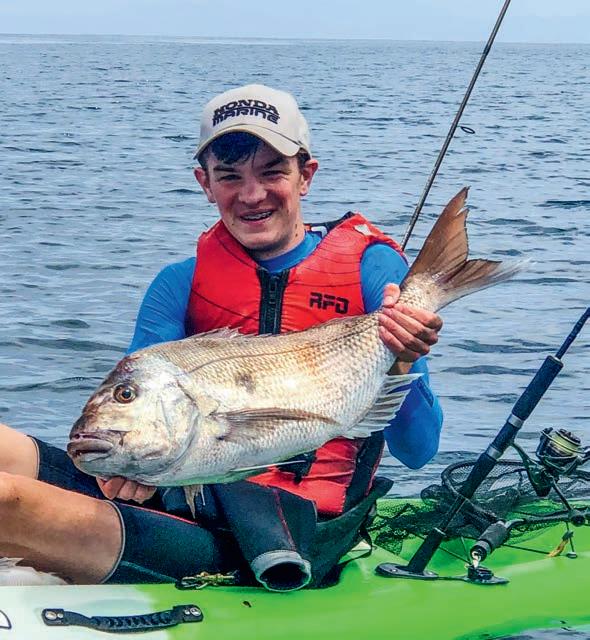
the braid to double the line. The doubled braid will then match the diameter of the leader better, making for a more balanced connection. This knot isn’t quite as strong or effective as an FG but may save some time when the fishing is hot! I will then tie my jig head onto the leader with a Uni knot.
Selecting your jig head weight in relation to the wind, drift speed, depth and lure size is important. A heavier jig head is ideally suited to deeper water, a faster drift, or a more ‘relaxed’ fishing style. A correctly weighted jig head can be used for a technique we call ‘dragging’. This is when you drop your soft-bait down into the strike zone and then work the lure with a series of twitches, without winding in between. As the boat drifts on, the lure will probably angle out behind the boat. Once this happens, let some line out to drop the lure back into the strike zone. When your line angle is too far away from the boat, wind in and start again. If ‘dragging’, you

will need to use a jig head that is heavy enough to comfortably sink into the strike zone, but not so heavy that it drags hard along the bottom (and become a snag hazard!).
A lighter jig head is ideally suited to when you’re fishing shallower water, fishing with a slow drift speed, or if you are actively fishing your lure. Actively fishing your lure means casting ahead (or to the side) of the boat’s drift and letting it sink into the target zone before giving it a series of twitches, a couple of winds and then a brief pause to allow the lure to sink again. After you have cast out, make sure you keep in touch with the lure as it sinks as quite often you’ll get picked up ‘on the drop’. To do this, hold the line in between your fingers and if you feel the line speed up or stop, flick the reel into gear and strike!
As indicated above, soft-baits are best suited to being fished off a drifting boat. This helps you cover more ground and, more importantly, it gives your lure more movement, making it look more natural.

When soft-baiting, you will need to identify where the fish are holding in the water column and try to keep your lure in that zone. In the Bay Of Plenty, we typically try to fish the bottom quarter of the water column as this is where our target fish will often be. Some days your drift is just too quick to fish the chosen area effectively. In this scenario, we will tow a sea anchor behind the boat. This is basically a big parachute that will fill with water and dramatically slow your drift speed down.
If I’m targeting a bigger fish over a reef, I like to use a 7-inch ‘jerkshad’ or a ‘paddle tail’ style soft-bait, with the 7-inch ZMan ‘Atomic Sunrise’ being my current favourite option. However, when over the beach where we are
less likely to come across bigger fish, I like to use a smaller 5-inch ‘jerkshad’ or a small curly/grub tail, which are also particularly effective on gurnard!
Soft-baiting can also be a very productive way of targeting kahawai. Anything small in black and white will be great for targeting these schooling fish. Casting around the edges of the school with a steady retrieve has been very effective for me.
Something to consider is not casting your soft-bait into the middle of the school – this will spook the fish, causing them to go down and disappear.
Having soft-bait gear onboard as a backup option, if not as your first choice, is definitely worth the effort!
Soft-baiting is very fun and effective off kayaks. The writer landed this 70cm snapper off his kayak out at Mayor Island over the summer.

Targeting marine structure when sea fishing is second nature to off-shore anglers. Reefs, rocks, islands, sunken mountains and floating objects are just some of the places where the prey and the predators hang out. Trout fishing can be no different Greg Morton reminds us…
Freshwater rivers, particularly big freshwater rivers, have structure, which is usually created through big floods. The recent Canterbury floods that hit the two branches of the Ashburton River are a case in point. Mid Canterbury was devastated. They nearly turned the Ashburton Bridge into a bit of destroyed debris.
Since moving back to Central Otago, I have found a lot of my river fishing time is spent on big rivers since they are handy and
I concentrate a lot of my fishing effort around post flood structures I encounter.
Top of my ‘mean size rivers’ pile is the Clutha River (MataAu), which is the highest volume river in New Zealand, and the swiftest, with a catchment of 21,960 square kilometres discharging a mean flow of 614 cubic metres per second. Second is the Pomahaka River which is in South Otago. A tributary of the Clutha River, it flows south for 80km from the Old Man Range of mountains to join the Clutha about
15km west of Balclutha and near Clydevale. Third is the Taieri River which is the fourth-longest river in New Zealand, being an impressive 288 kilometres in length.
When angry, all three tear the bankside landscape up and do some serious moving around of soil, property and trees. This seems to happen a lot more these days, and the experts are predicting that more regular big floods are just one symptom of an ailing climate.
The main trout species caught across the three rivers is brown trout, though I also catch rainbows in the Clutha and Pomahaka, and occasional perch in all of them.
The Clutha is always fast and always boisterous, so you are always seeking structure or a braid to give you an edge. The other factor is flow but that is out of your control as it is up and down like a yo-yo. The piece of structure I
In these three rivers, the main types of structure I target are sunken trees, river boulders, lee water behind islands, and open water amongst thick stands of bankside willows and weed banks.
Fair Chase“Hits can be explosive as the structure predator is in ambush mode and is wired to kill.”



remember most was a huge willow that sat in the main Clutha some ten metres out from the bank.
The river current hammered it but for five or so years it stayed firm, providing deep, slow water behind its bulk. I regularly caught trout here year after year, but sadly this year the top has gone and only a few remnant sticks poke up. I would flick a 13g Kobra behind the tree and slowly wind it back into the slow water where it got smashed. RIP tree.
The Pomahaka River is mostly sluggish, dark and brooding, but browns love it and will be found in willow pools and behind trees washed down in the floods. As it’s slower and shallower than the Clutha, I tend to use 7g spinners as my go to weapon here, though I have seen fly anglers do well also. The damage done by floods in this river is spectacular though I seldom hook up on snags when retrieving. I think the floods were so powerful they cleaned the riverbed of all items. The only trees left mid-stream are monsters who eventually will surrender. It’s only
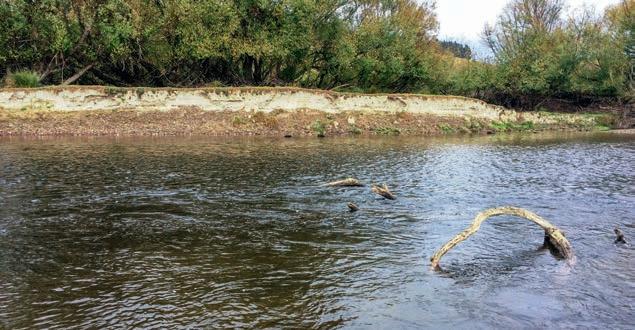
a matter of time.
Another structure this river has is a strange bedrock pattern in the lower reaches which channels water at speed but also creates holes that fish lie in. My brother did well with a weighted nymph in this region, while spinners got swept over the top.
The Taieri River at low flow is a lazy brown river meandering its way to the sea, but in flood it too flexes mighty muscles. The main structure I target here is also flood debris and mid-stream tree carcasses. At the tail end of last season I landed a big brown just where you would expect him to be. A tree stump reached out into the main river, creating slow water in its lee. I edged out over the water and cast the spinner downstream and slowly let it weave its magic. Right below my feet, a gold blur came out from the bank and hammered it. I actually got splashed by the surface impact. He tried to get back into his lair but with tension on full, I dragged him away from safety. I landed him soon after, then took a quick photo and let him go.
The soft-plastic range is great for fishing structure as often the lee water is deep. Perch in particular love them and will burst out from cover to swallow them up. Catch one and you are certain to catch more until the eel police turn up and move the school on.
The main danger of fishing around structure is the same one that marine anglers face: bust offs. Powerful fish will head for the rough stuff and tangle you up. Taieri trout are masters of it and ‘whack and run’ is their speciality. On light gear, there is very little you can do about it and even less when they burrow amongst the sticks. Snags are less of a problem as fast rivers are constantly moving the river obstacles along or burying them under silt.
I find casting behind structure then swinging my lure through the prime water during the retrieve works well for me. Hits can be explosive as the structure predator is in ambush mode and is wired to kill.
 Big trout caught behind the writer’s Clutha tree which was recently swept away. Right: Perch love soft-plastics and will burst out from cover to swallow them up.
The type of structure typically found in the Pomahaka. Right: Some fishy-looking structure in the Clutha.
Big trout caught behind the writer’s Clutha tree which was recently swept away. Right: Perch love soft-plastics and will burst out from cover to swallow them up.
The type of structure typically found in the Pomahaka. Right: Some fishy-looking structure in the Clutha.

Deputy Editor Ethan Neville headed to the Far North with Catch Fishing owner John Donald to check out the brand new Black Label Livies soft-baits, and perhaps catch a few fish along the way…
It was about 1pm on day one when I lost count of how many solid snapper we’d caught.
The high pitched sound of line tearing off the spool had been something of a backing track for the morning. Most of the fish landed were probably hovering around 50 centimetres long, with a few more jumping up over 60 – so just “Northland pannies”, as I was repeatedly told. With the bite now finally slowing, I took the chance to have some lunch and a breather, but even the rod in the holder wasn’t safe, and before long I was on my feet again, doing my best to bring in another Far North red.
It’d all started a few day’s previous when I got a call from Grant Dixon, my boss and the managing editor of this publication. With a hip operation imminent, he regretfully informed me that he was in no shape to drive to Houhora to fish with John Donald, owner of the NZ tackle company Catch Fishing, onboard Houhora Fishing Charters. This

outfit is, of course, run by none other than Rob Parker, who is most famous for his ability to find and catch 30lb snapper. The purpose of the trip, Grant continued, was to test Catch’s brand new Black Label Livies soft-baits, and it was agreed between him and John that there’d be no better place to do this than in the Far North.
“Do you have time next week to take my spot?” he finally asked.
“Ah, it’s been a busy week GD, and I’ve got a bit on, but I’ll see if I can move a couple things around if you really can’t go.”
Grant was extremely grateful for my generosity and agreed that he ‘owed me one’. I, of course, would have happily taken two days of annual leave, paid my own way and written this article free of charge.
And so I arrived in Houhora on Monday evening at a farm stay, where I found John rigging up the soft-bait gear. After I’d been given a good rundown of his new range of soft-baits and tied a few FG knots (I’ve never been more
careful), we set our alarms and tried our best to get some sleep. The forecast 10 knot westerlies and overcast skies greeted us at the ramp, as did the jovial Rob Parker, who lived up to his reputation as a “straight talker”. His just under 6m Stabicraft is a smaller than average charter boat, but it’s all he needs to get to the snapper grounds around Houhora. Grant Foster from Addiction Unleashed, another well-known and talented Far North angler, rounded out the crew for the day. Within minutes, we were out of the harbour and pulling up at spot number one. The rods came down from the rockets, and I was handed the Catch SP3000 spin reel paired with the Catch ProSeries two-piece spin rod. The SP3000 is not as high spec’d as it’s American-made counterpart, the Catch IRT 200 spin reel, but it certainly did the job over the next two days, comfortably dealing with its fair share of solid snapper. Rigging up the soft-baits came next. I was presented with a
The writer almost exclusively used the White Warrior rigged on an orange Catch Stingaz jig-head for both day’s fishing. It was too good to change!

“He had quietly pulled in what would have been a comfortably 50cm fish, and then I watched as he, without saying a word, released it back over the side.”


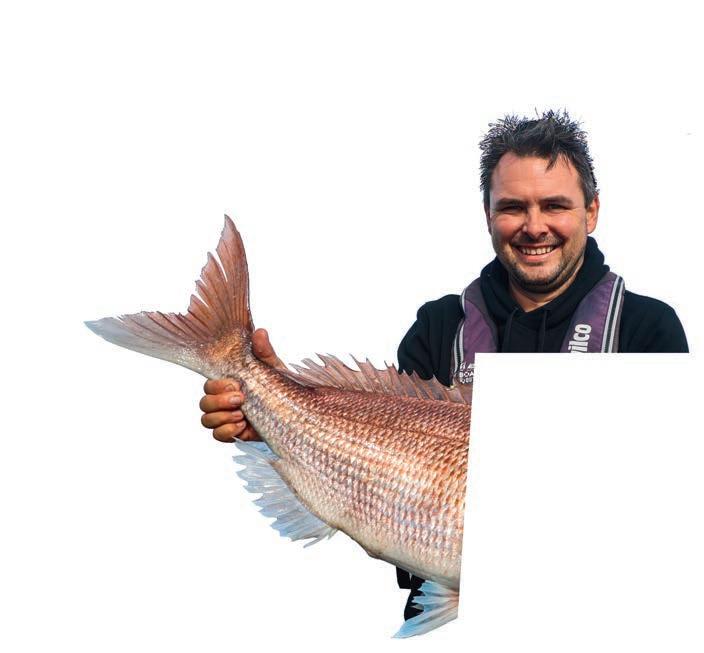
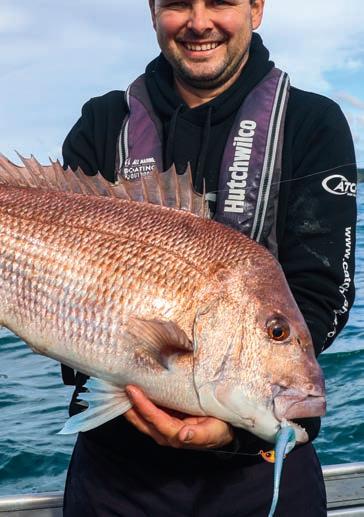
gloriously colourful box filled with seven-inch Catch Black Label Livies, and told to take my pick. Not having used these soft-baits before, I chose at random and pulled out the White Warrior – a slender jerkshad that immediately felt a bit different in my hand than other soft-baits I’d used. Manufactured from super tough TPR (thermoplastic rubber), it was firm, but definitely not stiff. The jighead I was passed also provided a point of difference. Based off a Japanese style called “tenya”, the Catch Stingaz jig-heads come with an assist hook that can be rigged through the bottom half of the soft-bait so it protrudes point up on the opposite side to the main hook. This was something
I’d always liked the sound of, but never actually tried.
And so we cast out our offerings beside a mussel farm, with my anticipation about as high as it’d ever been when soft-baiting. But after 20 or so casts without a fish, we were off up the coast and heading to the next spot Rob had in mind.
Now in slightly deeper water, I cast my White Warrior in front of the boat and this time it didn’t get close to dropping the full 20m before the bites started. Early trip jitters meant I missed the strike, but the same wasn’t true for Grant. He had quietly pulled in what would have been a comfortably 50cm fish, and then I watched as he, without saying a word, released it back over the side.
“Oh, you didn’t want to keep that for dinner?”
Both Rob and Grant told me not to worry, and Rob actually laughed – and that’s when the chat started.
“That’s not even a pannie in the Far North.”
I would’ve objected but the next couple of hours saw plenty of fish well over the 50cm mark come on board. Grant was the first to land one over the 10lb mark, and then I was up next, before Grant and John both pulled in a couple more nice fish. By lunch, we’d caught more 50cm+ snapper than I’d seen on one boat in a single day – the exception being perhaps one or two Hauraki Gulf days in the heat of spring workup season. What happened next, however, very rarely happens in the Hauraki Gulf, if at all.
Grant’s Black Label softie got picked up, and whatever was on the other end was not too bothered by the drag his reel was exerting. It ran, and ran, and ran, and then he got one wind back, and then it kept running. Rob called it for a snapper (he didn’t get one species wrong the whole trip), and we all knew this was the fish that anglers come to Houhora from all around NZ to catch. And then, for seemingly no good reason at all, the fish popped off. I won’t repeat Grant’s language.
We didn’t have time to wallow for long though, as John soon brought in another couple snapper
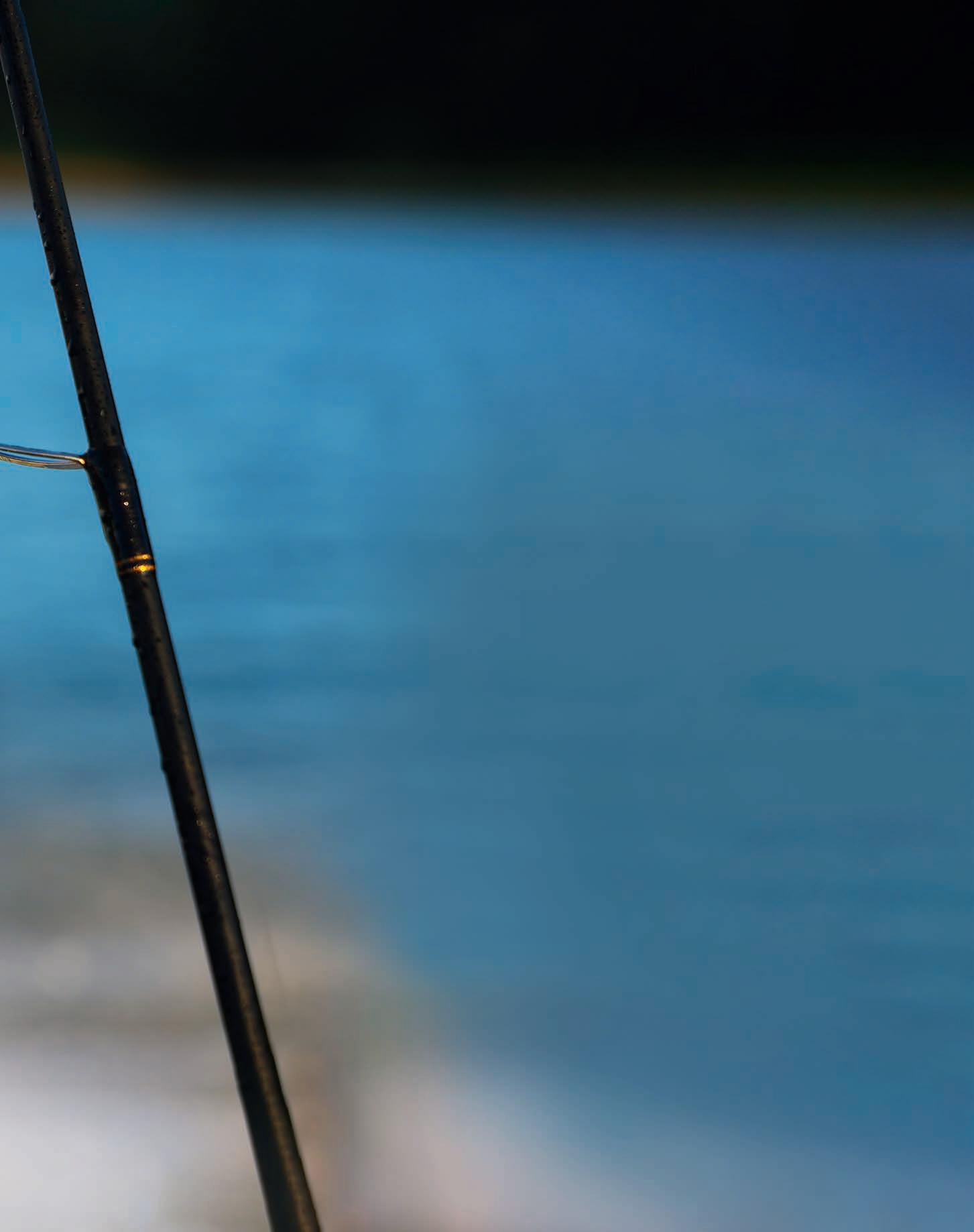


pushing the 75cm/15lb mark. The action just kept coming, and amazingly, our soft-baits stayed in fantastic nick. This was the first observation I made about the new Catch range. As I had guessed as soon I picked up my White Warrior that morning, they are extremely durable, even withstanding the jaws of multiple 10lb plus fish, as well as plenty more smaller ones. The only time I reached back into the box of soft-baits was after I was broken off on a reef.
The second observation I made was that about 80% of my fish were caught on the assist hook at the bottom of the soft-bait. Even one of my bigger fish pushing the 10lb mark was nicely hooked in the lip by the smaller hook. By the end of day one, I was thoroughly sold on this idea, and left wondering why the assist hook wasn’t already a well-established part of every jighead. Yes, most big fish smash the head of the lure – but fish aren’t always the most accurate feeders, and neither are they always going to swallow the whole lure. When the bite is tentative or the fish are smaller, as is often the case in my home grounds in the Hauraki, this assist hook could be the difference between an empty bin and a good feed.
I won’t bore you with the play by play of day two. I will admit it was slower, but we still managed multiple fish over 60cm, including an approx. 75cm model for John.
The fish of the trip was also landed, but not by John, Grant or me. Nova Walsh had driven up from her home in Cooper’s Beach the night before to join us for the day, and it was no surprise to anyone that she would be the one to take winning honours. Her rod was in the holder when her soft-bait was picked up and her reel started screaming. The angled hook of the Stingaz jigheads, I am told, keeps the lure working in the current even when not being worked – and this trip provided plenty of evidence for this. 10 minutes later, a 21lb/82cm snapper came aboard. It was Nova’s first 20lb snapper, and almost poetically, she was using the Orange Ochre. This colour is heavily indebted to Rob Parker’s ingenuity, and the story is worth sharing.
A long time ago, Rob wanted to make his own soft-baits, so he imported plastisol from USA. After combining it with some food colouring from his kitchen, he created a bright orange softbait. On trip after trip, he found the colour to be a winner, so he generously shared some of his original samples with Catch. On their first attempt to manufacture this colour, Catch decided to add a glow in the dark underside. An unintended consequence was the glow pigment lighting the orange topside, and their highly successful “Glowing Gurnard” colour was the result. On attempt
The man himself –Rob Parker – holding the writer’s first fish caught on the assist hook.
two, they matched the colour, added UV into the polymer, and Orange Ochre was born. To be fishing with Rob and John, and then see a 20lb snapper fall victim to an orange soft-bait, was a little surreal.
So, what was my overall impression of the Catch’s new Black Label Livies?
Overwhelmingly positive. To only burn through one soft-bait during a hot day’s fishing in Houhora is a bit ridiculous, so they get top marks for durability. Without any scent, they completely rely on their action to attract a bite. Judging by our two day’s fishing, I found no reason to detract any marks from the score card in this section either. When used with Stingaz jigheads, you have a deadly combination which I would recommend to anyone who uses soft-baits.
And yes, I’ve already a) booked in a week’s leave in August for another trip north, and b) dropped in to see John at the Catch office to collect the last of the Black Label Livies stock he had left. But don’t worry – a new shipment has arrived, so they should be back at your local retailer soon.
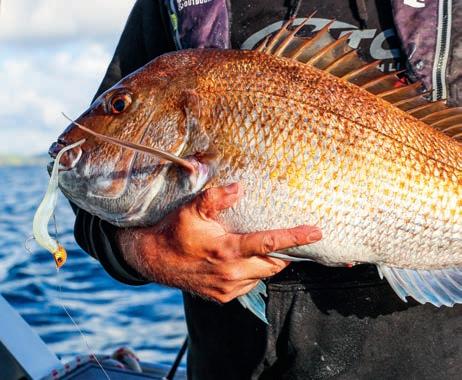


1) Yet another fish that fell to the White Warrior/ Orange Stingaz jig-head combo. 2) Plenty of fish were released by the team over the two days of fishing. 3) The American-made Catch IRT 200 spin reel comfortably dealt with a number of solid Far North fish.


On the trailer, Whiti Te Ra, the first born for Paihia-based Blue Diamond Marine, looks huge and bulky, but these notions are soon dispelled as soon as she hits the water. Managing Editor Grant Dixon headed to Paihia to give the new infant, a Blue Diamond Marine 680HT, the once over, and hopefully baptise its decks with a decent snapper or two.
The vessel is designed by Austin Kell, a Kiwi mechanical design engineer whose first job was to create the Maxwell Freedom electric capstan, a forerunner to the RC range popular today on trailerboats and smaller launches. He spent time in the oil and gas industry as well as working on superyachts. His interests have never been far from the sea.
It would be unfair to call Whiti Te Ra a prototype, as this is the real deal. Austin wanted to create a catamaran design that eliminated some of the negatives associated

with twin-hull vessels, especially the pounding into a head sea. The pounding issue was mitigated with increased tunnel clearance, ensuring a smooth ride in all sea states.
He also wanted to create a hull that could be configured in whatever way a customer chose – walk-around or hard top cabin. He ticked both these boxes.
On the test morning, the remnants of a big easterly blow was still pushing one-metre plus swells past Tapeka Point in the Bay of Islands, with a little wind against tide chop added for good measure. At test time, a damaged hip saw
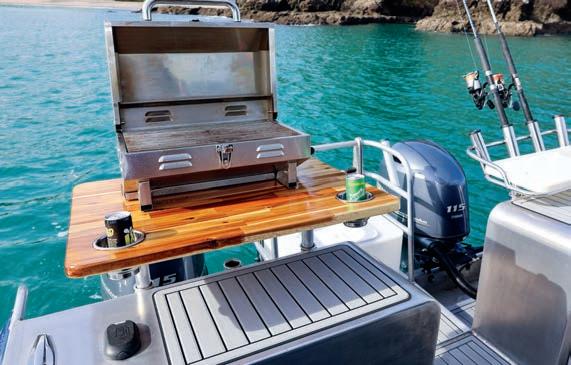
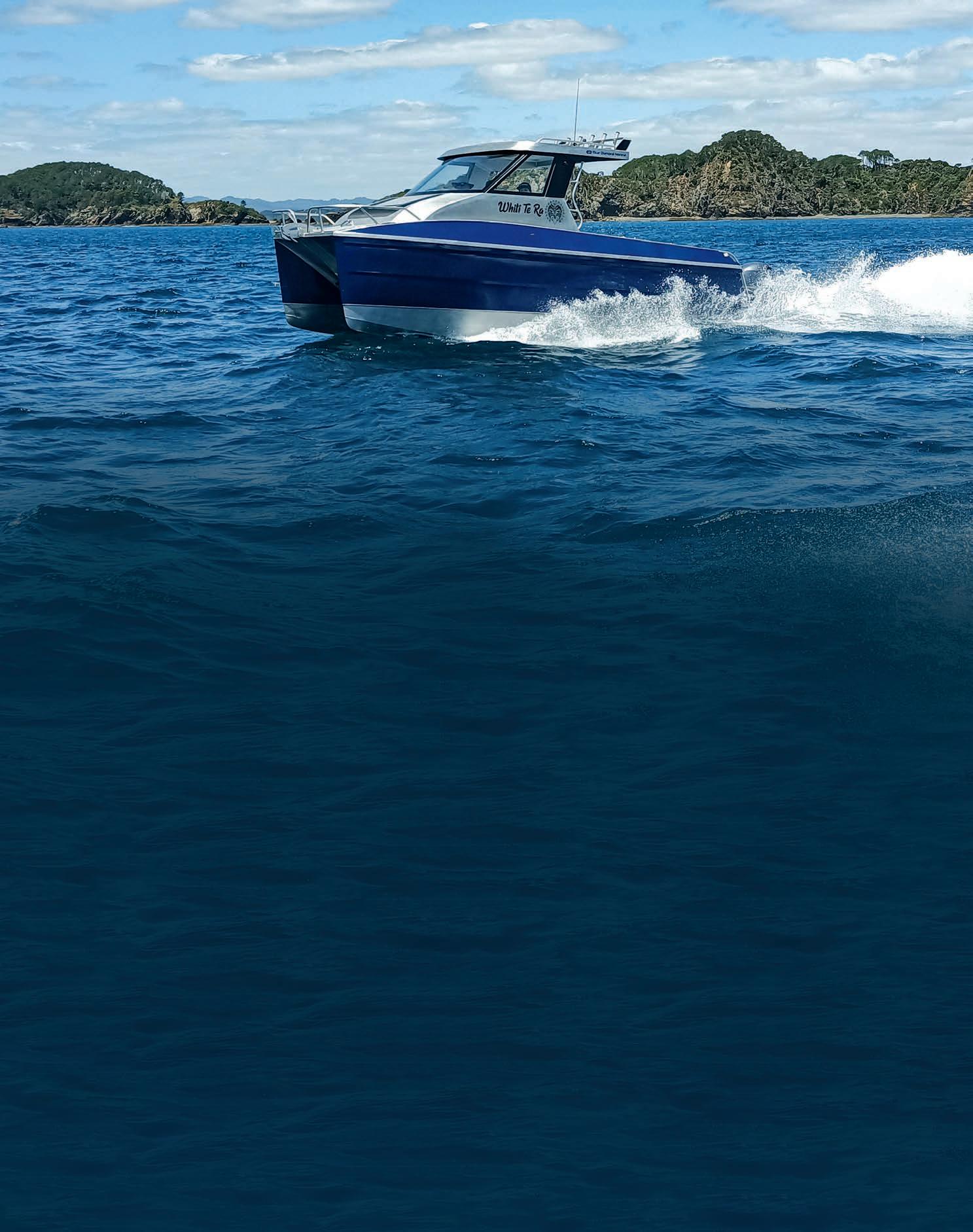


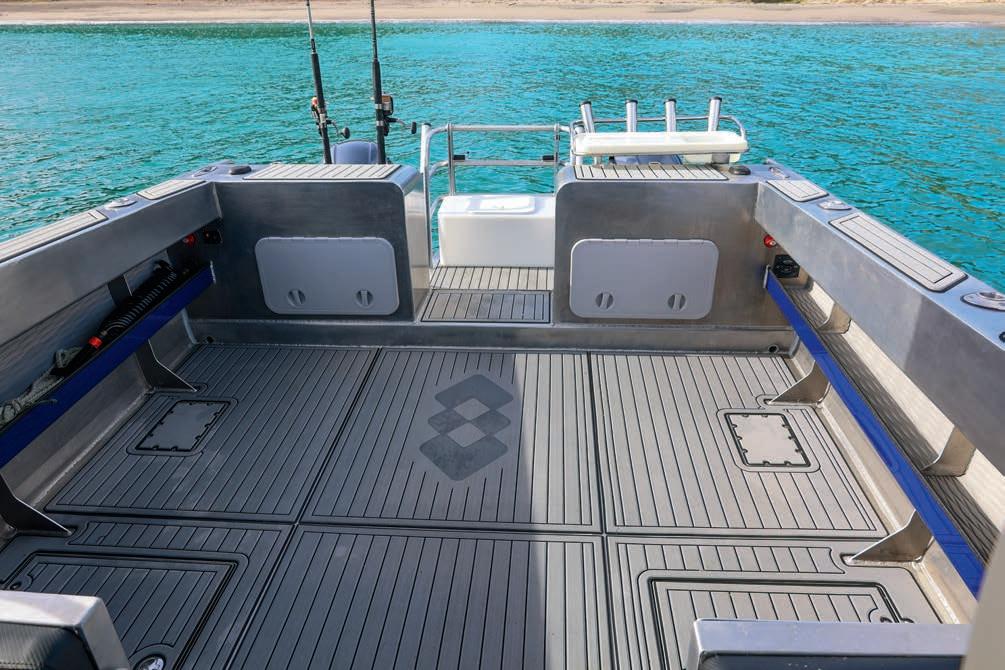
me stepping gingerly and I was not looking forward to time at sea. I need not have worried. The hull was very predictable and the ride well within my pain threshold! And there was no pounding, just a little hint of spray pushed back onto the screen as we took the swells head on.
Whiti Te Ra’s layout is simple but effective. The result is a huge working space to which optional extras are added.
There is no fixed bait board. It, along with a table, gas BBQ and the livebait tank, is removeable, tucked in one of the hulls when not in use.
“It just adds to our options – you can pick and mix at the time, so nothing gets in the way when it need not,” Austin says. “It might start the day as a fishing boat but is easily re-configured for cruising and relaxing.”
Everything on the boat is about practicality and the good use of space.
The rear facing dickey seats fold down when not in use thanks to another bit of Austin’s mechanical wizardry – an automatic latch that holds the seat in either the upright or closed position that needs minimal

effort to deploy.
Under the passenger’s seat is a standard sized 80 litre fridge and on the opposite side is space for a 70-litre Dometic ice bin, leaving the cockpit space uncluttered. The forward passenger and helming seats are Hi-Tech Plastics Elite bolstered models that offer plenty of support regardless of whether you are seated or standing.
There is a huge space at the helm station for instrumentation, the area swallowing up the 12” Raymarine screen, GME VHF, Maxwell capstan control, switches and engine
 The huge amount of cockpit space is a winner for divers and anglers alike. A solar panel provides additional power when cruising and the roof area is useful for storing surfboards and the like, not to mention diving off!
Anchoring is done using a maxwell RC6 electric capstan. This SeaDek’ed space is also an ideal place to fish topwater lures from.
The huge amount of cockpit space is a winner for divers and anglers alike. A solar panel provides additional power when cruising and the roof area is useful for storing surfboards and the like, not to mention diving off!
Anchoring is done using a maxwell RC6 electric capstan. This SeaDek’ed space is also an ideal place to fish topwater lures from.


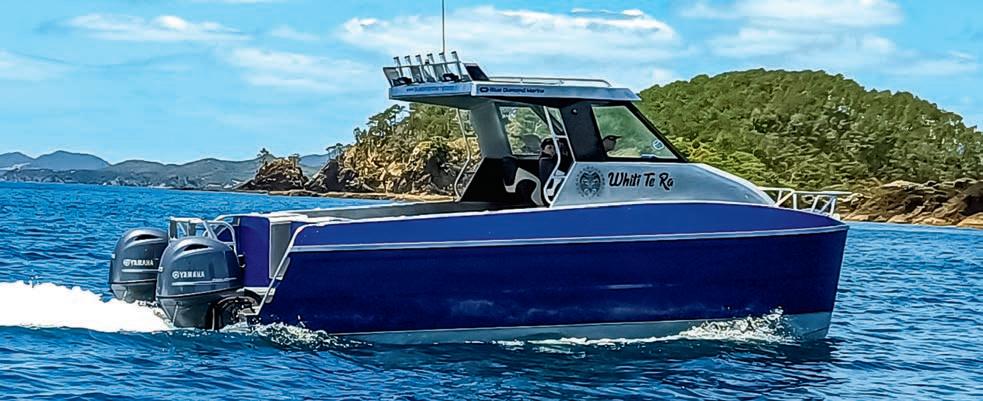
1) An 80-litre fridge, perfect for keeping our lunch cool. 2) Austin demonstrates the ladder access from the trailer to the boat. 3) With minimal area in contact with the water, the Blue Diamond 680HT does not need a great deal of horsepower, in this case two Yamaha 115 Four Strokes. 4) The boat in fishing mode with the removeable livebait tank and bait board in place. 5) With the infill in place there is room to sleep two comfortably across the hulls. 6) These handholds double as access to the roof. 7) The drink holders are tucked away besides the seats, keeping drinks out of the direct sunlight.
management gauges.
Visibility is great. A singlepiece curved glass screen offers an unrestricted view forward. The small side windows are fixed.
Up forward there is space for a chemical toilet with seating either side. An infill squab creates a traverse double berth.
All upholstery was done in Opua by Peter Boyd and his crew at South Pacific Marine Canvas.
The boat utilises SeaDek marine decking liberally, adding to the vessel’s comfort and good grip underfoot. The cabin top, used to transport kayaks and
water toys – and as a diving platform for the kids – has had SeaDek laid either side of the centrally mounted solar panels.
Whiti Te Ra is a mean fishing/diving machine for several reasons. It has nice high coamings, cockpit space to burn, storage for Africa, an excellent swim platform and ladder between the two motors and more rod holders – both around the boat and in the rocket launcher – than you could possibly shake a stick at.
Storage in the hulls, as already mentioned, is cavernous. There’s space for extra fish
bins, numerous sets of dive gear including bottles, fishing tackle, spare ground tackle, ice bins, barbecues – the list goes on – and it is all relatively easily accessed through the two deck hatches.
Things like tag poles, flying gaff handles, boat hooks and the like easily fit in the port and starboard cockpit-long shelves.
And there are plenty of little things worth mentioning. All the cleats are pop-up, and the handrails are well-placed to provide just the right point of contact for the passengers. The rails at the rear sides of the



hardtop double as ladders for those wanting to venture onto the roof.
The vessel, despite its bulk, does not take a great deal of horsepower, and thus fuel, to drive. Whiti Te Ra is powered by twin Yamaha 115HP four stroke outboards, fed by 165 litre-a-side tanks. Coming back from our fishing grounds with the swell behind us, the boat was travelling at a comfortable 22 knots, burning just under 30 litres all up. The engines provided plenty of torque as we neither sped up or slowed down with the swell, maintaining a steady lope through the conditions.
The custom-built trailer is another testament to Austin’s design and engineering skills. It features a set of rollers set up bunk style to go under either hull and a raised section in the middle, which acts as a guide when the boat is launched and retrieved. Austin drove it onto the trailer, the boat latch he


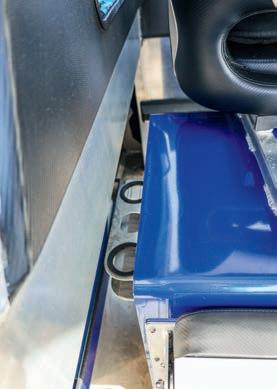
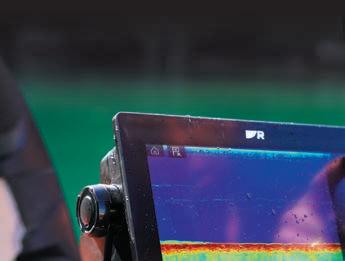





designed himself catching it firmly at the snubbing block. While wife Peta was on hand to drive the boat out, the trailer incorporates a ladder at the front so you can get on and off the boat without getting your feet wet, making launching/retrieving a one-person operation. The boat was built under contract by a Whangarei fabricator, with the vessel fitout and trailer build carried out by Austin with assistance from his mates at NZ Yacht Services.
Austin is also co-owner of Blue Diamond Marine Pty Ltd based in Chinderah, NSW where they have designed and built a 10.5m walkaround version built to AMSA 2C survey, and are currently working on a 12.95m version. Their boat building facility is on the banks
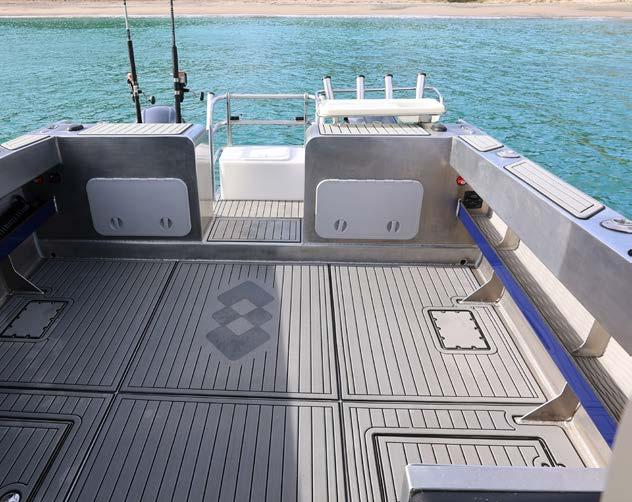
of the Tweed River and has the workshop space to build vessels up to 20m in length.
As mentioned earlier, the vessel is a great fishing platform – stable and spacious. I introduced the Kells to the art of not-so-subtle soft-baiting, utilising their Baitrunner 6500 sets, a one-ounce jighead, Bruised Banana tails and some dubious 30lb trace! While it may have been a little agricultural, it did prove effective with Peta catching her first fish off the boat, and a PB to boot!
And as to the meaning of Whiti Te Ra? It means ‘the sun shines’ in Maori – quite appropriate when you see how the sun reflects off her wrapped azure blue sides!
Easily Cut To Fit
Great Wet / Dry Traction
UV Protected Non Absorbent
Comfortable, Durable, PE/EVA Foam
Covers Surface Imperfections
3M Peel & Stick Application
Customisable
0064 6308 9337
admin@batavian.co.nz
WWW.BATAVIAN.CO.NZ
www.seadek.com
Peta with the best catch of the day. With its impressive metallic blue wrap, Whiti Te Ra looks imposing on her trailer, but is easily towed by this Holden SUV.Fishing in the darker hours can produce some great opportunities, but they’re no good if you can’t see what you’re doing.
Enter the Guardian Angel Elite – a personal light that sits secured atop your shoulder with magnets, as opposed to on your head or in your hand.
Originally made for emergency and security personnel, the Guardian Angel Elite is dual purpose – on one hand, like any other outdoors light, it helps you see what you’re doing; on the other, it’s unique layout of LEDs, both white and coloured, can flash in a range of sequences and help the ailing angler be seen in emergency situations.
The lights come with a variety of colour options, starting
illumination/safety light to more specific options such as green/ white, green/yellow and white, as well as a green/red and white option which can be used for boating.
The LEDs are arranged into two rows – forward and backward facing, with the option to switch on either side or both at a time, and at varying levels of brightness to suit your situation. An Emergency Mode button on the top turns all LEDs on, flashing at random in a bright and attention-grabbing manner. From a safety standpoint, I know of few other lights that will help you be seen as well as the Guardian Angel. From a practical point of view,
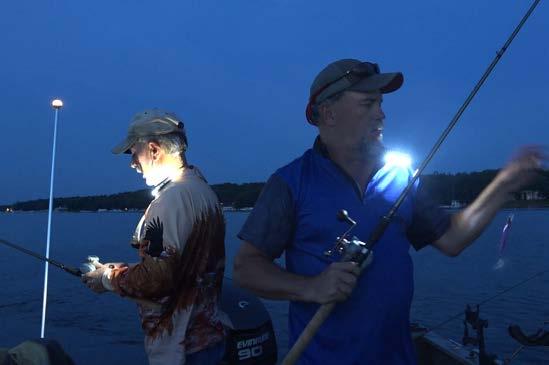



and feel less cumbersome than some head torches, to the point where I found myself forgetting that I was wearing it – the sign of any good wearable product! On one particular night, while squid fishing from a local wharf, the Guardian Angel provided a broad, sweeping light that illuminated the general area, as opposed to a focused spotlight, which can spook wary squid if moved around.
The lights are built tough, with an IP68 waterproof rating, and an extreme battery that will operate in NZ’s coldest or hottest conditions. Accessories include a range of rail mounts, clips, tethers and arm straps, although the built-in magnetic mount makes it easy to put it in a variety of places from the box, including a boat’s cockpit.
– Miah Dixon

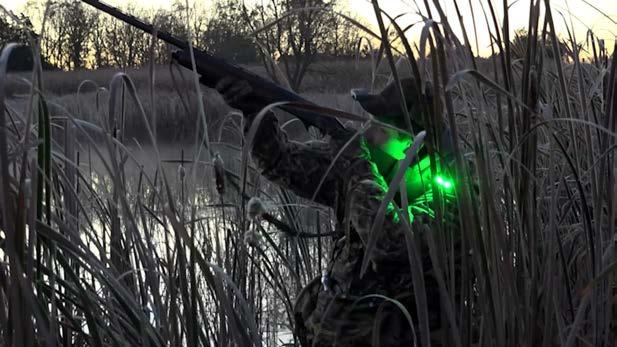





Harbourage Jacket 2.0 is Just Another Fisherman’s second-generation wet weather jacket for its Angler Tech winter collection, taking all the great features of the Harbourage Jacket and blending these with new tech and features to create what it thinks is the perfect wet weather jacket. It features a new and improved magnetic storm flap to protect zips and closures from the harsh saltwater environment, plus three waterproof outer pockets and quick access warming pockets which are fleece lined. Other features include fleece lining in the hood and grip cuffs on the sleeve to stop water running into your jacket. This is all rounded off with a DWR outer which repeals water.
Check these out online at www. justanotherfisherman.co.nz or in-store at your closest JAF retailer.

CZone Touch 10 Generation 2 is the gateway to your CZone Digital Switching.
The state-of-the-art CZone Touch 10 Generation 2 is a sleek attractive touch screen with glass dash styling that will complement the interior of any high-end vessel or recreational vehicle. The unit has a powerful dual-core processer and easy to use, intuitive CZone 2.0 User Interface with customizable favourites pages, simple controls and easy to follow menu structure. The high bright IPS LCD touch screen panel offers the very latest generation capacitive touchscreen technology to ensure maximum responsiveness. The screen is viewable from any angle, and features dimming capability for optimal night-time viewing. All of this is packaged into a splash-proof mounting system, making it suitable for any marine application. For more information go to www. bla.com.au

Raymarine Axiom, Axiom+, Axiom Pro and Axiom XL owners are now able to display information from Mercury Marine’s VesselView directly onto their MFD screens.
Using Mercury’s new SmartCraft Connect gateway via NMEA 2000, Axiom users can access vital performance data and alerts for up to four SmartCraft-compatible Mercury engines and display these on every MFD in their network. Information able to be displayed using VesselView includes the engine’s status and which gear has been engaged, engine rpm, boat speed, boat trim, trim tab positions, fuel tank levels and battery charge. Operators can also choose between daytime displays (white graphics on a black background) and Night Mode (white graphics on a black background). VesselView can be accessed by Axiom owners in several ways: through a new VesselView app on their LightHouse 3 home screen; in their chartplotter, sonar and radar apps; or through a slide-out sidebar display.

Product and dealer information is available from Lusty and Blundell on (09) 415-8303 or at www.lusty-blundell.co.nz.

The Toadfish Non-Tipping Can Cooler is the first of its kind un-spillable beverage cooler. Its innovative SmartGrip technology allows the can cooler to stick to any smooth surface. From a lack of cup holders on a rocking boat to wagging dog tails, this product will keep your drink upright, accident-free and icy cold. To use, simply place the can cooler on any smooth surface and it will keep your drink in place and securely up-right. The coolers are manufactured from high-grade stainless steel, making them puncture and rustresistant.
Distributed by Composite Developments Ltd, Auckland and available in selected stores nationwide.


If you’re a free diver into ‘underwater fashion accessories’, the new Wettie speara Elite Composite blades, now available in new Blue Tuna and Pink Mermaid Speara designs, will be a welcome addition to your gear bag.
A collaboration with one of the world’s top high performance blade manufacturers DiveR in Australia, the Speara blades are available in a medium stiffness with or without foot pockets.
For more information, check them out at www. wettie.co.nz or at your local Wettie stockist.
Get yourself ready for those southern bluefin tuna trips coming up! These deck boots will keep your feet warm and firmly planted on the deck thanks to their gum-coloured nonmarking soles. They are purpose built with foot protection for comfort and safety, and are also waterproof and reinforced with a UV resistant rubber outer. Maximise your fishing experience, whether that’s in the depths of winter or the height of summer.
Available from Stoney Creek stockists nationwide.


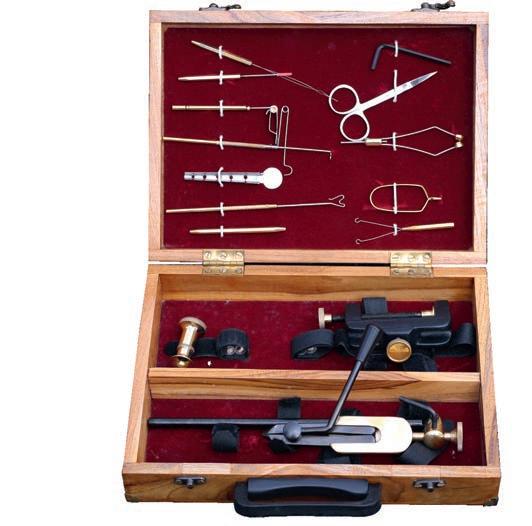
The perfect set for the beginner, the Surfmaster Deluxe FlyTying Kit is an ideal gift for that freshwater angler in your life. This is a nicely finished fly-tying kit in a smart wooden carry case with all of the tools you need to get started. It includes a Crown Vice (fixed head) with metal plate base; Dubbing Twister x 2; Bobin Threader, Bobin; Hackle Guard; Scissors; Rotary Hackle Pliers; Hackle Pliers; Whip Finisher; Bodkin; Half Hitch Tool; and Hair Stacker. There is a smaller set available that features many of the tools, but not the vice.
Distributed by Conaghans Ltd, North Shore, Auckland and available in selected freshwater tackle retailers nationwide.
The Adrenalin Inline rods are Balzer’s most elite product and are the best German engineered fishing rods available on the market.
Constructed from 40ton carbon fibre and wrapped in carbon tape, this range is ultra-robust and about 20% stronger than comparable rods. The 71° North Inliners are super light and compact. Also made from 40ton high-modulus carbon fibre, this range is now distinctively lighter and slimmer than its preceding models. The 71° North range are available in both two and threepiece travel versions, as well as in different rating classes for a variety of fish species. At only 70cm long, they’re perfect for travel and any tight urban storage. If you’re wondering how to thread the line, all rods come with a thread lining aid and either a padded bag or neoprene sleeve.
For more information, go to www. balzer.nz, phone 027 6999 8889, or email daniel@balzer.nz

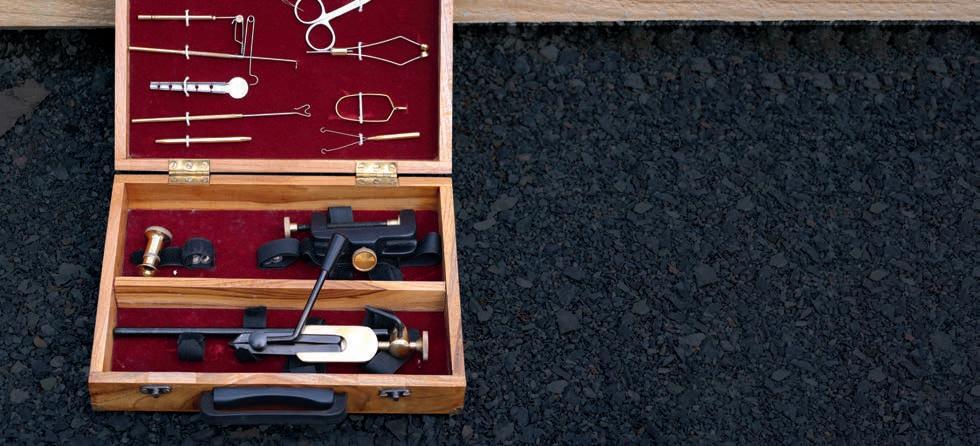
Anything worse than a warm drink on a hot summer’s day? Here’s the answer to making sure this doesn’t happen. The Shimano Bottle cooler with zip is designed to perfectly fit 330ml sized bottles to keep them icy cold while you’re drinking them. Made from 5mm neoprene with stitched seams and a reinforced zip, these coolers are designed to take the knocks out in the boat or at home when sitting around the BBQ!
Available at all leading tackle stores now.
Built from 100% super soft merino, the Anglers Underlays are the perfect companion piece. The base layers are designed to keep you warm and cool when needed.
Because Merino breaths, the garments offer excellent antiodour and moisture-wicking benefits – great for when you are fighting fish or hiking into your favourite landbased spot.
Check our Merino Anglers Underlays online, instore or at your closest J.A.F. stockist.

Jabsco’s new Hot Shot range of heavy duty (HD) washdown pumps includes the new builtfrom-the-ground-up HD4.
Replacing the old 3.5 & 4 GPH quad pumps, the powerful new HD4 comes with a higher-pressure rating, a motor with double the life expectancy and a completely new cast alloy rear pump head. The stronger new head, combined with better bolt spacing, eliminates flexing, allowing the pump to work at up to 60psi, or 20% higher pressure than previous models. Even flow rate spacing between models makes choosing the correct pump even easier and the new base plates are completely interchangeable with earlier Jabsco and Flojet models, making it easy to upgrade. The pumps are available with an in-line strainer, trigger nozzle and adaptors or as a complete kit, including all accessories and a 7.62m hose coil.
Product and dealer information is available from Lusty and Blundell on

The ITX Carbon spinning reels are lightweight, compact bodied reels constructed of rigid C-40X long strand carbon fibre.
This C-40X process is 25% stronger than standard graphite reels and is featured in the body, side plates and rotor of the ITX, making it perfect for both your freshwater and saltwater needs. The ITX features a multi-disc, carbon fibre drag system with Okuma’s Hydro Block Gasket keeping water out and your drag running smooth. The 7HPG +1RB High Performance, grease packed bearings keep the reel running smoothly. They are available in a 3000 and 4000 size for eight and 10-kilo line respectively, and feature a 6.0:1 high speed gear ratio. Distributed by Composite Developments, Auckland and available at tackle stores

Australian lure maker Halco have added a fluoro InvisiGlo to its range of Laserpro 190 Deep Diver lure liveries along with two other colour options. Great White, a pilchard like colour, and Blue Fluoro, a koheru imitation, are the two other colours available in the deep diving 190 series. The Yellowfin colour has had a refresh and looks very similar to our jack mackerel. The Laser Pros are one of the most popular Halco lures among Kiwi anglers and will run down to two-metres plus when trolled or retrieved at between five and nine knots. The 190’s offer anglers a choice of bibs which are quickly interchangeable depending on what depth you want to fish at.
Halco lures are distributed by Conaghans Ltd, North Shore and available in tackle stores nationwide.
Stay dry and fish in comfort with the new fishing boots from Edge this winter.
The warm, comfortable neoprene inner is encased by a waterproof rubber shell. The boots have a grey non-marking rubber sole which provides grip on a range of surfaces and the heel and toe are reinforced. The rubber and neoprene are easy to clean, quick drying and provide superior comfort while you’re out fishing. They are a tall design for maximum wading depth when launching the boat and are available in sizes 40-48.
Available from Burnsco stores nationwide and online at www.burnsco. co.nz; 0800 10 20 40

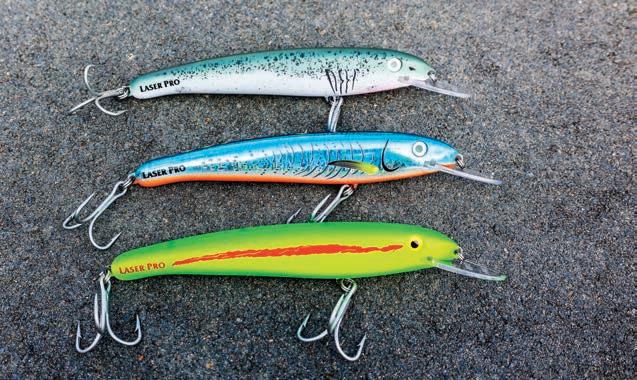


The latest Simrad® software update was released this month for its Multi-Functional Displays (MFDs), and it’s packed with the latest technology and visual enhancements.
The updates include a series of radar interface improvements and features focused on safety, like Dangerous Target Alert and enhanced integration with partners. The new radar improvements make it easier to view, track and monitor vessels, and identify vessels that may be a risk to the user’s course. New icons for the Automatic Identification System (AIS) and symbols for radar tracked targets allow greater clarity of risks and can be combined into one unified view on your screen. One of the key safety updates is the new Dangerous Target Alert that warns the operator of dangerous radar and AIS targets according to the target parameters in “Settings” and “Tracked Targets”. New icons for radar tracked targets and symbols for AIS targets also make for clearer viewing, while the radar display’s new-look includes a more modern Plan Position Indicator (PPI) with clearer numbers and a scaled boat icon (with setup) for the user’s vessel. For more information, go to www.simrad-yachting.com or check them out at your nearest Simrad dealer.

Varivas Ocean Record Shock Leader has the extra strength needed for taking on your record-breaking targets. Developed in conjunction with Seiichiro Tashiro, Japan’s leading Hiramasa Yellowtail Kingfish offshore casting angler, the Varivas Ocean Record is excellent shock leader for casting or jigging for any type of fish. It comes in 50 metre spools of 90, 120, 150, 180 and 200lb breaking strain. Available at YeeHaa Fishing Tackle, Panmure, Auckland. www.yeehaa.co.nz


The all-new Marine Engine Flush by Salt-Attack is New Zealand made and uses the finest ingredients, including the latest surfactants which quickly eliminate surface tension allowing for salt to be quickly and safely removed from all marine engine cooling systems.
In addition, the advanced corrosion inhibitor provides ongoing protection from rust and corrosion and food grade glycol antifreeze helps reduce damage to engine components due to freezing conditions. Salt-Attack’s super concentrated, environmentally friendly and biodegradable formula has been designed to be mixed through the proven Salt-Attack mixer or made up at a rate of 2ml saltattack to 1L of fresh water or one part salt-attack to 500 parts fresh water. Once the motor has been brought up to temperature (if hot flushing), flush salt attack through the engine for 30 seconds to one minute. Then shut the motor off, leaving the Salt Attack formula inside the cooling system, allowing it to break down any accumulated salt.
Salt-Attack Marine Engine Flush is exclusively distributed by Wholesale Marine Direct. Freephone 0800 272 589 or head to www.salt-attack.com
This New Zealand product has been in development for many years and incorporates a man-made gelatine-like substance impregnated with fish pheromones which is attached to a biodegradable cloth-like product to create a ‘bait mat’.
This ‘mat’ is then cut into whatever size or shape bait the angler wants. Freezing is not required, but Ecobaits are best kept refrigerated in a sealed bag. The philosophy behind Ecobaits is that it is a man-made product that does not use fish in any shape
or form in its manufacture, thus conserving stocks. Ecobaits, unlike many natural baits, will stay on the hook despite the attention of ‘pickers’ and it is a proven fish catcher. A complementary mini-berley product is also in development.
Manufactured and distributed by Ecobaits Ltd, Campbells Bay, Auckland. Ph 021 102 8646 or email info@ecobaits.co.nz or visit www.ecobaits.co.nz
Trade inquiries welcome.




Brunswick Corporation has announced that it has entered into a definitive agreement to acquire Navico, a global leader in marine electronics and sensors, for $1.05 billion. As a result of this acquisition, Brunswick will add the industry leading brands of Lowrance, Simrad, B&G and C-MAP to its Advanced Systems Group (ASG), which includes the leading Parts & Accessories (P&A) brands in power management, digital control and monitoring, and networked devices.
“The acquisition of Navico and its award-winning brands will immediately accelerate Brunswick’s ACES (Autonomy, Connectivity, Electrification and SharedAccess) strategy, and support our vision to deliver distinctive new products and technology-enabled experiences,” said Dave Foulkes, Brunswick Corporation CEO.
“We will continue to invest both in organic initiatives and acquisitions to maintain our position of global product leadership, and the addition of Lowrance, Simrad, B&G and C-MAP to our existing brand portfolio will further strengthen our ability to provide complete, innovative digital solutions to consumers and comprehensive, integrated systems offerings to our OEM customers.”
Navico is a privately held global company based in Egersund, Norway and co-owned by Altor Fund IV and Goldman Sachs Asset Management. It is a leading provider of multifunction displays, fish finders, autopilots, sonar, radar and cartography. Navico’s strong brands serve most major powerboat and sailing markets for both recreational and commercial applications.
The electronics company’s significant aftermarket orientation and attractive margin profile further add to Brunswick’s cycle resistant business profile.
The closing of the transaction is anticipated during the second half of 2021 and is subject to usual and customary closing conditions, as well as regulatory review and approval.
– Navico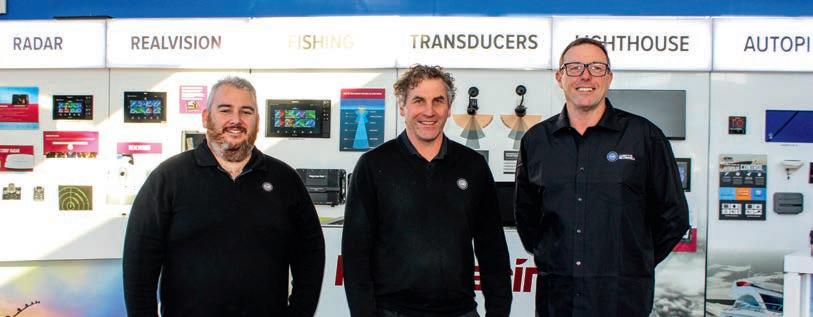
The helming duties at Lusty and Blundell Ltd are now in the capable hands of current CEO Mark Milburn, qualified boat builder and experienced businessman Cameron Maher, and current OEM sales manager Morgan Brodie. Founded in 1974 by marine industry stalwart Ken Lusty, Lusty and Blundell is New Zealand’s largest distributor of leading-brand marine industry products and systems.
Mark Milburn, who becomes managing director, has been with L&B for more than 20 years, over 12 of those as CEO. Mark has a strong focus on both customer service and has successfully steered the company through both the Global Financial Crisis and the Covid-19 pandemic. Highly respected in the industry, he has a strong background in the design and installation of sophisticated navigation and communication systems for superyachts, race yachts and race management teams, is a former New Zealand Laser Youth Champion and Olympic campaigner and holds an economics degree.
Cameron Maher joins the company as sales director. With over 20 years experience as a qualified boatbuilder, following an apprenticeship at the renowned Kennedy Marine yard, Cameron grew up fishing and diving the Hauraki Gulf before heading off to enjoy racing and cruising the world’s oceans. He also has 15 years of sales and marketing business ownership experience in Australia, so he is excited to be able to join two career paths about which he is very passionate.
Morgan Brodie has worked in senior sales roles for 16 years, helped establish and run L&B’s Tauranga branch and been an account manager for the lower North Island and parts of the South Island. With a strong focus on delivering a high level of growth, Morgan will continue as the company’s OEM sales manager.
Mark Milburn says the new ownership structure will benefit from its enhanced leadership team and continue operating with a growth mindset framework.
Extreme Boat’s ‘big boat’ division, Legacy Marine, is well into the fit-out stage of its L70 model, which is being built on site at Whakatane.
The L70 is a 24.0-metrelong range gamefisher built specifically to fish international waters.
She is powered by twin Mann 412 1900 diesels which will give her a projected ‘sprint’ speed of 34 knots
– not bad for a vessel that weighs 50 tonnes ‘dry’.
Fuel capacity is 9000 litres, and she carries 1000 litres of freshwater, backed up by a water maker.
Accommodation is in four cabins capable of sleeping eight people. The engines and shafts are in place, as are the topsides. The forward accommodation, manufactured in Auckland in modules, is currently being
installed. She will have all the comforts of home, including extensive refrigeration and a full laundry – everything to make long-distance travel as pleasant as possible.
The L70 is the first of the Legacy Marine vessels in build. There are plans for a L52 and a L45, renderings of which were released to the public at the May Hutchwilco NZ Boat Show.
– Grant Dixon New L&B owners (from left) Morgan Brodie, Mark Milburn and Cameron Maher.
Look out for Lusty and Blundell’s road show at a branch near you, where all their latest technology will be on display.
Lusty & Blundell, New Zealand’s largest distributor of world-leading marine products and systems, is about to undertake a comprehensive winter road show, highlighting the latest advances and innovations in marine technologies.
The tour, which will initially target technical dealers and marine electricians over the next couple of months, will showcase ground-breaking products such as the award-winning CTEK CS Free portable battery charger,
Vesper Marine’s innovative Cortex VHF/monitoring/control system, lithium batteries, electric outboards and trolling motors, and the latest range of Raymarine marine electronics. The road show will also feature new marine camera technology from FLIR and the latest updates to Raymarine’s innovative LightHouse operating system.
The road show will initially be held in Lusty & Blundell’s branches at Albany, Whangarei and Tauranga (times to be advised).

CS FREE is the world’s first truly portable battery charger and maintainer
Adaptive Boost technology works quickly and safely to get you moving within 15min - no damage to battery or electronics
Portable o -grid charging using solar
Continuous mains power12V 5A smart battery charger
Power bank with internal battery that lasts up to a year
PORTABLE CHARGING. ANYWHERE. ANY TIME.


















 The Legacy L72 Gamefisher is well on its way to completion.
The Legacy L72 Gamefisher is well on its way to completion.

Like rubber bands, zip ties are extraordinarily versatile and can be used in many ways not intended by the manufacturer.


People are always innovating in the world of fishing and complex problems can often be solved with simple solutions suggests Adam Clancey.
These adaptions are now often known as “hacks”. One piece of equipment that I always carry with me whenever I go fishing is the humble cable tie, or zip tie as it is often called. Mainly used for organising and keeping cables tidy, these little items have a 1001 other uses – not unlike
rubber bands.
The following are 12 top great zip tie hacks. But first, it is important to note that although zip ties are a cheap item to purchase, they are not all equal. Some are only suitable for inside use as they are not made using UV stabilised materials, so will break down rapidly when exposed to the elements. It

should say on the packaging if they are suited for outside use. Also remember that this is another piece of plastic so use them wisely as we don’t want any more garbage in our precious oceans.
Make a hook keeper for rods by zip tying a solid ring to the butt

There are any number of lure mods and tricks that use a zip tie, including securing two single hooks in the optimum belly position on poppers.

of your rod. The reason for doing this is to give you somewhere to keep lures and hooks when the rods are in transit in a rod holder or rocket launcher. It’s not uncommon to see anglers hooking on to the bottom guide of the rod. Not only can this damage the eye, but sinkers or heavy lures will bash against the blank which can cause enough damage to break a rod. Graphite rods are particularly vulnerable to fibre bruising.
When using large sinkers such as the teardrop ‘puka ‘bombs’ for deep water fishing, the hole can be too thick to put a swivel clip through. Combining a zip tie with a swivel gives you a simple way to rig up and take sinkers on and off.
It is quite common when using stickbaits and poppers to run dual single hooks attached to
A zip tie can be used to secure the light cable to the trailer’s safety chain to prevent it scraping on the ground.


Zip ties make a simple chain marker, indicating the proximity of the anchor to the fairlead or bow sprit.
the belly. This can give the lure a better action, avoiding the use of trebles but still getting a reliable hook-up. Zip tying the two single hooks together maintains the balance of the lure and positions the points for optimum penetration.
When towing your boat, the trailer light cable can become damaged if it drags on the ground or gets in a position where it can be strained or pinched when turning. Securing the cable to the safety chain will go a long way to preventing this from happening.
If you have a capstan or any mechanical winch on your boat, add a brightly coloured zip tie to your chain half a metre or so above where the anchor is connected. This acts as an indicator as to the proximity of
the anchor, giving you time to slow down the retrieve to reduce the risk of damaging the hull or bow sprit with flailing ground tackle. Different coloured ties can be secured to the warp at measured intervals (e.g. every 10 metres), which indicate how much rode has been deployed if you don’t have a counter on the dash.
Zip ties can also be used as a breakaway on your anchor, where the chain is fixed to the head of the ground tackle and the shank of the anchor secured with a zip tie or two. When the anchor gets stuck in rocks, the zip ties break away and the anchor is then pulled out by its front end.
Zip ties can be very useful with lure rigging. I have used them for everything from fixing a skirt on a favourite trolling lure to attaching a soft-bait to the jig head. When gamefishing and using double hook rigs in a lure, zip

This lure skirt, damaged in action, is held back in place with a zip tie.

ties can be used instead of heat shrink tube to stiffen up the rig.
Landing nets, especially those with a fish-friendly plastic mesh, are prone to breaking where they are attached to the net’s frame. A finer zip tie is a good way of making a permanent repair. Any holes in the mesh can be repaired the same way.
It pays to keep your boat keys on a float just in case they fall in the water. Many keys come with metal split rings which don’t last in a harsh saltwater environment and will rust quickly. Put your keys on a zip tie and attach these to the float for a lasting connection.
Zips and salt water don’t go together very well and it’s not uncommon to have a perfectly good rain jacket or tackle bag zip break. Zips can also be hard to do up when you have wet slippery hands when trying to open or close them by just using the slider. Adding a zip tie makes it a lot easier to get purchase on a zipper that is hard to close when the original tab has been broken.
You probably have all struck the
problem of not having a tool on hand to deal with a tight bung or shackle. Putting a zip tie through the hole of the bung or shackle will give you the extra pressure you need to undo it if it is stuck.
Number plates that are fixed firmly to a lower part of your boat trailer will occasionally be bent when they scrap against the ground. Replace the bolts with sturdy zip ties, leaving just enough space for them to allow the plate to swing when in contact with the curb or hump in the ramp.
When it becomes important for members of a crew to identify their own catch in a bin of fish –especially during a tournament –assign a different coloured zip tie to each angler. Anglers then place their coloured tie around the tail of their fish to determine who caught what.
Zip ties won’t solve every problem you have when you are fishing but they sure are a handy item for all sorts of reasons. Carry a small pack with a variety of sizes and colours to cope with a wide range of needs. They don’t rust and they are strong and versatile, so it pays to not go fishing without them.
Where the landing net mesh has been separated from the frame, a cable tie can hold it all together.

Use a sturdy zip tie and any solid object like a gaff pole or short screwdriver to loosen stubborn bungs or shackles.

Zip ties can be used as a replacement for a zipper tag.

Use zip ties instead of cheap split rings for floating key rings.

The above article has listed 12 of the writer’s zip tie hacks. We would like to hear about your adaptations of simple items that enhance your angling experience. Send your hacks (100 words approximately), along with a hi-res image (1MB sized files of bigger) to grant@ nzfishingnews.co.nz with “Hacks” in the subject line.
All hacks published will receive a small prize so please include your name, contact daytime phone number and address.

Everyone knows there are monsters lurking in the Mackenzie Country canals, but as many a travelling angler can confirm, hooking them is never straightforward.
Jacob Willets is one fisherman who’s landed a few of these trophy trout in his time, and he generously shares a few tips for taking on this amazing fishery.
In the heart of the Mackenzie Country in the centre of New Zealand’s beautiful South Island, you will find the pristine Twizel and Tekapo Hydro Canal System. The constant movement of crystalclear water and consistent flow of food in these canals make

them the perfect environment for brown and rainbow trout to grow to world-record sizes.
Feeding on the abundant food sources of nymphs and flies, snail, bullie, trout eggs and pellets that have fallen through the salmon farms, these trout regularly grow upwards


of 20lb and can often reach 30lb or heavier. Anglers from all over the world travel to New Zealand specifically to target these world class trout. However, the techniques to successfully fish these hydro canals are unique and many anglers travel great distances only to leave empty handed.
One of the most common misconceptions when fishing the canals system is thinking, “The fish are 20-30lb, so I need to use a rod and line to match the weight of the fish.”
These fish are smart and have seen every lure and bait under the sun, so it’s important to present your bait to the fish as naturally as possible using a light rod and line.
I use a 3-10g 7’9” Okuma Kotare rod, which was specifically designed for fishing the hydro
canal system. It has a soft tip section to help with bite detection but still has heaps of power down low to be able to muscle and turn these fish into the bank when needed.
I’ve been testing Black Magic’s new high performance casting braid (launching in September 2021) – its silky-smooth structure allows it to cast further than mono, it has no stretch, and it has better bite detection. I pair it with Black Magic 6lb Fluorocarbon leader.
I use the Black Magic range as I have found it’s the strongest, smoothest and most resilient line for fishing the canals. Your leader and braid will fray from rubbing on the rocks and cages within the canals, and most will break, whereas Black Magic’s gear stays super strong, and this has made a big difference to the number of fish I have been able to land. There are many techniques to fishing the hydro canals. These
include using bait, lures, soft-baits and the unique “egg drifting” which is my go-to technique for targeting the monster trout that the canals are known for.
Egg drifting is essentially a modified form of Czech Nymphing. Your mainline is tied to a 3-way swivel, and off one eye, a small 200mm dropper is tied with a drop shot sinker. You should match the weight or your sinker to the speed of the current. Ideally, you want it to be heavy enough to get down quickly but not so heavy that your rig is snagging, causing your rig to look unnatural. Off the other eye, tie a long 1.2m dropper with either a globug, artificial egg or fly. You then drift this rig deep, walk parallel to it and let it tap the bottom of the canal in the current.
The fish in the canals are lazy and don’t need to work or fight for food; they will just hold in the
current facing up stream waiting for some food to come to them.
They can at times be very selective eaters, so it’s important to have a good selection of different size and pattern flies with you to work through so you can find what they’re feeding on.
The trick to being successful at egg drifting is to scour the water. Start with one section of water and put 10-15 drifts through, covering the whole width of the canal with your casts. The fish also congregate around changes in structure, so do some research on the canals you’re going to fish before heading out.
Another technique for fishing the canals is soft-baiting, which is effective on both salmon and trout. There are a couple of different ways I like to fish softbaits.
The first is very similar to the


way I fish my egg drifting setup. I use a very light jig head and drift it along the bottom of the canal, letting it tap the bottom while I walk parallel to the lure. I also use my rod to give it subtle twitches. The trout, especially during winter, can get very aggressive towards smaller fish, so they can hit your soft-baits super hard.
Another method is to use a heavier jig head and fish the soft-bait in a similar way to how you’d fish any lure. Cast it out and keep your finger on the line, feeling for it to hit the bottom. You then work the soft-bait just above the bottom with subtle twitches of the rod to give it a nice natural action. Ideally, you want your lure in the bottom metre of the water column as the fish tend to sit deep.
Sustaining this incredible fishery
is important, so take care of the fish you’re catching to ensure they can be safely released back into the canal system. These trout fight hard and sometimes take up to 20-30 minutes to land, so when they finally come to the bank, they need time to rest and recover. When netting your fish, keep the net in the water – don’t drag the fish up the bank or lay it on the rocks. Leave the fish in the water facing up current with its head and gills fully submerged while your mate gets the camera ready. When holding a canal trout, use one hand to get a nice strong tail grip and scoop your other hand underneath the chin of the fish, being very careful not to get your fingers in or anywhere near the gills.
While taking a photo, only keep the fish out of the water for 5-10 seconds at a time and always have the head facing the
water for two reasons: (1) the photos always look better with the fish facing the water and (2) if the fish does kick out of your hands, it will fall towards the water and not the rocks.
Once you’ve photographed the fish, it’s important not to just push the trout out into the current. You need to sit there with it in the water until the fish is strong and can physically kick out of your hand. Depending on how tired the fish is, this process can sometimes take up to 15 minutes, so be patient and embrace the moment until the fish is ready to go.
For any new angler fishing these canals, give yourself at least 2-3 days to practice and learn the techniques. There are guides you can book trips with, even just for your first day, who will point you in the right direction and help fix
any mistakes you’re making. But by far my best advice for a new angler is to put in the hours, and don’t be scared to fish at night. If you put in the hours with the right technique, the fish will come.
Winter time, between July and October, is the best time of year for a beginner to catch trout in the canals. The trout are getting into spawning mode in this period, so they’re starting to feed a lot more, which will make your egg or soft-bait lure look far more appealing.
And aside from the fishing, the scenery is world class, with snow-capped mountains and stunning sunrises and sunsets providing the backdrop. It’s hard to beat this fishery even if you’re not catching!
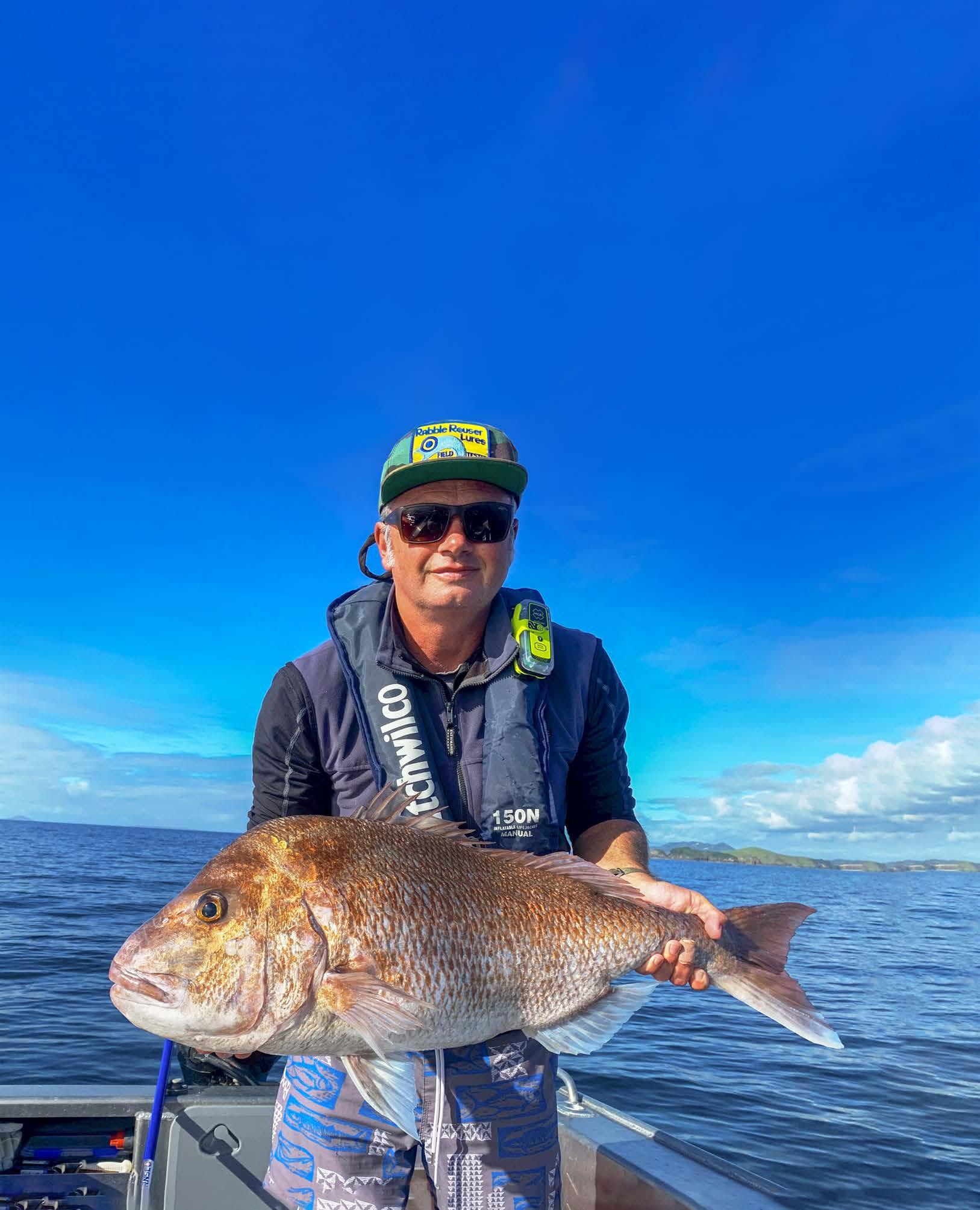


For many snapper fishers, a ‘20-pounder’ is their trophy fish benchmark, but it doesn’t always come easy. One fisherman who’s spent a lifetime chasing the magic mark is reader Lester Thorley…

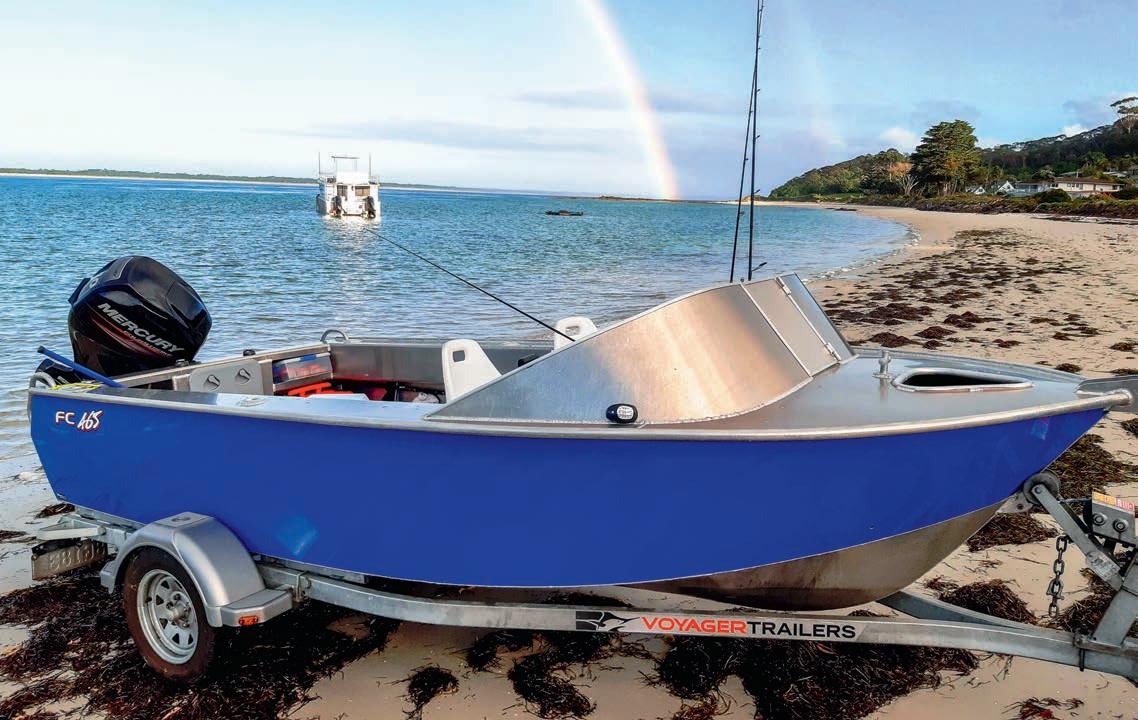
One more highway bend through the windswept landscape and I finally glimpsed the expansive clear waters of Rangaunu Harbour after a long drive to the Far North.
My quest to catch a fabled ‘20 pounder’ had brought me back to the Karikari Peninsula for a trip that I had been planning and preparing for months.
As arbitrary as the old imperial 20-pound (9.07kg) benchmark is as a measure of snappercatching accomplishment, it’s a club most tamure-focused fishos seek to join. Some people catch numerous giant snapper every year, but the fact I had never managed to secure membership despite fishing for snapper since I was a child was starting to become a large hairy primate on my back – especially when I’d occasionally hear a story like some kid fishing off an Auckland wharf had caught a suicidal giant snapper using a sprat rod and a bit of old squid.
My local fishing store The Big Fish Bait and Tackle certainly lived up to its name a few years ago when I was shown a behemoth Great Barrier snapper in their walk-in freezer awaiting a trip to the taxidermist. At well over 15kg, that whopper made my typical catch look like goldfish.
But as I mostly fished Auckland’s Waitemata Harbour and Tamaki Strait, where big snapper are rarely caught in modern times, it’s not surprising a 9kg red had
eluded me in my home waters.
I tried charters to the outer Hauraki Gulf, and one to Little Barrier, without landing anything bigger than my average. So, a few years ago, I decided to take charge of my own fishing destiny: I bought a very seaworthy, but modest FC 465 runabout and made the effort to get to renowned big fish areas accessible to small boats.
I pored over articles by soft-baiting experts Mark Kitteridge and John Eichelsheim and put their tips into practise I consequently got addicted to the adrenaline injection from catching line-peeling fish on light but strong gear, and my personal best snapper improved in small increments to just over 7.5kg (about 17lb).
So, as I towed Te Korora down a steep hill to the beach at Rangiputa on a blustery autumn morning and shoved the Hilux into low ratio, I was brimming with anticipation. Game time.
As I got everything ready for a solo launch, an unexpected rainbow appeared across the pale northern sky and blazed its colourful trail into the sea off Houhora. Was this beautiful phenomenon an omen pointing the way to big red treasure?
Unfortunately, any possibility of an immediate answer was thwarted by rising 20 knot nor’easters which confined my day one
 Trevally like this caught in the harbour shallows made for an exciting curtain raiser to the main event.
Trevally like this caught in the harbour shallows made for an exciting curtain raiser to the main event.


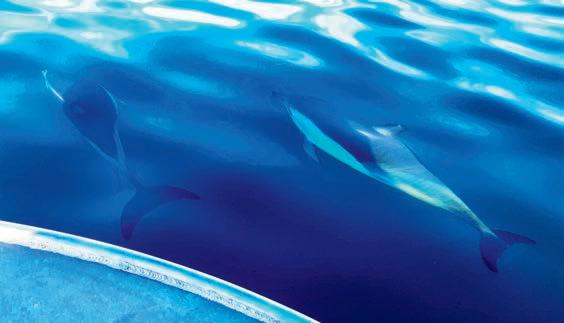
efforts to the harbour. A steady stream of chunky snapper snaffled my soft-baits in the shallows –their blue fins flashing like neon signs as they came to the boat for release.
Day two and three were frustratingly stymied by a cold front sweeping up the country and so were spent in the comfort of my farm stay tying fresh FG knots, watching a vintage Matt Watson soft-baiting DVD (go the Squidgies!) from the owner’s collection, and nervously cross-referencing three marine forecasting sites. A mint day was predicted later in the week, and I clung to hope that the weather modellers were on the money.
I blew the cobwebs off on day four with another choppy harbour fish. The highlight was a 60cm trevally which went like a scolded cat in eight metres of water and glinted gold and silver on the deck before going in the chilly bin to
become delicious sashimi and kokoda.
My mate Chris arrived as planned that night, just in time for the first calm day of the trip. With more strong winds looming at the weekend, it felt like now or never.
At dawn, we put two spare fuel cans in the boat, filed our planned all-day trip to the remote Great Exhibition Bay with Coastguard, and headed out of the glassy harbour and beyond the Houhora entrance to belatedly seek that rainbow’s potential treasure.
We had no intel about secret spots up the long arc of coastline, so cruised along looking for uneven ground or good sign on the Garmin and drifted back over anything promising. But adding a large pig fish and a startlingly red granddaddy hapuku to my list of species captured on soft-bait

wasn’t exactly the outcome we’d been hoping for.
I had started off fishing an Atomic Sunrise Doormatadorz 6” grub, hoping the soft-bait’s fat profile, colour and tantalising movement would appeal to an XL-sized snapper. I was second guessing my choice when it suddenly got nailed by something big just as it began to drag behind the boat.
My Penn Slammer III haemorrhaged line at an alarming rate before I got the fish’s head turned, and after a thrilling fight we landed and released a 70cm snapper – but not before it painfully crunched my middle fingertip when I was trying to free the well-hooked jighead.
As I tried to staunch the bleeding and swelling, Chris gleefully hooked up to a solid 67cm fish that engulfed a Nuked Pilchard 7” Jerkshad at the end
of the drift and swam away strongly after a quick photo. He was delighted with a new personal best.
Allowing our soft-baits to drag after the swing was proving deadly, and it was about to pay off again.
Another powerful fish – our third in 10 minutes – annihilated my big orange grub and took off on a screaming run against plenty of drag pressure.
This one was in a different league in weight and brute strength. It tried some scarily vicious head shakes which my Daiwa Slugger rod soaked up, and eventually a huge red and white shape wobbled into view behind the boat and rolled on the surface. When it was safely in the net, we each let out a whoop.
We both knew it was bigger than anything we’d caught before, and once I got my shaking hands in control enough to measure it, our official mat confirmed this donkey was 81cm, and the weight a hefty 21lb.
Cue utter exhilaration and satisfaction. My ‘20 pounder’ at long last! I was so grateful to have a great mate with me to share a moment I’ll never forget.
When we tried to release it, the fish unfortunately flopped weakly on the surface. We suspected it was affected by barotrauma, despite the modest depth. So, I dispatched and chilled the giant down for it to be expertly slow smoked overnight by the owner of Rangiputa Retreat in return for a six pack. The head was gifted to his wife’s colleague at Kaitaia Hospital.
I sat back and took a few minutes to reflect on achieving something I’d dreamed of for so long and made sure to appreciate our surroundings.
The sea was like a millpond all the way to North Cape, and we were in shorts and t-shirts on the cusp of winter. A huge albatross glided past, soaring and diving across the oceanic swells; pairs of korora (the little blue penguins my boat is named after) honked their calls as waves broke against the
Chris Gregory battles the first of his progressively heavier best snapper. A garish granddaddy hapuku comes to the boat.
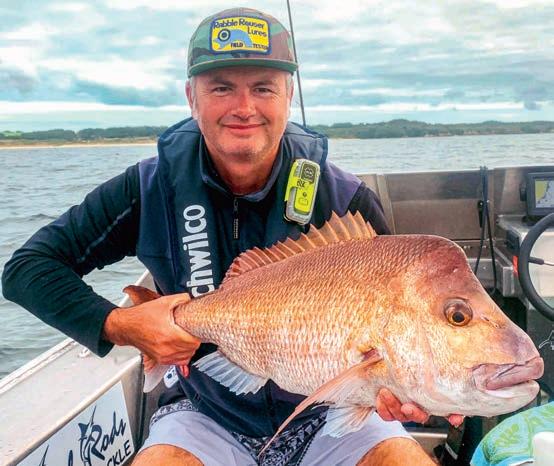
remote shore.
Later, when I was getting ready to net a big fish Chris had been playing, my rod in the corner holder bent over severely with the Slammer screaming again. It was every man for himself, so Chris netted what turned out to be a superbly conditioned 73cm fish – and his second ‘PB’ upgrade of the day.
Mine turned out to be a prime 73cm snapper with a striking hump head. The classic red and green Nuked Chicken Glow version of the Doormatadorz was jammed in its jaw hinge. Both big fish powered away on release in 18 metres.
It was a very content boat ride during the long, smooth cruise home. Neither of us could quite believe the day we’d had, and it wasn’t quite over.
leapt clean out of the water; then a pod of dolphins surfed our bow wave for several minutes –the perfect escort towards the finish line of our epic Far North adventure.
It was time to pack up and follow Chris home in convoy through bush-clad Northland hill country with Springsteen on my stereo. I sat more comfortably without a monkey squeezed behind me.
We saw some surface commotion about 100m to our port side before an albacore tuna WE

Send to grant@ nzfishingnews.co.nz
A traditional style jig rigged ready to fish for snapper and other inshore species.
Available in 20g, 40g, 60g and 80gm sizes and in four popular fish-catching colours.
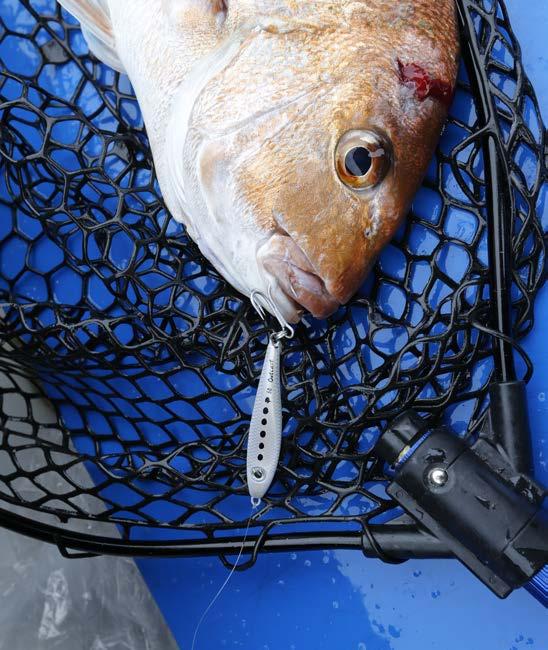

Available in two sizes – Shorty and Original, Baker HookOut tools enable anglers to safely remove hooks without damaging either it or themselves. Manufactured in both stainless and galvanised steel.


All products available at your local tackle store for a list of retailers visit WWW.CONAGHANS.CO.NZ


Blast from the Past

Dixon looks back at what was making the headlines in the August issues over the last two decades – five years apart.
Understandably, winter angling techniques were to the fore in all four issues under review.
Winter is traditionally a time when many anglers make those longer-range forays to target the ‘cellar dwellers’ – hapuku and bass – as well as kingfish. It is also a time for the freshwater anglers to shine, especially those targeting the spawning runs in the mighty Tongariro whose lower reaches remain open all-year around. While they might not spend as much time on the water, the keener anglers will be preparing for the warmer conditions and new seasons ahead, tidying up their tackle, practicing new knots and creating fresh rigs for what is to come.




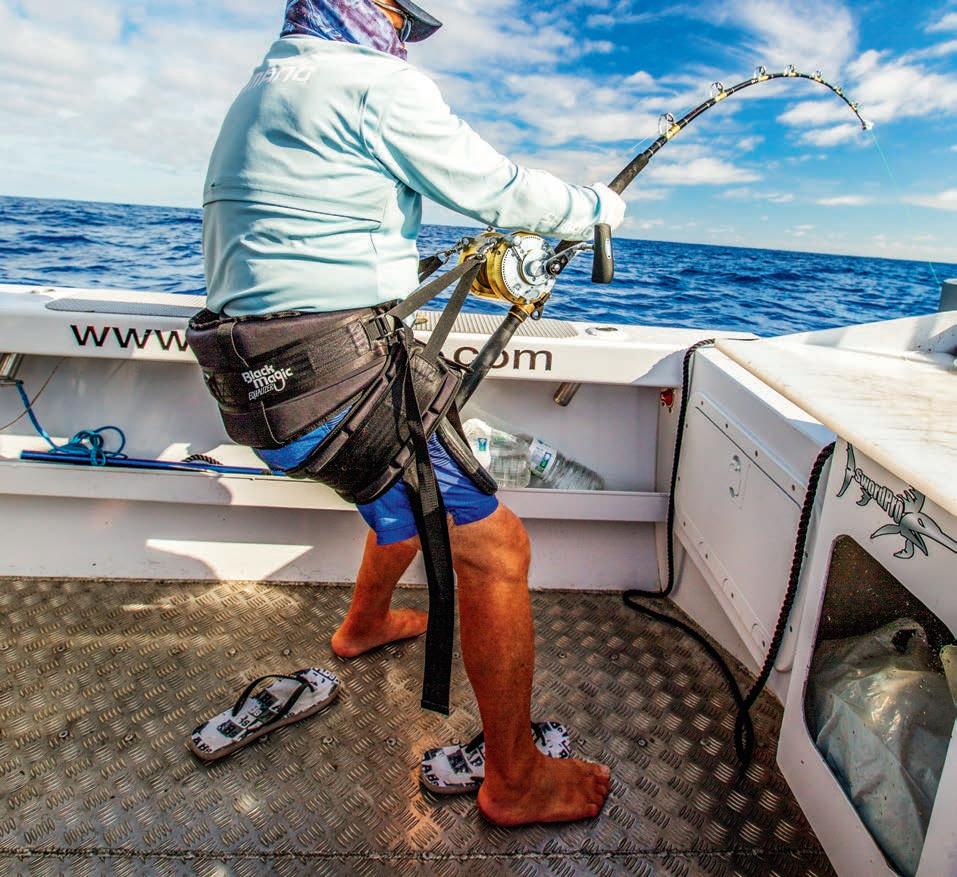
Grappling Groper shouts the headlines, backing up a cover image of angler Des Cogen holding up a 68.8kg bass caught aboard Cova Rose at the Ranfurly Banks, a destination now popular for the long-range charter fleet.
The cover led to a story by Mark Kitteridge who wrote about targeting the depths, offering plenty of advice on rigs and techniques.
Another deepwater fish, the mighty broadbill, was starting to gain more attention from anglers looking for fresh challenges. Bill Hall shared his thoughts on this fishery, which at the time was mainly a deep-drop night-time activity. One of the specialists was Bay of Islands charter operator Geoff Stone (fishing
aboard Major Tom II) who, along with experienced veteran angler Gerry Garrett, championed slow-trolling at night, then deep dropping during daylight hours. It was the forerunner of things to come and as Bill commented, “To catch a broadbill in those days was – and still is – the ultimate goal of every game fisher.”
One of those leading the modern-day broadbill charge was John Gregory aboard Primetime, a combination that was to gain an international reputation, attracting anglers from across the globe to come down-under to test their fishing mettle against one the of the greatest adversaries. Matt Watson, then a crewman aboard Primetime, wrote about their exploits. He
said at the time, “Although we have had a good run – 12 broadies in five trips – I believe the best is still to come.” He was not wrong, with the skipper and vessel going on to set all sorts of records, including catching a world record for then crewman Jim Gigger.
There was plenty for the freshwater anglers this issue, including tips for winter fishing from Adrian Bell, John Murphy and Ron Giles, the latter sharing a technique called ‘walking the dog’ which is ideal for the likes of the Tauranga-Taupo. This is where the angler walks their nymph downstream at the speed of the water’s flow. It’s similar to the ‘egg rolling’ technique used to target the monster trout of the Mackenzie country canals.


Long-time contributor Mark Kitteridge has been a champion for circle hooks when targeting not only snapper, but a range of other species. What he wrote about in the lead 2006 feature ‘Into the Winner’s Circle’ is just as important now, if not more so, as more anglers practice catch and release. Mark goes into great detail – a trait of his writing – on how to fish and bait up with recurves, the former quite different in that the angler does not strike to set the point but puts steady pressure on to roll the hook into the corner of the fish’s mouth. The cover shot showed Mark’s sister Rachel with a nice snapper caught using the methods Mark highlighted in his article.
Noted skipper and then contributor Jeff Strang covered similar techniques in his Kingfish Capers feature. Jeff ran several of the prominent Bay of Islands charter vessels over a period and regularly put clients onto big greenbacks. He had spent some time crewing on overseas game boats, and adapted some of those techniques learned abroad on the local kingfish population.
The tagging programme, being overseen by John Holdsworth, Pete Saul, and Tim Sippel, was in full flight and the satellite tagging programme had already returned some interesting information on the movements of our billfish population. In 2006, 15 striped marlin were tagged with PSAT tags (Pop-off Satellite Archival Tag). Some 371 days of data was retrieved, showing our fish headed for the likes of the Tasman Sea and the Fiji Plateau, including New Caledonia and Vanuatu.
All 15 fish survived at least the first week, which probably had something to do with the fact they were all caught on lures and hooked in either the mouth or
the bill.
Tagging work continues today with both PSAT and conventional tags, although there is some debate among the fishing fraternity as to the value of the latter with a growing number of anglers choosing to catch and release fish without tagging them.
Roddy Hays was an English lure maker and world-renown skipper who moved to New Zealand with his family for a short period. During that time, he penned several informative articles where he shared his experiences on everything from early season marlin behaviour, lure choice, ‘manners’ when chartering a boat, watching and listening to gain information, and soft-heads v conventional lures. This issue contained one of his first contributions and it was well received.
More on the local front, John Murphy’s how-to this issue directed readers on how to make their own flasher rigs. I remember following John’s instructions and knocking up some tarakihi



rigs using 1/0 longline hooks which fished particularly well and at a fraction of the price of commercially pre-tied ones. John was an avid freshwater angler and fly tier, so saltwater flasher rigs were an extension of his skills.
Surfcasters have always been a big part of our readership with the likes of veterans Bruce Basher, Jim O’Brien and Gary Kemsley
sharing their knowledge and experiences. In this issue Bruce wrote about the influence of time and tide. Interestingly, much of what he wrote about had just as much relevance for boat anglers as those fishing off the land. Even if an article has a ‘landbased’ strapline, it doesn’t mean there is not a gem or two in it for the boat anglers!

In 2006, 15 satellite tags were


Kingfish were the hot topic this issue. Charter skipper Ben Pokaia shared some surface lure action and tactics while our Reader’s Story, written by Joe Edlington, looked at the different techniques he likes to use when taking on this great sportfish.
By now ‘slow-jigs’ were all the rage. Mark Kitteridge’s feature ‘Just Another Slow Day’ highlighted the techniques used to work these lures effectively, gleaned over several successful days out on the Hauraki Gulf. While being something of a novelty then, slow jigs now feature in most snapper fisher’s arsenals in some shape or form.
I hosted a reader’s trip to Vanuatu, fishing aboard the boutique cruise vessel Island Passage. This was a great operation with several smaller 6-7 metre vessels carried on board and transported from hotspot to hotspot. We caught a variety of species both trolling and jigging/ topwater.
In the how-to department, Tom Lusk wrote about preparing salt baits including mussels, pilchards, squid and skipjack tuna. Sam Mossman’s piece on ‘Spinners and Speedsters’ looked at targeting a variety of the faster species on lures and light spin tackle. Rounding off the tutorials, Graham ‘Bonze’ Fleet put his spin on the use of teasers for gamefish.

Slow jigs had recently been introduced in our stores and were proving efficient fish takers.


Topwater lures were proving popular with sportfishers looking to add variety to their kingfish endeavours.



Asian anglers have been at the forefront of jigging techniques and tackle for a long time. Keen Kiwi jig fisher Jed Radaly had the opportunity of fishing with one of the patrons of the technique – Taiwan’s Pony Liu of the Jigging Masters development team – when he was in New Zealand to take on the Three Kings kingfish aboard Cova Rose.
Jed had a fantastic trip and took away plenty of tips and tricks which he shared with readers. One was the use of overhead reels underslung on spin rods, making the jigging effort less tiring. Pony introduced the tiring Jed to the ‘old-man style’ of jigging – a heavy duty form of slow-pitch jigging that used lighter jigs and a slow, more deliberate lift and wind.
Jed’s article was accompanied by a sequence on tying the simple but very effective chain knot, which makes the connection between the leader and the assist hook rig via a stainless-steel ring.
Winter fishing tips and techniques were very much a focus this issue. The magazine’s west-coast specialist Ben Francis shared what was the first of his many articles on this region.
Surfcasting and rock fishing are the two main branches of the Kiwi landbased scene and require quite different skill sets. Wellington contributor Andy Macleod is well-versed in both and in his feature discussed the advantages and disadvantages of both styles, as well as successful tackle and technique tips.
Saltfly exponent Craig Worthington looked at targeting winter trevally with
the long stick while herb Spannagl highlighted the advantages of taking on trout after dark.
While this may have been a winter issue, there were two features highlighting a couple of the lesser-known offshore destinations. Spearfisher Darren Shields is always up for an adventure, this time heading for the oil rig platforms off Mexico where he targeted the likes of cobia, cubera snapper and giant trevally and barracuda.
A little further south in Costa Rica, I was enjoying several days some 100 miles offshore with Tony Orton on an Offshore Adventures trip targeting blue marlin and sailfish on a live-aboard charter. We were not disappointed with the action. On the days we were on the water (10 in all), the worst conditions were 15 knots, and that was only for a short period. The angling was as spectacular as the weather, averaging around five blue marlin a day when actively targeting them. Can’t wait for these borders to open.
There were some great news stories this issue.
Sam Mossman’s Fishing Personalities piece highlighted the successful career of Bruce Martin who helmed the Bay of Islands charter boat Predator on many missions, producing several world records.
Kyle Ridling was involved in the tagging and releasing of the first billfish for the NZSFC’s ‘season’, this time doing it solo from his 4.85m Surtees Yonkers.
There was also Michelle Remeka’s 50kg plus hapuku caught ‘out the back of the Mokes’ on a light spin rod; the closure of Marlborough Sounds/Eastern Tasman Bay scallops in part for the coming season (although I note the industry managed an increase from 1,617 tonnes to 1867 tonnes for that greater management area); and the world’s longest trout – a 106.0cm monster rainbow (36lb-16.5kg) caught by Antoine Monier. At the time, the world IGFA length mark stood at only 79cm.
The cover showed Paul Davies with a respectable Far North snapper, caught fishing with charter skipper Dave Arrell aboard Double Strike.



 Kyle Ridling has set the bar high when it comes to catching the first marlin of the season. This one was done solo from his 4.85m Surtees Yonkers.
Jed Radaly was given a lesson in jigging by ‘the master’ –Taiwanese angler Pony Liu.
Kyle Ridling has set the bar high when it comes to catching the first marlin of the season. This one was done solo from his 4.85m Surtees Yonkers.
Jed Radaly was given a lesson in jigging by ‘the master’ –Taiwanese angler Pony Liu.


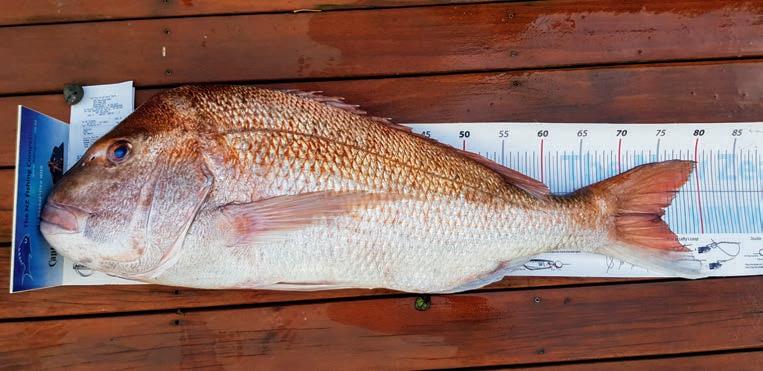
The Export Fishing Competition has had a promising start to the season with a good haul of catches from around the country.
Export Comp anglers have been straight into the swing of things this season! Commendable catches from June go to Lewis Fisher’s 54cm blue cod from Canterbury and Joshua Rodgers 51cm gurnard pulled from Wellington Harbour.
Charles Gray was the winner of our June prize draw. He took home a Shimano Thunnus 8000 and Shimano Carbolite rod for his 75cm snapper entry. Remember that these mid-season prizes are drawn at random, so any entry across the month, big or small, is eligible.
Here are a few important reminders about the Export Competition:
1. It’s free! Registration is free, as is entering catches. As long as you have an Export New Zealand Fishing Competition approved measure mat and a smart phone, you’re away!
2. Fish competitively while protecting our fisheries. Unlike traditional fishing competition formats, the Export NZ Fishing Competition gives competitors the opportunity to release their fish after photographing it.
3. Win unique prizes! This season alone has over $20,000 worth of prizes from



TroutIan
Blue mokiNo entries
Shimano and Bradley. A big portion of these prizes are dished out throughout the season either monthly or bi-monthly, and are drawn randomly from everyone who has entered a catch for that period (this means you don’t have to catch a big fish to win). At the end of the season, the winner of each category will be presented with a Pacifica-style handcalved trophy, as well as product from either Shimano or Bradley
4. Fish against your mates. In the Export comp, you can take on your mates around the country by creating your own personal leaderboard. Just

head to fishingcomp.co.nz, select the leaderboard species and time period, then create your leaderboard and have your mates join. It’s really simple stuff, and not to mention a great generator of side bets and banter!
5. Become a Champion Angler! This is your chance to prove you’re a triathlete of the fishing world – the jack of all trades rather than the one-trick-pony. If you submit a snapper, kingfish and kahawai during the season, you will qualify for the CRC Champion Angler leaderboard and the prizes associated with it.
Each month, one lucky angler takes home a Shimano prize pack, randomly drawn from all competition entries. For the month of July, the Shimano prize pack includes a Shimano Baitrunner Surf, which features a large AR-C spool with slow oscillation in combination with the Aero Wrap II line lay system, ensuring maximum casting performance. This beast has 20kg of drag and is paired with a Shimano Carbolite surf rod, filleting knife and Suffix leader.



Snapper stocks out west of the North Island have rebuilt to an abundance level beyond most people’s living memory. Fisheries New Zealand (FNZ) has proposed catch increases for commercial fishers, an increase to the overall allowances for recreational and Maori customary fishing interests, and no changes to recreational bag or size limits.
This has been a tricky conversation because we rarely deal with mainstream fisheries that could sustain catch increases. FNZ propose to increase the 1300 tonne Total Allowable Commercial Catch (TACC) by 25, 50, 75 or 100 percent.
Before considering an increase for snapper, we need to consider
the impacts on other species caught in the same trawl fishery. Despite being a valuable commercial catch, there is limited information on the stock status of red gurnard, tarakihi, john dory and trevally.
If the Minister permits large catch increases for snapper, we have no idea how an increase in bottom trawling will affect these other species or impact
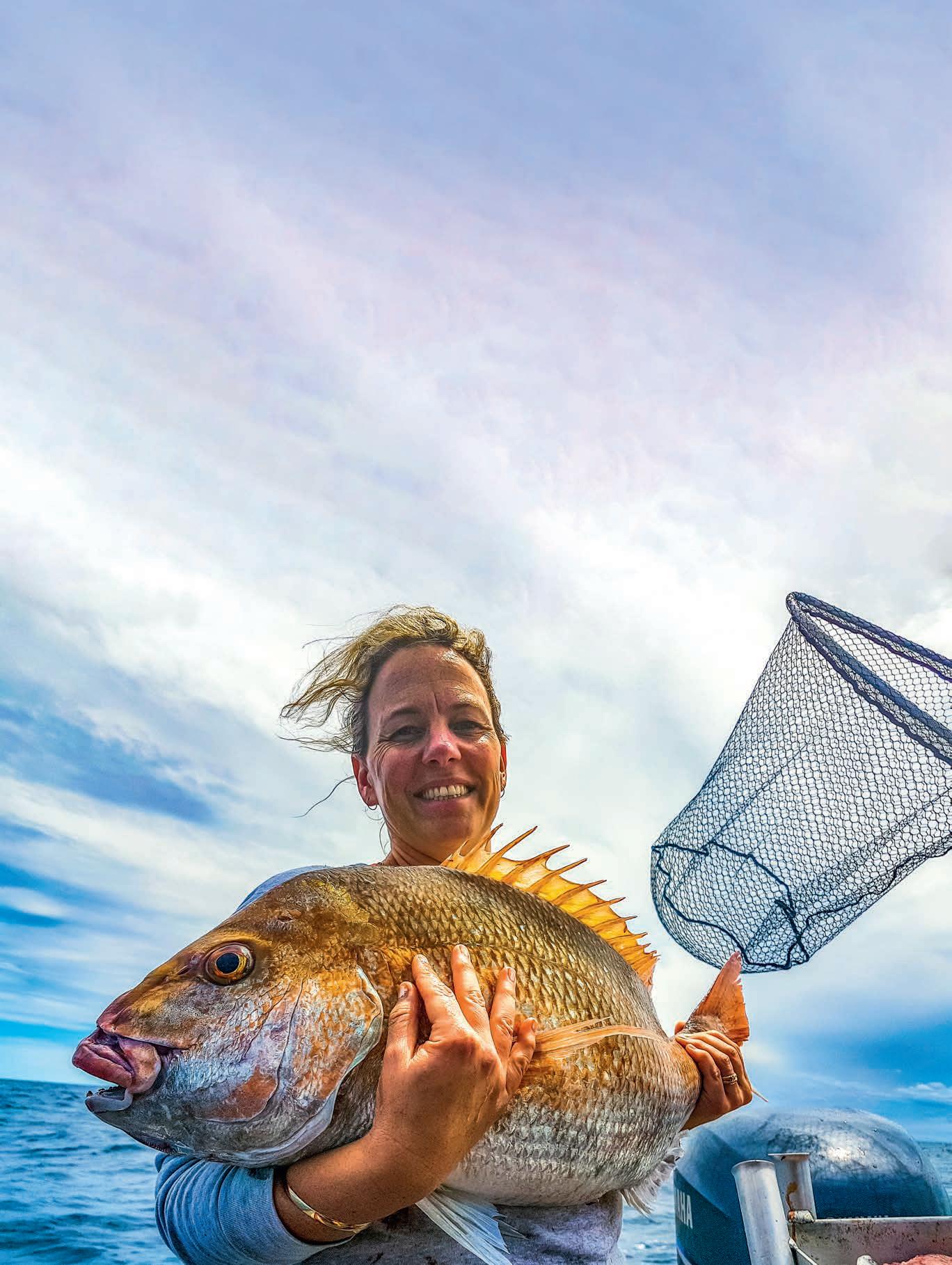
the benthic environment. So, we will be urging the Minister, David Parker, to make a precautionary decision now, and do more monitoring to measure the impacts to check if further catch increases could be sustained in several years’ time.
This precautionary approach aligns with FNZ’s Option 1, a 300 tonne increase to commercial catch limits, and increases that
High use of bottom trawling. Foreign vessels catching large amounts. 1988
Biomass for snapper is reduced to just 6% of the original population size.
1996
Minister rejects proposals to increase trawl exclusion zones which would protect spawning snapper.
1998
A 10-year rebuild plan is introduced to build snapper stock to 20% of the original population size by 2008.
allow for current recreational catch and future customary needs. These increases must only be granted on the basis that the snapper population is reviewed in three years’ time to ensure that there are no adverse impacts on snapper, gurnard, tarakihi, john dory or trevally numbers.
Rebuild is not working. Biomass for snaper is only 10% of the original population size. 2008
Hector’s and maui dolphin trawl exclusion zones introduced.
these fish are leaving in a travel bubble. If they are not caught this year, they will grow and can be caught in a few years’ time.
Ken Barry, President of Raglan Sport Fishing Club, says a high percentage of west coast recreational fishers have more confidence in Snapper 8 as catches have been high, and fishers can go out knowing they can catch snapper.
Snapper 8 quota management area. Source: Fisheries NZ.


Snapper 8 commercial catch by bottom trawling, 1931 to 2020. Source: Fisheries New Zealand, 2021
We understand there is some interest in the Minister not granting any catch increases and we understand the need for a precautionary decision. However, FNZ has not proposed the status quo as an option, and the Minister has to fulfil his statutory obligation to manage all catch within the Total Allowable Catch (TAC), so there will be a TAC increase by October.
The last time the combined SNA 8 catch was as high as now proposed (over 3000 t), the stock was in steep decline and it took many years to recover. Our objective is to ensure Parker takes the precautionary path that at least maintains the snapper stock at current levels.
There is no rush. It’s not like
Several factors have contributed to the rebuild of snapper. Since 2008, there has been a maui dolphin trawl exclusion zone off the coast. Other contributors include several good years where millions of small snapper survived to adulthood, as well as warming waters. It’s uncertain how much each of these factors have influenced the numbers of gurnard, tarakihi, john dory or trevally off the west coast.
We do know that if the Minister and FNZ are serious about caring for our marine environment by applying ecosystem-based fisheries management then this is their first opportunity to show us how committed they are to that approach. It’s not just about snapper. At the very least we must give more respect to the vulnerable species and dynamic environment that exists out west.
“Local fishers are unanimous that the recovery of the snapper fishery has come from the placement of trawl exclusion zones. We don’t want to see that confidence lost due to increased bottom trawling effort.”
Back in the 90s when the Snapper 8 fishery was in deep trouble, recreational fishers voluntarily took measures that would help increase snapper populations. The first recreational daily bag limit set in 1985 was 30 per person per day; now it’s 10.
In 1995, local west coast recreational fishers wanted to be part of a change that would conserve fish populations for generations to come.
Led by the late Paul Barnes, recreational fishers using longlines volunteered to reduce the number of their hooks from 50 down to 25 to sustain the snapper population.
Paul was also instrumental in the discussions leading to an increase in the recreational snapper minimum size limit from 25cm to 27cm, and reducing the daily bag limit from 20 to 15 per person in the mid 1990s.
In 2005, it was estimated that the increased minimum legal size alone reduced recreational harvest out west by around 15-19%. All up, around 27% of snapper catch was conserved due to these actions.


LegaSea is a public outreach initiative of the New Zealand Sport Fishing Council. The Council has an experienced fisheries management, science, policy and legal team. On behalf of the Council LegaSea raises funds and provides public-friendly information about a variety of processes that are important to restoring abundance in our fisheries for future generations.


Honorary Fishery Officers (or HFOs) are among the thousands of volunteers recently honoured as part of National Volunteers Week.
For more than half a century, the Ministry for Primary Industry’s Honorary Fisheries Officers have been donating their time and expertise to protecting New Zealand’s fishing resources, says MPI’s director of compliance services Gary Orr.
“The first HFOs though were appointed in Auckland in 1967, and they’ve been going strong since. Back in those days, it was a simple recruitment process.
“HFO appointments could come after a member of the public expressed their concerns about fishing resources – usually about their favourite fishing spots being stripped. They’d come armed with enthusiasm and willingness to protect it.
“They’d be provided a notebook and asked to report back to the Ministry of Agriculture and Fisheries, as it was called then, on what they saw, which would be followed up by employed Fishery Officers,” says Gary Orr.
These days each HFO contributes a minimum of 100 hours voluntary work a year to looking after recreational fishing areas. They’re put through intensive training, wear a uniform, and have a warrant under the Fisheries Act.
“Their work is critical to ensuring
sustainability. Aside from being stood down for a few months during COVID-19 lockdown, HFOs are front and centre on New Zealand’s coastlines, conducting between 18,000 and 22,500 inspections each year. They’re incredible people –all very passionate about protecting the resource, which is evident through the huge amount of voluntary work they do.
“They do this in their own time while generally leading busy lives outside of this work. Some HFOs have been known to contribute more than 200 hours of voluntary work a year, which shows a real selfless dedication to their communities,” Mr Orr says.
Long serving HFO Cliff Mabey is one example among many. Alongside his fisheries work he has been juggling various other voluntary roles such as the Fire Service, Search and Rescue, and St John Ambulance. He originally became an HFO 34 years ago in the Hot Water Beach area of Coromandel Peninsula because the area was remote and lacked a few services.
“It was a case of showing community spirit and getting involved – something I’ve never regretted doing. I don’t get tired of meeting people and sharing some education on fishing rules and regulations because it helps to ensure our coastal waters and the fishing resources will be protected for future generations to enjoy like I have,” he says.
In recent issues, NZ Fishing News has paid tribute to the volunteers of the MPI’s Honorary Fisheries Officer (HFO) ranks. We continue this issue with Wellington based HFO Nicki Sugden who maintains a balance between helping to keep the oceans clean, as well as serving as a volunteer firefighter and HFO. We asked her how she manages it all.
“I spread my volunteer time around being an HFO, firefighting and participating in ocean clean ups. Fitting in time to be an HFO is about prioritising and finding a balance with the other demands in your life. You know the commitment you are signing up for and it’s up to you to self-manage,” Nicki says.
Nicki, who works for the Hutt City Council, is part of the HFO network patrolling along the south and west coasts.
“I’ve been an HFO for nearly three years. My main reason for joining was my interest in the ocean and caring about sustainability. Being a diver, I was already familiar with our coastline and the rules around gathering some seafood so being able to become part of a team whose main purpose is to protect resources and educate fishers made sense,” she says.
Nicki Sugden, who is 50, has been an HFO since 2019, and says they have a fantastic HFO network with plenty of camaraderie.
“We laugh at each other when we occasionally get vehicles stuck in the sand. Equally, we support each other when help is needed. We’re all there to achieve the same goal – protect the fishing resources. You get to know each other on a personal level being an HFO and really do become like a family,” she says.
She says the busiest period as an HFO is
during summer when she is out on a patrol at least once a week, whereas in winter, it’s a little less frequent.
“It’s just the nature of the changing seasons. However, to keep our skills fresh we also attend regular training sessions which may see us out on the water practicing drills. In Wellington we are blessed with a coastline all around us so we could be patrolling anywhere along the south coast and up as far as Kapiti on the west coast when we are out there.”
Nicki says no day out on patrol is the same as the last one and being an HFO is rewarding and adventurous.
“One of my highlights of my time so far was a combined exercise between Police, MPI and Greater Wellington Regional Council. We cruised along the west coast on Lady Elizabeth IV providing boating and fishing education to fishers during an annual fishing competition. It was fantastic to see so many kids out fishing with their parents and the excitement on their faces when they caught a fish,” she says.
One of the best things about being an
HFO, she says, is meeting other people with similar interests.
“I’m a people person so talking and being able to provide education around fishing rules is really enjoyable. I talk to a lot of divers and fishers and the views from a boat are amazing. Sometimes you must have those not so nice conversations with people around non-compliance with fishing rules, but most people are cooperative,” she says.
She has a few words of inspiration for other women that might be keen to follow her footsteps.
“If you care about sustainability, love being around the ocean, learning new skills and being part of an amazing team, then I’d say don’t second guess yourself and just take the leap. You get to play on some awesome toys, the team are amazing, plus it’s healthy to be put out of your comfort zone occasionally.”
Not one to stay too long away from the salt water, Nicki Sugden enjoys diving for crayfish and paua.
MPI has over 180 HFOs and if you have questions about how to become an honorary fishery officer, email HFO@mpi.govt.nz.



the easiest way to check the rules!
 Wellington HFO Nicki Sugden volunteers on coastal clean-ups while serving as a volunteer fire fighter and undertaking fisheries patrols.
Wellington HFO Nicki Sugden volunteers on coastal clean-ups while serving as a volunteer fire fighter and undertaking fisheries patrols.


There may be issues with the way commercial fishers harvest fish, but Seaspiracy gets a lot of its facts wrong.
Stop eating fish – really? Is it that simple? Steve Dickinson looks at some of the issues raised by the controversial Seaspiracy documentary…
Iheard about Seaspiracy before I watched it. Some friends told me that after seeing the documentary, their teenage children had advised them they were no longer going to eat fish and anyone that did was part of the world’s fisheries problem.
Seaspiracy, made by the same company that produced the 2014 Cowspiracy, which has had its own accuracy issues, is on the surface a look at the impact of fishing on MSY (Maximum Sustainable Yield). Most notably, its final call to action is asking the Netflix subscriber to solve the world’s fisheries problem by

refusing to eat fish.
The documentary is engaging, entertaining, dramatic, and openly pulls at the visual heart strings with heart-breaking images and mood music. It jumps from one tragic scenario to another and is more like ‘Fast and Furious’ than an investigation into the world’s fisheries issues.
A documentary is described as: “A non-fictional motionpicture intended to document reality, primarily for the purposes of instruction, education, or maintaining a historical record.”
From this point onwards I will refer to Seaspiracy as a film, not a
documentary, as it blurs the lines between fact and entertainment.
The tragic issue is that the problems are real. Some of the scenarios in Seaspiracy are truly catastrophic, but the documentary/film does more harm than good by simplifying these problems, seeding misinformation, and introducing a Machiavellian worldwide conspiracy between the fishing industry and conservation groups. And quite simply, it’s blaming the wrong people. Why? Because it makes for a better story. This ‘Hollywood approach’ is not needed to highlight the real issues at play here.
As the film draws to an end, they show a hard to watch culling of a number of whales and then Ali Tabrizi makes a final call to action: “If you want to save the world fisheries, don’t eat fish.”
This simplification is not only impractical, but would actually make the issues worse.
There is not a person who goes fishing or loves the ocean that is not concerned about the damage that Seaspiracy depicts, and while so much progress has been made, there are a multitude of people who still do not know about the problems facing the ocean. So, the prospect of a film on Netflix reaching out to its 200 million subscribers is something I welcomed with open arms.
The film includes all the damning evidence and dramatic footage required to make the important point that industrial fishing throughout the world is too often out-of-control, sometimes even taking the form of a criminal enterprise that needs to be reined in and regulated. Yet Ali Tabrizi fails to focus on the big industrial companies which are the core issue and takes aim at those trying to do good.
At one stage the film criticises ‘dolphin safe’

labels on tuna cans and says, “The internationally recognized seafood label was a complete fabrication since it guaranteed nothing. At this point, I began to wonder what else was being covered up.”
Great dramatic TV, but extremely poor research.
Mark Palmer, the associate director of the International Marine Mammal Project of the Earth Island Institute, did say that “dolphin safe” tuna cannot be 100% guaranteed and that observers on the vessels can be bribed. But what Palmer meant was there was no guarantee –how could there possibly be? He is not on every fishing boat. In contrast, Dr. Sara McDonald of Monterey Bay Aquarium (quoted in Newsweek) stated that “The U.S. dolphin-safe program has been very effective. Dolphin mortality in the 1980s was 130,000. In 2018, there were 819 documented deaths.” This is not a guarantee of no death but those are pretty amazing numbers.
Ali Tabrizi puts the blame for

the fisheries decline on the ocean conservation community and the organisation trying to fix the problem, instead of pointing the finger at the industrial fishing companies at the very root of the issues.
Seaspiracy ended up twisting the narrative about the destruction of the our planet’s fisheries, concluding that if we become carnitarians (a person who eats meat but not fish or seafood), the world’s fishing problems would be over.
In doing so, Seaspiracy weakens its overwhelming potential value: to persuade people to work together, and push for real change in policy and regulations that will actually rein in an industry which often breaks the law with complete freedom.
If you are going to make bold statements, get your facts right – or at least current. One of the main claims the documentary makes is that the world’s fisheries will be depleted by 2048.
In Tabrizi’s own words: “If current fishing trends continue,
we will see virtually empty oceans by the year 2048.”
The claim originally comes from a 2006 study called “Study Sees ‘Global Collapse’ of Fish Species”.
Recently, the author Prof Boris Worm of Dalhousie University said that this research is no longer correct.
“The 2006 paper is now 15 years old and most of the data in it is almost 20 years old,” he explains.
“Since then, we have seen increasing efforts in many regions to rebuild depleted fish populations.”
Another ‘horror’ fact Seaspiracy introduces is that 48% of all fish caught are discarded (unwanted fish that are dumped). The actual discard amount is about 10%, a number that’s still obscene, but a lot less than Seaspiracy’s 48% is actually the bycatch rate, which is simply the number of non-targeted species caught, and many of these fish are still taken to market.
Another glaring sliver of misinformation is the film’s claim that 80% of the world plastic waste in the seas is from fishing nets. This may have been true in the 1980s, but it’s patently wrong now. Currently, 80% of the plastic that ends up in the sea is thrown away packaging (soda bottles, tires, etc), while 20% comes from marine sources, with most of that being debris not netting. So why the fuss? With the blame being put squarely on the fisheries, it takes the pressure off of us on land. But we need to be vigilant about plastic and not pass the buck. Tabrizi actually draws the viewers’ attention to the fact plastic straws are not the issue, which is partially true, but this again shifts the blame and makes us feel better about our own plastic use.
Another unsettling facet of the film is its aim at the Japanese. To be fair, they are an easy target when it comes to fishing. The focus on Japan’s attitude towards whales and dolphins through showing the whaling and dolphin cull at Taiji is heart-breaking, but also makes for great emotional TV. There are images of Japanese
fishermen brandishing knives and walking toward the film crew, Asian people pushing the camera away, and seedy Japanese fish markets with lines of dead tuna on display. Surprisingly, Japan is actually ranked 8th in the world behind USA, Russia and even India in fisheries management.
On reflection, it looks as if the Western documentary maker is making the West the defender of the seas, which is far from the truth. The defence of our oceans is not a West verse East conflict; there are as many, if not a lot more western industries causing huge damage. Once again, the film gave us the chance to point the finger and pass the buck to someone else.
In defence of Seaspiracy, we live in a fast-paced clickbait world. Would our kids sit through a David Attenborough documentary on sea life? Probably not. So these types of bubble-gum entertainment docos are now becoming common. Because it is on television and wears the cloak of a documentary, people just accept the facts as given. Sometimes, these documentaries are just a bit of fun, but when viewers are drawn into a narrative that is dangerously false, this presents a massive issue.
Finally, the conservative environmental group Greenpeace has this to say about Seaspiracy (taken from their website): “But our true power lies in when we work together. If we want to change things at the speed we need to, we must put pressure on global governments to change the way we treat the ocean. The ocean doesn’t have time to wait for every individual to go vegan.”
Seaspiracy is right about one thing – there is a worldwide fisheries issue that needs to be addressed. However, not eating fish will not fix the issue. What will is knowing the correct facts, placing the blame where it belongs, pressuring governments to do better and supporting conservation groups’ efforts to bring about change.

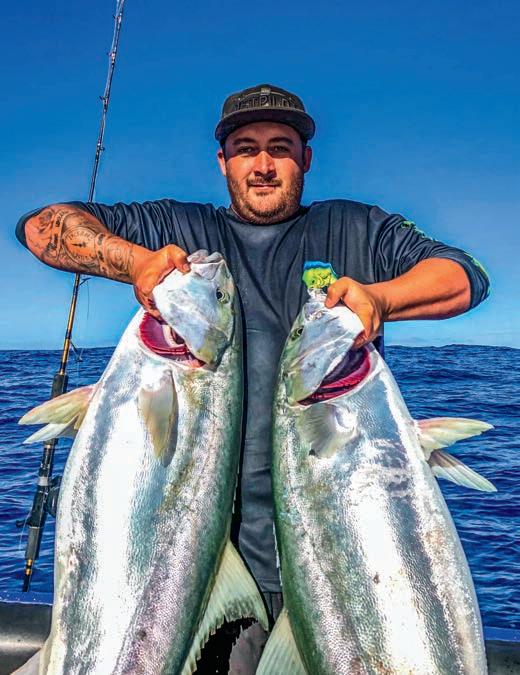
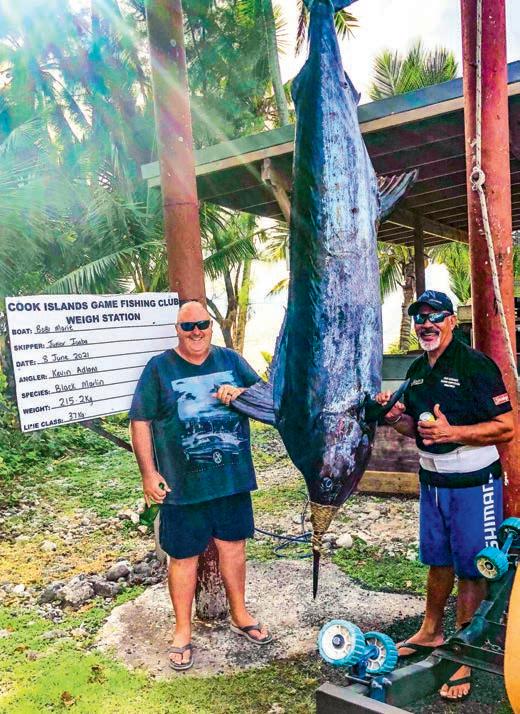


This month out here on beautiful Norfolk Island the fishing trips have been limited again due mostly to strong winds but the days we’ve got out have made it worth the wait.
The majority of the fishermen targeted redthroat sweetlip for their exceptional eating quality and during these cooler months we see some great quality fish being pulled from the hard reefy bottom close to the islands.
But for the more adventurous it’s been a month for kingfish as the bigger fish are already schooling up on the jigging grounds. These fish can be quite a handful even on PE8 tackle as the area is only
For much of June we had to endure very windy weather, which greatly reduced the amount of good fishing days. They were mainly south easterlies, with a few northerlies and north westerlies thrown in.
The game fishing club did manage to squeeze in the twoday Don Beer Snr Memorial Competition. The heaviest tuna was the target and Ola Nyheim, who was out fishing with skipper Kerry Murray, collected first prize with a 36kg yellowfin.
In Aitutaki, the inaugural Queen’s Birthday “Mamas” Fishing Comp was held with 44 mamas fishing from 11 boats. The heaviest fish was a 65 kg yellowfin tuna caught by Pitong Henry, Taioro Tuakana and Mafi Katu-Raga, who
50-60 meters deep and full of whaler sharks. We tend to target them jigging but occasionally we can get them trolling. This can be exciting, especially when slow trolling poppers and stickbaits. The past few weeks have also seen a number of species being caught landbased by yours truly and a few other experienced locals, including yellowfin, kingfish, trevally, sweetlip, bonito, skipjack, mackerel tuna, frigate mackerel, barred longtom and drummer. Over the month ahead we will be doing more of the same and possibly having a troll for a wahoo as we near their season. Stay safe out there everyone and happy fishing.
Wayne Barclay
jenwayne041@gmail.com

were fishing from the boat Baby Mac
Apart from the bad weather, fishing has been a bit slow at Rarotonga. A notable exception was a black marlin weighing 215.2 kg caught by Kevin Adlam from Coromandel. He was out fishing with skipper Junior Ioapa on Bobby Marie. The fish was hooked up only 15 minutes after leaving the marina at Avatiu Harbour.
At last, travel with New Zealand is now open and from just a couple of flights a week at the end of May, we now have 11 a week from Auckland.
So come on Kiwis, escape the cold and enjoy the warmth and the fishing in the Cook Islands.
 Greenwoods Fishing Adventures scottyg@ninet.nf
Scott Greenwoods Norfolk Island
Coromandel angler Kevin Adlam, fishing aboard the Junior Ioapa skippered Bobby Marie, landed this 215kg black marlin not far from port.
Kingfish are mainly targeted using jigs, and then the trick is to get them past the whaler sharks!
Greenwoods Fishing Adventures scottyg@ninet.nf
Scott Greenwoods Norfolk Island
Coromandel angler Kevin Adlam, fishing aboard the Junior Ioapa skippered Bobby Marie, landed this 215kg black marlin not far from port.
Kingfish are mainly targeted using jigs, and then the trick is to get them past the whaler sharks!

Vanuatu is still closed to the rest of the world, and charter operators are just doing the odd trip with local clientele only.
Russ Housby from Nambas Charters has been doing a few day trips, as well as a one-night liveaboard trip. He reports the marlin have been consistent with them catching at least one a day. His best day was three from three – all blues in the 100 to 160kg range. There have been some wahoo and a few sailfish on the bite in closer as well.

Charles Wheeler from Crusoe Charters reports similar results. He has not been doing as many charters but is still getting amongst it when he can. He

As we all know, COVID-19 has impacted the number of anglers fishing the waters of Polynesia. This has most definitely been the case in Samoa, with zero overseas anglers being able to visit since a complete lockout was implemented at the beginning of the pandemic sixteen months ago.
However, it has not prevented the fish from biting, with local anglers taking advantage of the continued run of blue marlin and yellowfin tuna. Three of our SIGFA club legends Uncle Seb, Uncle Pat and their good mate have been a classic example. Each


also mentioned that one of the private French boats went out for a day and struck gold on the yellowfin, catching six in the 50 to 65kg range.
Andrea Traverso from DropCast Fishing has been doing some trips a little further afield. One recent threeday trip to the Shepherd Islands turned in good results with marlin being caught each day. Once again, they were averaging around the 120Kg mark. They were also doing plenty of jigging to catch an array of bottom species. Andrea also mentioned the yellowfin are starting to turn up in good numbers.
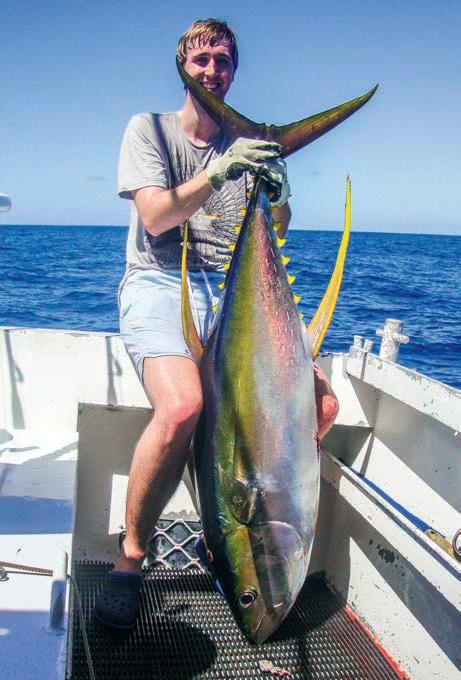
When they have been able to get out, the charter operators have been getting among some good yellowfin.


weekend, fishing aboard Lady Saele, they have hit the drop-offs north of Apia and scored plenty of hook-ups. Most of the fish have been juvenile blue marlin, with the odd mahimahi, yellowfin tuna and wahoo in the mix.
Our new Apia FAD “Dickies”, deployed in April and named in memory of our dear mate Dickie Hume, has also stated to work and is producing marlin, midsized yellowfin to 30kg and mahimahi.
Inshore, spanish mackerel and
the odd sailfish have been on the prowl. The spaniards being landed have been good ones, with fish weighing between 12kg and 20kg common.
Our Kiwi mates will be glad to hear that Team Troppo has taken this opportunity to lift our legendary Bertram 35 Pure Indulgence out of the water for a major refit. After ploughing the waters of Samoa for more than sixteen years and providing hundreds of anglers with the fishing experience of a lifetime, it
is well deserved.
So be assured that once Samoa is included in the “bubble”, Troppo Fishing Adventures and Samoa will be ready to provide our Kiwi friends and their families with a fantastic fishing holiday. The timing should be perfect. Over the next few months, the numbers and size of most species will increase, peaking at Christmas and continuing on into the first months of the New Year.
Greg Hopping greg@troppofishing.com www.fishsamoa.com Pure Indulgence has been taken out of the water for a well-deserved major refit that will include the addition of a hardtop and new motors. Right: The writer with a nice Spanish mackerel caught while trolling the inshore waters. Nautilus Watersports nautilus@vanuatu.com.vu

Unsettled weather made it tough going for the locals who ventured out to try their luck around the recently deployed Southern FAD.
Lots of bird life, skipjack, mahimahi and school size
yellowfin are holding all through the area. Mahimahi up to 16kg and yellowfin between 7kg-9kg are in abundance, and there are a few wahoo to 15kg.
Further south to the Fatamanga drop-off, there are reports of

Mahimahi have been around in good numbers with fish up to 16kg being caught by the few boats venturing out.
good blue marlin action up to 200kg and sailfish around the 35kg mark. However, no boats ventured further south due to the rough sea conditions. The water temperature is stable at 26C, which historically is a
little warmer than usual. There have also been some good inshore bait runs of kawakawa and further reports of sailfish smashing the schools in the eastern reef area.
Editor;
I am struggling to get my head around just what the Department of Conservation could bring to the table with their current proposed annexation of the Fish and Game organisation?
Given that their recent policies and actions clearly show they are anti the hunting and fishing brigade – just look at the tahr cull and them wanting to ban trout as a non-native species as examples – I can’t see what positives they could possibly contribute.
The most annoying part is that they will want their nominated representatives to be paid, and the same for any Maori representation. For an organisation mainly administered by volunteers who do it because they are passionate about their sport which they are actively engaged in, that is not acceptable.

Editor;
The final thing is, when are the hunters and anglers going to get a say in all this? After all, it is our money. F&G is not funded from the public purse.
I am starting to get tired of this Labour government pushing through the likes of the $780 plus million cycleway for the harbour bridge while cancelling more important infrastructure projects such as the extensions to the Northland expressway; hastily imposing oil and gas exploration bans while importing record amounts of coal from overseas; car taxes; rushing law changes around Maori representation in local government; and attempting to cut the public off from their favourite Hauraki Gulf fishing grounds. It is time to say ‘enough is enough’.
– R Smith (Email)


Thanks for your editorial regarding the Fish & Game Review, but all is not lost yet. There are a number of Fish & Game regions who are utterly opposed to any Government interference in F&G and many who, whilst accepting this, wish for them to be a distinct minority. On the subject of reducing the number of regions from 12 to six, every Council has written to Paul Shortis, interim CEO of F&G NZ Council, stating this will only happen if there is a damn good reason for it, not just because some bureaucrat says so. Some regions will be surveying their licence holders on what they think of the more extreme recommendations, and the NZ Federation of Freshwater Anglers is encouraging the NZ Council Chair, Ray Grubb, to initiate a national survey of all 150,000 licence holders before steaming ahead with any changes. We have shared the results of our online survey with Ray which showed overwhelming opposition to Government appointees to F&G Councils. The NZFFA has also formed a delegation to the acting Minister of Conservation and we await (without holding our breath) for her to proffer a date to meet. It is up to all anglers and duck shooters to determine the outcome. Make your voice heard – write to your MP, to Ayesha Verrall, Minister of Conservation (a.verrall@ministers.govt.nz), to Fish & Game (fgreview@fishandgame.org.nz), and let them know what you think about paid Government employees being appointed nationally and in every F&G region.


– David Haynes, Secretary Treasurer NZ Federation of Freshwater Anglers


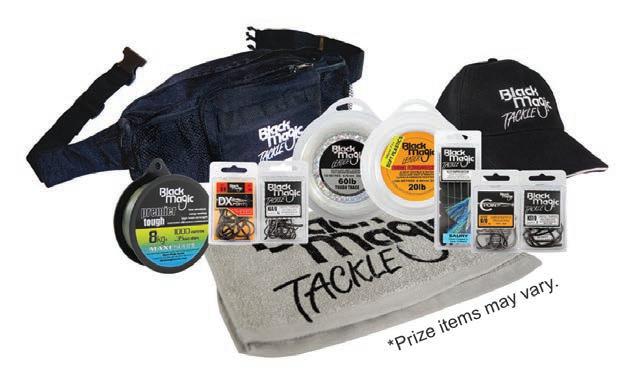












Throughout the year NZ Fishing News’ readers visit some fantastic fishing spots and make some great catches. We invite you to share these moments with us and fellow readers by contributing your special images to the Shimano Readers’ Photos pages. The pictures you send can be in either digital or print format. The following checklist offers some guidelines to ensure your special moment makes it into print.
Images should:
• Tr y and catch the delight of the angler’s




• Be maximum file size – i.e. send it to us at the original size it was taken – and certainly not less than 300kb.
• Include the photographer/sender’s name, address, contact phone and email address.
• Include a shor t sentence or two explaining who/what is in the photograph/image, along with ‘where and when’ details.
the Mercury TAKF pages, details of which can be found elsewhere in this edition.
Each month we will randomly draw one image that will win the photographer a special pack of Shimano lures valued at $100RRP, courtesy of Shimano NZ. The pack includes…

 Nirmal Maharaj caught this good looking snapper on the north side of Kapiti Island.
chunky bluefin tuna.
Nirmal Maharaj caught this good looking snapper on the north side of Kapiti Island.
chunky bluefin tuna.















Colt Sniper Wonder Fall – 100g Real Anchovy
Tiger Bakubaku – 80g Sardine
Pebble Stick – 200g Orange Glow
Sardine Waver 51T – 130g Purple/Pink/Gold
Shimano Brenious Cap – Blue/Black

Entries should be emailed to ethan@nzfishingnews.co.nz with ‘Readers’ Pics’ in the subject line.
Photographs posted in should be sent to ‘Readers’ Pics’, NZ Fishing News, PO Box 11-640, Ellerslie, Auckland 1051. If you want your photo returned, please include a stamped, selfaddressed envelope. This month’s winner is Cassie Clark.


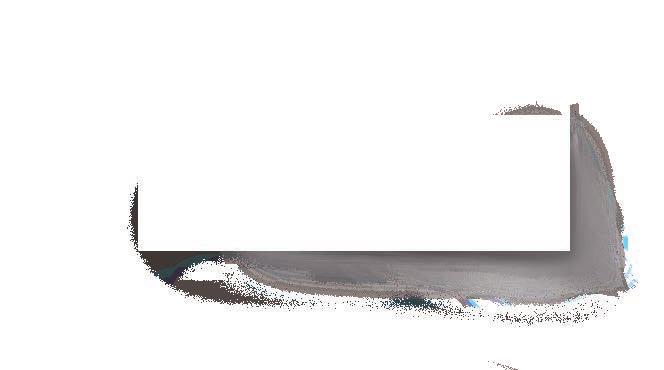


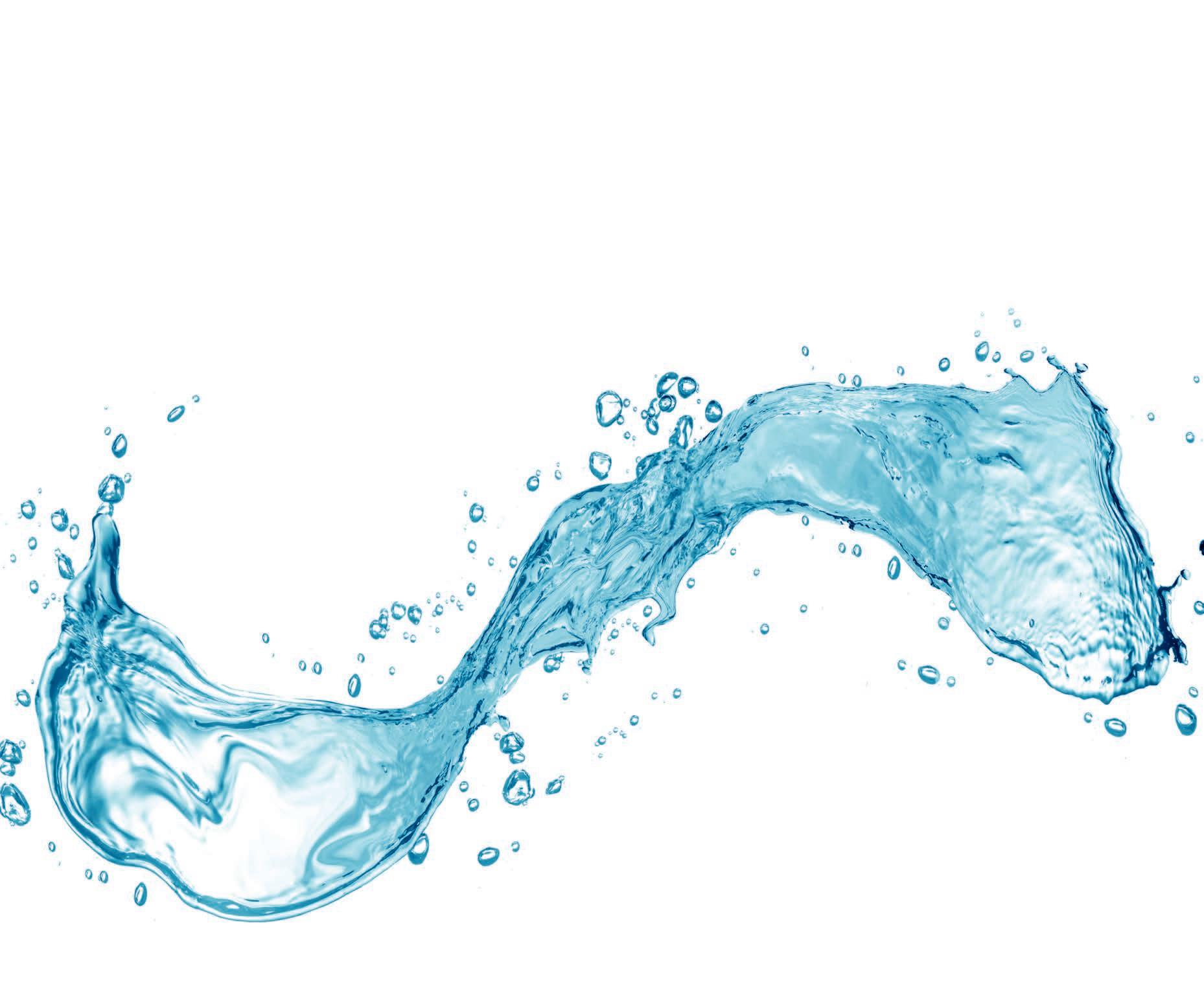 On a girl’s weekend trip to Pahi on the Kaipara, Nicky Steele rowed out in a little dingy and landed this tasty 48cm snapper.
James Higgs reeled in this 25lb snapper off a beach near Whakatane using only 6kg (14lb) line – a great effort!
Jayden Emtage caught his first bass while out lure fishing in 200m off the coast of Doubtless Bay.
On a girl’s weekend trip to Pahi on the Kaipara, Nicky Steele rowed out in a little dingy and landed this tasty 48cm snapper.
James Higgs reeled in this 25lb snapper off a beach near Whakatane using only 6kg (14lb) line – a great effort!
Jayden Emtage caught his first bass while out lure fishing in 200m off the coast of Doubtless Bay.




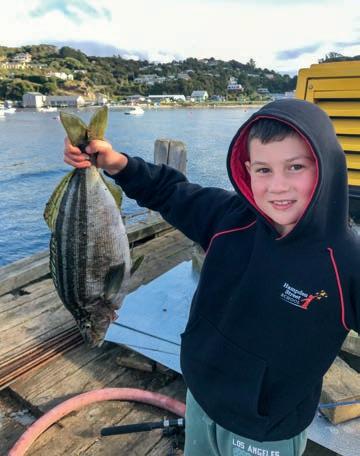
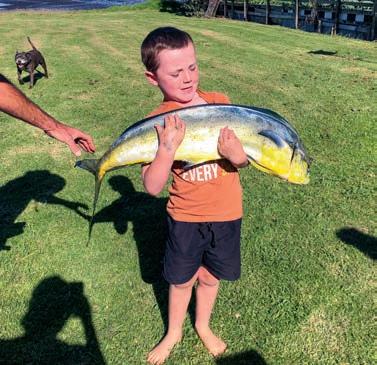
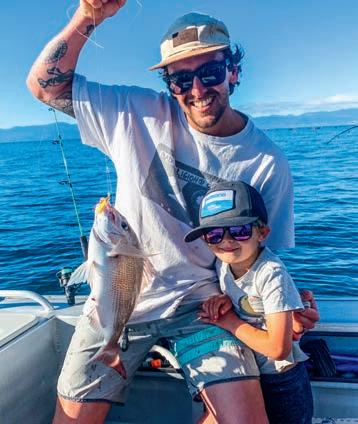


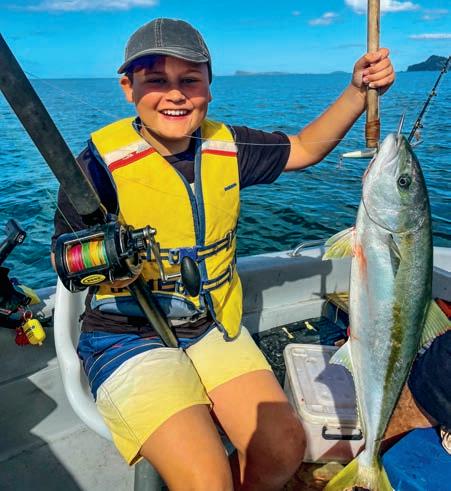

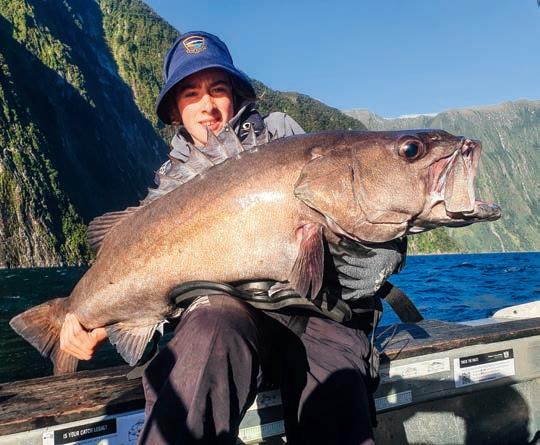
Jano (14) played this 17kg hapuku for 35 minutes while fishing
Toby Rothery (6) wound in this 9kg mahimahi all by himself off Kawhia. Chloe caught this beauty snapper off Grandad’s boat up in the sounds. Charlie Wilson landed this trumpeter from the Halfmoon Bay Wharf on Stewart Island during the school holidays. Kayden Fell-Mellick (7) with his biggest trevally to date. He caught it off a boat near Matheson Bay, Leigh. Loic Ross-Cowie (6) caught this snapper on his first fishing trip with his new Shimano fishing rod at 6am just off Ruby Bay, Tasman. George’s first legal kingfish, caught on a Rapala off Sailor’s Grave in Tairua. Van Riley caught this lovely late season, Tasman Bay snapper on his Shimano Kid Stix. He was using a Black Magic flasher rig with half a pillie. Carter Evans and mate Thomas Ward learnt the art of tight lines on their own while fishing off a wharf in the Marlborough Sounds.
Wil (12) caught this solid snapper just off Rangitoto on his first cast of the day.

Lachie (5) caught and landed this kahawai on his own handline off the Kapiti Coast.

Arie Lee (8) with a classic Coromandel snapper caught while fishing with his dad and brother.


• a Mercury rigid inflatable boat
• a Voyager trailer
• a Mercury 8hp outboard
• a Kilwell rod, reel, tackle box and tackle

• two RFD lifejackets All








































Every subscription goes in the draw monthly to win a catch of prizes worth fishing for!
SUBSCRIBE AT nzfishingnews.co.nz 0800 113 441











Mobile: 027 502 6188
Email: bookings@charterfishingbayofislands.nz


25 YEARS EXPERIENCE FISHING THE BAY OF ISLANDS


Jump aboard our Custom Build 885 Extreme purpose built for fishing, with a full walk around with all of the latest fishing equipment supplied by Catch.
Make a full weekend of it in the beautiful Bay of lslands with Darren. The girls enjoying perhaps the boutique
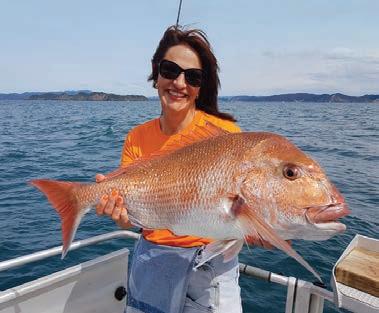
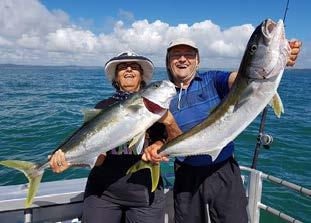
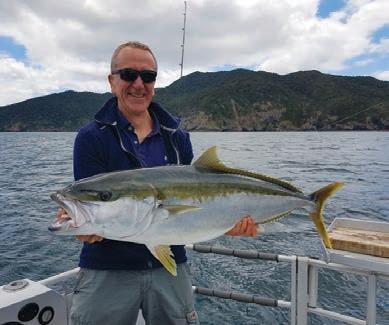

www.fishingdaysout.co.nz
Specialising in Big Snapper & Kingfish & Hapuka, with everything supplied. Days Out Fishing Charters BAY OF ISLANDS • NEW ZEALAND Call Darren 02108604019 email info@fishingdaysout.co.nz fishingdaysout.co.nz

















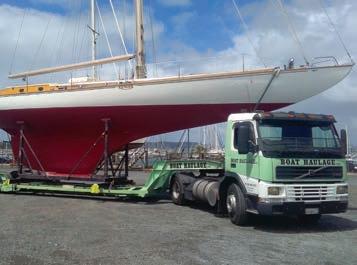





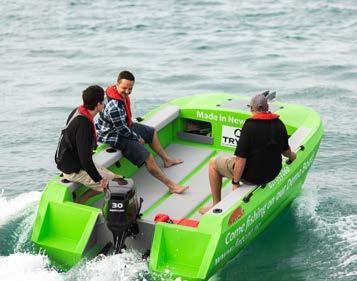


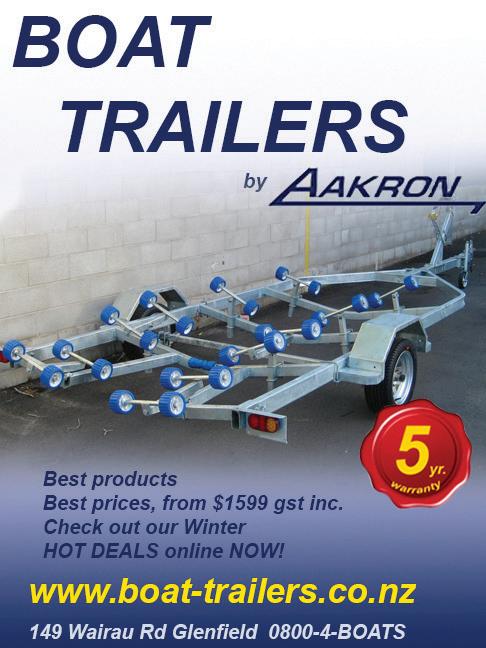







To find time of High Water (H) or Low Water (L) at places other than primary ports shown, note the time difference indicated and add (+) or subtract (-) this time difference from the appropriate chart, e.g. to calculate the high tide in Tauranga, subtract the correction time shown of 13 minutes from the Auckland chart.
These charts are already correct for daylight saving time.



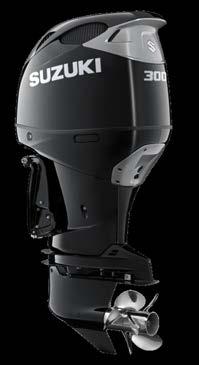
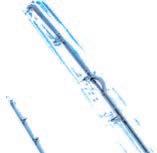
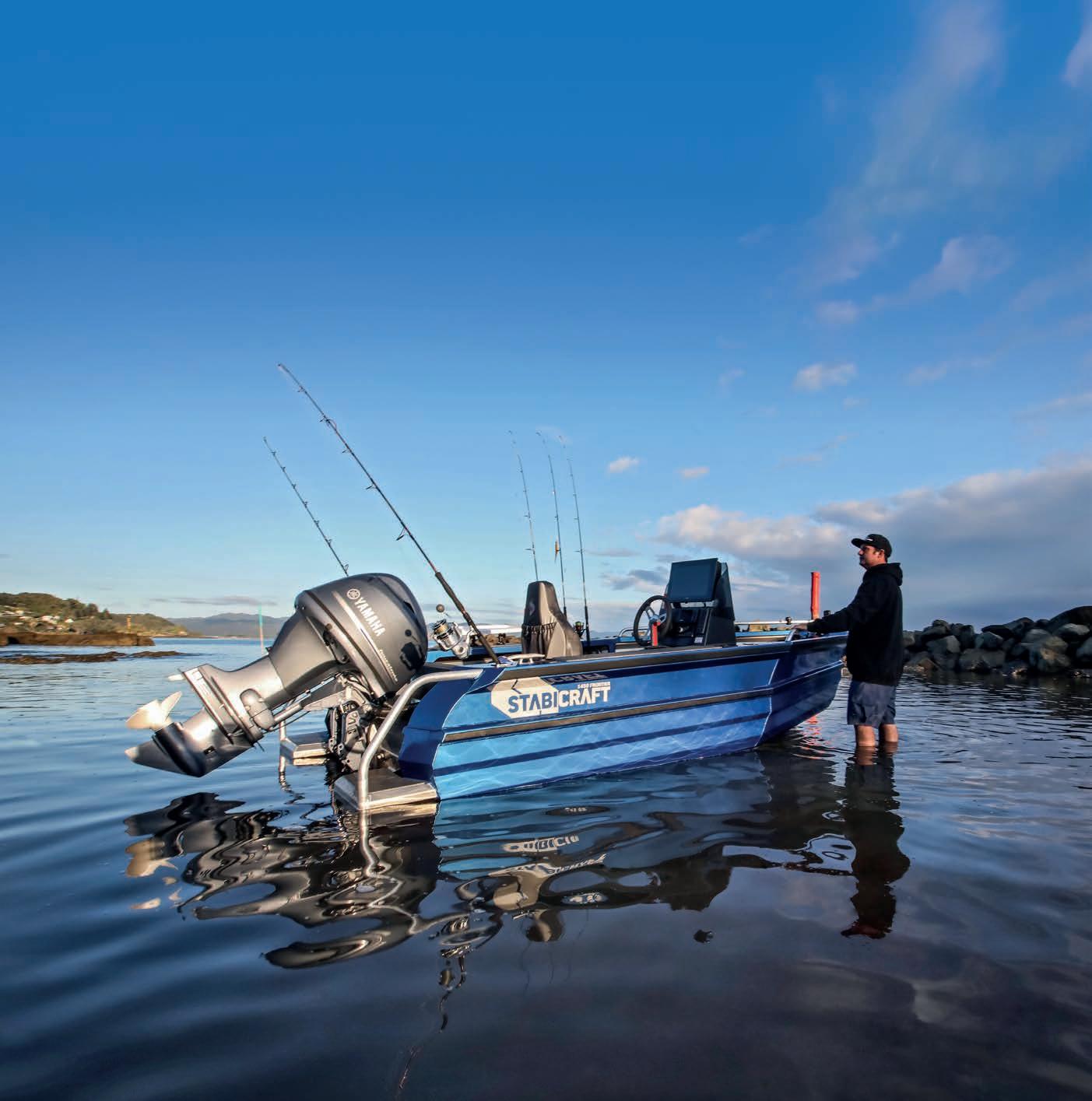

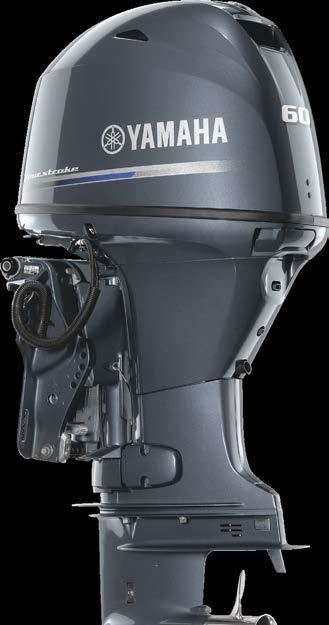


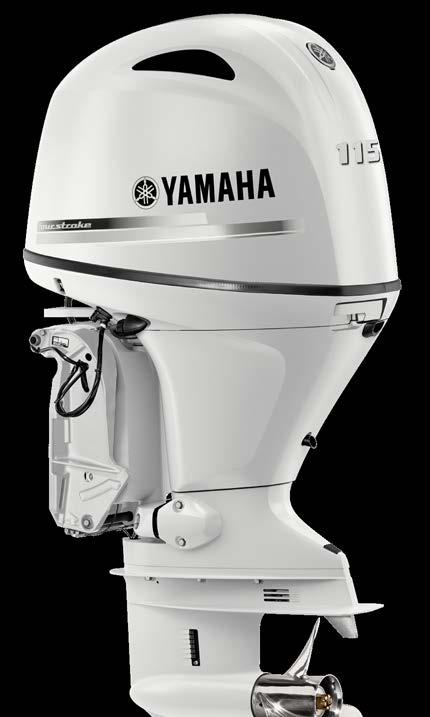
*Finance to approved personal applicants or commercial applicants with a registered valid NZBN (excludes fleet, government and rental buyers). Weekly repayments are the monthly equivalent of: (A) $264 for a F40LA $11,663 RRP including GST; (B) $300 for a F60LB $13,403 RRP including GST; (C) $343 for a F70LA $15,243 RRP including GST; (D) $414 for a F90LB $18,773 RRP including GST; (E) $462 for a F115LB $21,013 RRP including GST. Offer is based on an interest rate of 9.95% over a 5-year loan term with a $395 application fee and $8.05 PPSR fees. Finance is provided by Yamaha Motor Finance New Zealand Ltd. (YMF) NZBN 9429036270798 FSP 9622. Offer is subject to YMF’s credit and lending criteria. Unit price advertised includes